- Articles and Guides

The Best Boats to Live On Full Time
14th feb 2023 by samantha wilson.

Choosing to live on a boat is a big and exciting step. Yet leaving behind the comforts of bricks and mortar (and the space they offer) for a more unorthodox lifestyle is something that more and more people are choosing to do. With the increased cost of living, especially in big cities, as well as the trappings of daily life, there is an increasing number of people who are opting to simplify their lives and move onto the water. We have looked at the pros and cons of living on a boat in a previous article, but here we take a look at the different styles of liveaboard boats and the best boats to live on year round.
So what are the options when it comes to living on a boat? From static houseboats to easily movable sailboats and a whole lot in between, the options are getting more creative, designer-led and spacious.
Ultimately, you can live on almost any boat. You might find it cramped, but it’s doable. Much of the decision will come from how you want to live, whether you’re looking to stay on a residential mooring in a water community close to your place of work and social life, or sail the seven seas (or the option to do both).

Types of Liveaboard Boat
The classic sailboat comes in all manner of shapes and sizes. They are the essence of ocean-going freedom, economical both in their purchase price and travel costs (wind power is free!), and ready for adventure. Finding a berth is usually easy and affordable, or they can be easily moored on anchor. On the downside, sailboats lack space, and many smaller models won’t have showers or hot water. You’ll need to consider size carefully, both for operational reasons – can you sail it single-handedly if needed? – but also keep in mind that running costs rise with size.
- Economical both to buy and maintain
- Finding a berth is easier than for larger houseboats
- It can be moved easily or sailed around the world
- Space is limited for both people and equipment
- They can lack the mod cons of larger houseboats
The Best Sailboats to Live on
Whether you’re looking for a new or used sailboat, there are thousands to choose from. Picking the best ones is impossible, but we are particularly fond of the following:
Catalina 38
The much-loved Catalina 38 sloop was in production from 1978 to 1999 and so there are many of these models on the used boat market. They make for a comfortable boat for a couple to live on, with plenty of well thought-out features from electrical outlets to a compact but well-equipped galley. Space will always be tight, but for a cozy cruiser bound for adventure the Catalina 38 is a great choice.
Another classic sailboat that has its origins in the 1970’s is the Hunter 33 , an aft-cockpit sloop, which was in production until recently, showing its immense popularity. The 33 foot sailing yacht offers lots of interior space, with a full dinette, head and shower, and master cabin, and all of it with standing room height. The galley is packed with storage lockers, and the entire décor is contemporary and comfortable creating the feel of a real home.

Photo credit: Marlow-Hunter
Peterson 44
Slightly larger than the other two n the list is the Peterson 44, a double-spread cutter, which offers plenty of living space whether you’re cruising or predominantly residential. Ideal for a small family, it is both affordable on the used market and packed with home comforts such as a shower, galley with oven, fridge and freezer, three cabins and a practical center cockpit.
If you’re looking for a full suite of amenities such as a house-sized kitchen and bathroom, plus oodles of extra living space then a multi-hull – catamaran or trimaran - makes for an excellent ocean-going liveaboard. The bridge between the hulls creates a light and airy above-water living space, with the bedrooms tucked into the hulls. They are also more stable than monohull boats, so for those with a delicate stomach in a high sea, these are becoming increasingly popular. Multi-hull boats tend to cost more to purchase, and because of their width will also incur higher berthing costs, so this is something to take into account.
- Lots of space compared to monohull yachts
- Full sized kitchen and bathroom
- Offer a stable ride
- Cost more than monohull yachts to buy
- More difficult and costly to find berths as they are much wider
The Best Catamarans to Live on
Catamaran sales, both of motor and sail models, are booming, especially with those looking to live on them full time. The extra space afforded by the double width beam is unparalleled in a monohull, and they are renowned for their stability. Here we take a look at some of our favorite models:
Privilege 435
Launched in 1999, the Alliaura Marine Privilege 435 is one of the most comfortable and spacious cats out there for its size. No expense has been spared when it comes to the finishings, and it has a really elegant and luxurious feel. Many of the ones you find on the used market were built more recently however, and so they come with the latest technology, navigational and safety equipment. With four bedrooms thanks to the iconic central ‘hull’ (which doesn’t tough the water) creating more space, it truly is a home on water, but its sturdy construction allows for long-range near coastal cruising too.
This new model from catamaran specialists Lagoon sits in the middle of their range of 40 to 55 feet luxury catamarans offering the ultimate in comfort and space but still compact enough for easy handling and mooring. Based on the groundbreaking 50, the Lagoon 46 manages to pack all the amenities in (we’re talking a huge, light-filled galley and dining room with wrap around windows, three cabins with a plush master suite in the starboard hull, and a luxurious amount of deck space).

Photo credit: Lagoon Catamarans
Fountaine Pajot Saba 50
It’s hard to choose from Fountain Pajot’s huge range of sailing and motor catamarans as they are some of the best and most luxurious on the market both in terms of performance and liveability.
Trawlers are a unique type of powerboat designed for long distance cruising and perfectly suited to living on full time. While their origins can be traced back to commercial fishing boats – and there are plenty of these full- displacement, ballasted hull models still in operation - modern trawlers are a very different animal. Wide hulls, less draft, more below-deck headroom and plenty of space for mod cons make these a hugely popular choice. You’ll find full-sized kitchens, showers, and multi-level living space, especially on the larger models. In fact, they don’t even need to be that much longer – a 35-foot trawler is much roomier than a 35-foot sailboat, for example.
- Oodles of space for the length
- Ultra-luxurious designs
- Compact for easy berthing
- The initial purchase costs are high
- More costly to run than a sailboat
The Best Trawler Yachts to Live on
New and converted trawlers are cropping up everywhere, and the modern designs are a far cry from the fishing vessels they once were. Décor is often penthouse chic, bringing cosmopolitan living to the open ocean. Here are some of our particular favorites.
Grand Banks 60
Grand Banks have taken the humble trawler and transformed it into a long-range cruiser with the luxury of a small superyacht and the spaciousness of a houseboat. The GB 60 is the epitome of what they’ve created, with an impressive cruise speed of 22 knots and a range of over 2000 nautical miles. Combine that with a luxurious, fully customizable interior, oodles of high tech, and their signature deep V hull for a smoother, faster ride and it’s the winning combination.

Photo credit: Grand Banks
Beneteau Swift Trawler 48
Whether you want to cruise to the far flung corners of the world or live comfortably at anchor, Beneteau’s range of Swift Trawlers offer their signature elegance and power. Imagine a plush central living space and wheelhouse with panoramic views, huge amounts of storage space, stylish cabins and a powerful, reliable, and efficient engine.
Ranger Tugs R-43
Ranger Tugs specialize in high quality vessels which are more affordable than most trawlers on the market. While you can pick up a brand new R-23 for $115,000, it might not be quite big enough to live on. Enter the R-43. Built by hand in the US it has a beautiful, light-filled interior perfect for families or friends to spend time together, as well as two cozy cabins each with en-suite shower rooms. You’ll also find a chef’s galley, laundry room, wrap-around decks and a suite of tech including twin Volvo IPS drives, joystick driving and docking, and a state of the art Garmin 22” navigation suite.
Moving on to a life on the water doesn’t have to be about cruising the great oceans. The joy of waking up to the sounds of birds chirping and the gentle slap of water on the hull, or of connecting to nature and living a simple life is just some of the appeal of living on a boat year round. Swapping sea-worthiness for space is a huge trade-off, and there are many different types of static or houseboats which offer a more residential feel.
Non-powered houseboats are a true home-on-the-water. A steel floating pontoon supports a mobile home type structure on the top, providing large amounts of living space, big windows, and all the amenities and home comforts you want. They can be towed from place to place, but are otherwise static in a residential community along rivers, lakes, sheltered bays and inland waterways. With municipal utilities, cable television and broadband internet connections, they give you the best of both worlds.
Powered houseboats are self-propelled residential vessels which come in many guises and make for a top choice of liveaboard. While some will be limited in the distance they can travel and be more reminiscent of the static houseboats, others have plenty of cruising power and are ready for coastal adventures. With a squarer silhouette, powered houseboats can accommodate an impressive amount of living space for their length.
- Attractive pricing compared to ocean-going yachts of the same size
- Huge amount of interior space with all the comforts of a home
- Creative interior design styles
- Extremely popular so finding a residential berth can be difficult
- Not designed for long-range cruising
- Some can only be towed and aren’t powered
The Best Houseboats to Live on
Architects have unleashed their imaginations with a new range of luxurious, creative and innovative designs for static houseboats and powered houseboats, which push the boundaries of water living with floor-to-ceiling windows, roaring fireplaces and rooftop hot tubs. Here are some of our top picks:
American Houseboat ‘The Zion’
Resembling a true house floating on water, these are the quintessential all-American houseboats. Measuring 14 x 14 feet, the two bedroom boats have an extra loft area and can accommodate up to eight guests. With big windows to let in the natural light, a full kitchen, and a huge private deck off the master bedroom you get home comforts with all the joys of being on the water.
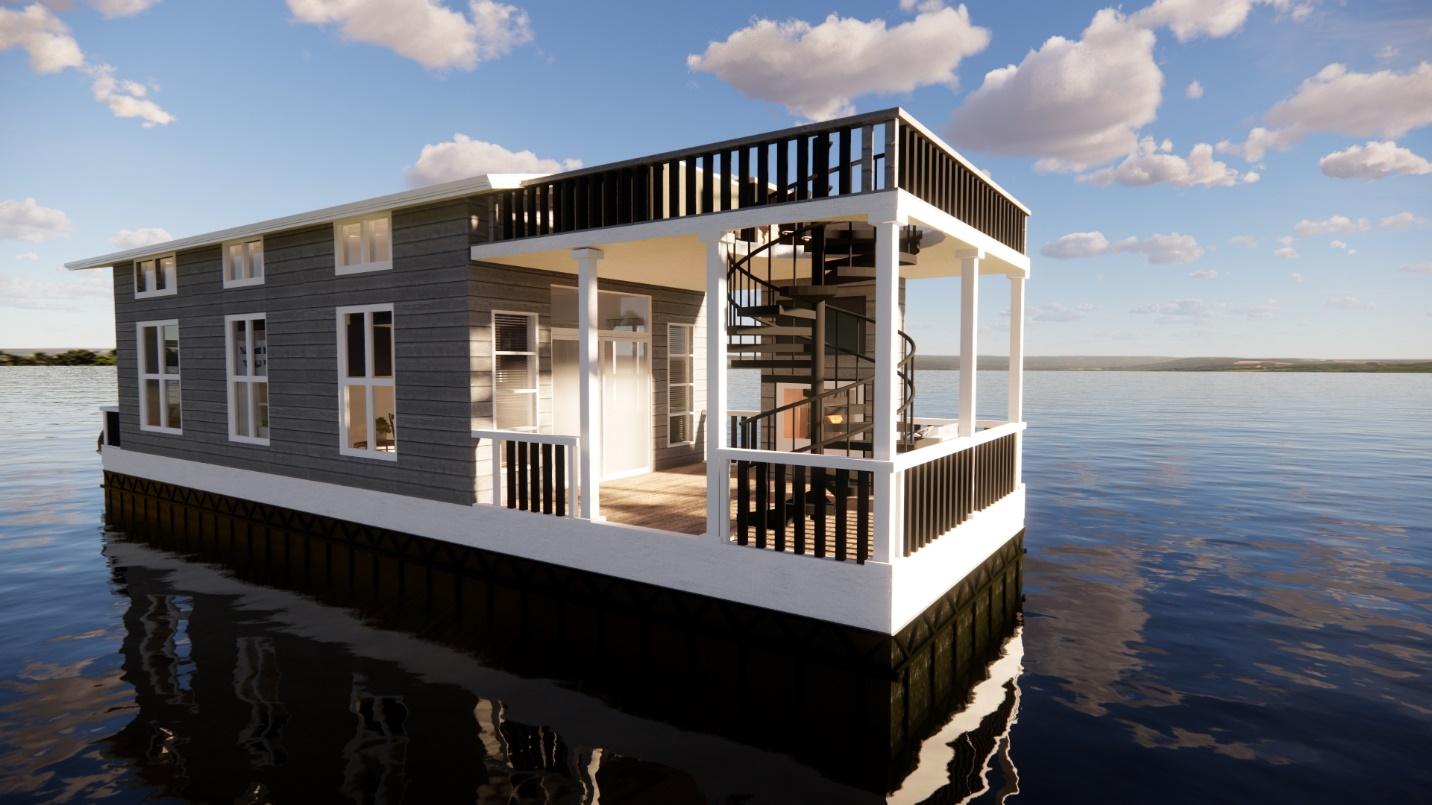
Photo credit: The American Houseboat
Gibson Cabin Yacht 5000
Gibson Boats are a major player in the houseboat industry and their Gibson Cabin Yacht 5000 is one of our favorites. It combines affordability (and there are several to be found on the used market) with spaciousness and reliability. You’ll find two or three double bedrooms, carpeting throughout, high quality electrical appliances including air conditioning and heating, and two full bathrooms including a tub.
Bravada Yachts Atlas V-Series
Calling the Atlas V-Series powered houseboats seems somehow wrong. They are much more than your average houseboat, a sleek and versatile ocean-going vessel designed for living on in ultimate luxury. With a futuristic silhouette, vast windows, two floors and every home comfort you can imagine (including a fire pit and rear waterslide), they have taken living on the water to whole new levels.
Photo credit: Bravada Yachts
- Living on a Sailboat: Is it Right for You?
- Life on the Water: Living Aboard a Trawler Boat
- The Best Types of Boat to Live on After Retirement
- Sleeping on a Boat: Tips for Overnight Stays
- Types of Houseboats: Different Home Styles for Living on the Water
- Is Living on a Boat Right for You? The Pros and Cons of Living on a Boat
Written By: Samantha Wilson
Samantha Wilson has spent her entire life on and around boats, from tiny sailing dinghies all the way up to superyachts. She writes for many boating and yachting publications, top charter agencies, and some of the largest travel businesses in the industry, combining her knowledge and passion of boating, travel and writing to create topical, useful and engaging content.

More from: Samantha Wilson
Related Articles and Guides

19th Jul 2024
The World’s Best Yacht Brands
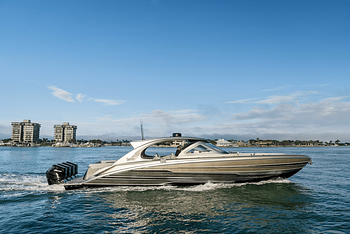
12th Jul 2024
Top Performance-Boat Brands, Where There’s Something For Everyone
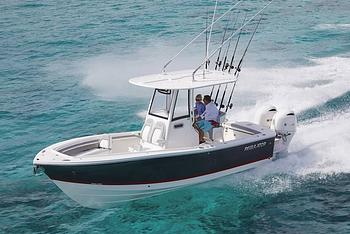
28th Jun 2024
Best Center Console Boats: The Best Brands Across the Spectrum
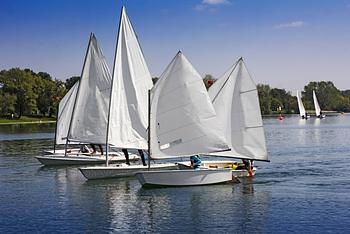
23rd Jun 2024
Small Sailboat Types: Sail Smaller and Savor It All
- Explore Rightboat
- Boats for Sale
- Boating Articles
- Buyers Guide
- About RightBoat
- Sell Your Boat
- Boat Selling Advice
- All manufacturers
- All categories
Enter your email to keep up to date with the latest news
Join for free
Sign up now for free and discover how easy it is to keep up to date with THE latest boats for sale. Find your right boat, and tailor your voyage to finding your next boat.
Benefits of becoming a member:
- Set up tailored alerts
- Personalise your experience
- Download full specifications and broker details
- Keep tabs on your favourite boats
Are you a broker? Join as a Broker
Rightboat - join for free.
Do you have an account already? Login
Save this search
Save your search and receive new boats in your email..
You can unsubscribe from your alerts whenever you like. By pressing the button you accept the Legal Terms and conditions
- Living the dream: Exploring the best boats to live on
Living on a boat is a dream for many. The gentle rocking of the waves, the serenity of sunrises and sunsets over the water, and the freedom to explore new horizons are alluring prospects. However, choosing the right boat is essential to ensure your liveaboard experience is comfortable, safe, and enjoyable.
Factors to consider
Selecting the best boat to live on involves considering various factors, including size, layout, budget, and intended use. Whether you're drawn to the sleek lines of a sailboat or the power and space of a motor yacht, your decision should align with your lifestyle and preferences.
Living aboard: Pros and cons
Living on a boat comes with its pros and cons. While the tranquility of the water and the ability to travel to new destinations are definite perks, challenges like maintenance, space limitations, and weather considerations should also be acknowledged.
Customizing your living space
Personalizing your boat's interior is part of the joy of living aboard. Adding unique decor, optimizing storage, and incorporating creature comforts can transform your vessel into a true home.
Practical considerations
Living on a boat requires adaptability. From provisioning and waste management to maintenance and safety procedures, being well-prepared is essential for a successful liveaboard experience.
Read our top notch articles on topics such as sailing, sailing tips and destinations in our Magazine .
Benefits of living aboard
The benefits of living on a boat are vast. You'll enjoy a closer connection to nature, the ability to change your surroundings at will, and the sense of community among fellow liveaboards.
Challenges to anticipate
While boat living offers many rewards, it also presents challenges. Limited space, maintenance responsibilities, and weather-related concerns are aspects that require careful consideration.
Making the dream a reality
Turning your dream of living aboard into reality involves careful planning and preparation. From researching legalities and finding the right marina to downsizing your possessions, every step brings you closer to your floating lifestyle.
Luxury yacht
Selecting the ideal vessel
When choosing a boat to live on, consider your desired lifestyle, the number of occupants, and the areas you plan to explore. Research different makes and models, attend boat shows, and consult with experts to make an informed decision.
Sailboats for cozy living:
- Monohulls: Classic sailboats with efficient use of space and comfortable cabins.
- Small catamarans: Dual-hulled vessels providing stability and a close connection to the water.
Luxurious liveaboard yachts:
- Motor yachts: Spacious interiors, advanced amenities, and luxurious living spaces.
- Sailing yachts: Combining elegance and performance, these yachts offer both comfort and adventure.
Efficient trawlers for extended cruising:
- Trawlers: Fuel-efficient vessels with long-range capabilities, suitable for exploring distant waters.
Spacious catamarans for comfort:
- Large catamarans: Dual-hulled boats that offer stability, ample living space, and enhanced comfort.
Versatile power catamarans:
- Power catamarans: Efficient motor-driven vessels with the stability of catamaran design, perfect for long-term living.
Classic houseboats:
- Houseboats: Customizable floating homes with spacious layouts and a variety of amenities.
Custom-built expedition yachts:
- Expedition yachts: Purpose-built vessels designed for extended voyages, equipped with essential features for self-sufficiency.
Vintage schooners and clippers:
- Vintage sailboats: Restored classics with traditional charm, offering a unique and nostalgic living experience.
Riverboats for tranquil living:
- Riverboats: Designed for inland waterways, these boats provide a peaceful living environment along scenic rivers.
Converted fishing vessels:
- Converted fishing boats: Repurposed vessels transformed into comfortable liveaboard homes with a touch of maritime character.
Life on a boat is a daily adventure.
Top boat choices for comfortable living aboard
Beneteau Oceanis 50: A spacious monohull sailboat with comfortable accommodations and modern amenities.
Lagoon 450: A luxurious catamaran known for its stability, spaciousness, and exceptional living areas.
Nordhavn 52: A trawler yacht designed for long-range cruising, offering a comfortable and self-sufficient lifestyle.
Grand Banks 60: A classic trawler yacht with a timeless design, well-suited for extended cruising and liveaboard living.
Fountaine Pajot MY 40: A power catamaran featuring contemporary design and efficient living spaces for a comfortable life at sea.
Hanse 548: A stylish and performance-oriented sailing yacht with ample interior space and modern amenities.
Leopard 45: A popular catamaran choice for liveaboard enthusiasts, offering a balance of comfort and adventure.
Selene 59: An expedition trawler yacht built for world cruising, providing a safe and luxurious environment for extended stays.
Monte Carlo Yachts 70: A luxury motor yacht designed for both performance and comfort, with opulent interiors and expansive living areas.
Chris-Craft Corsair 34: A stylish powerboat with elegant design and comfortable amenities, suitable for coastal living.
So what are you waiting for? Take a look at our range of charter boats and head to some of our favourite sailing destinations .
FAQs about living on a boat
Best Liveaboard Boats to Live On Full-Time
Living on a boat represents a significant and thrilling life choice . Departing from the comforts of traditional dwellings and the spaciousness they provide in favor of an unconventional lifestyle is an option that an increasing number of individuals are embracing. Escalating urban living costs, particularly in major cities, coupled with the daily routines of life, have led more people to seek a simplified existence on the water . A previous article examined the merits and drawbacks of residing on a boat. This piece delves into the diverse range of liveaboard boat styles. It identifies the most suitable Boats to Live On for year-round living.
Options for Living on a Boat Full-Time
Best Liveaboard Boats encompass a broad spectrum of possibilities. From stationary houseboats to highly maneuverable sailboats and an array of options, the choices continue to expand with innovative , designer-driven , and spacious vessels .
Ultimately, practically any boat can serve as a domicile. While some may find the space restrictive, it remains feasible . The decision largely hinges on one's preferred lifestyle, whether residing in a water-based community near work and social circles or embarking on seafaring adventures worldwide.
Types of Best Liveaboard Boats
Sailboats for full-time living.

Sailboats, available in various shapes and sizes, epitomize the essence of maritime freedom. They offer an economical means of purchase and travel, as wind power is free . Moreover, finding a berth for a sailboat is generally easier and more affordable than larger houseboats. On the downside, sailboats often have limited space, and smaller models may lack showers or hot water. Size considerations, such as single-handed sailing capability and budgetary factors , are crucial for operational feasibility , as larger sailboats tend to incur higher operating costs.
Sailboats are known for their:
Economical purchasing and maintenance costs. Ease of finding berths compared to larger houseboats . Versatility in terms of mobility. However, they may need more conveniences of larger houseboats and have limited space.
The Best Sailboats to Live On
Whether one seeks a new or used sailboat, the options are vast . While identifying the absolute best sailboats may prove elusive, some standout choices include:
Catalina 38

Produced from 1978 to 1999 , the Catalina 38 sloop offers a comfortable living space for couples. Its thoughtful features, from electrical outlets to a well-equipped galley, provide a cozy cruising experience. Despite limited space, the Catalina 38 is an excellent choice for adventurous living.

Originating from the 1970s, the Hunter 33 , an aft-cockpit sloop, enjoys enduring popularity. With ample interior space, including a full dinette , head , shower , master cabin , and standing room height , this sailing yacht offers comfort. It boasts a contemporary design and a homely atmosphere.
Peterson 44

Slightly larger than the previous options, the Peterson 44 is a double-spread cutter that caters to various living needs. Ideal for small families, it combines affordability with home comforts like a shower , galley with oven , fridge , freezer , three cabins , and a practical center cockpit .
Catamarans for Full-Time Living

For those seeking an ocean-going liveaboard with extensive amenities, including a house-sized kitchen and bathroom , multi-hull boats like catamarans and trimarans excel. The bridge connecting the hulls creates a spacious, well-lit living area above water, with bedrooms within the hulls . These boats offer enhanced stability compared to monohull vessels. However, their higher purchase and berthing costs warrant consideration.
Catamarans are prized for their:
Abundance of space relative to monohull yachts . Full-sized kitchen and bathroom facilities. Enhanced stability in rough seas . Nevertheless, they tend to incur higher acquisition and berthing expenses due to their wider dimensions.
Read also this : Best Catamaran Fishing Boat Brands
The Best Catamarans to Live on
The catamaran market, encompassing motor and sail models, thrives, particularly among Boats that Live On Full-Time liveaboards. Notable models include :
Privilege 435

Founded in 1999, the Alliaura Marine Privilege 435 impresses with its comfort and spaciousness. Its luxurious finishings , latest technology , and navigational equipment create an elegant and homely atmosphere. Featuring four bedrooms and the iconic central 'hull' for added space, it accommodates a range of activities, from living to coastal cruising.

Situated within the Lagoon's range of luxury catamarans, the Lagoon 46 offers comfort and ample space while remaining compact for ease of handling and mooring. It boasts a spacious galley and dining area with abundant natural light , three cabins , a plush master suite , and a generous deck space .
Trawlers for Full-Time Living

Trawlers represent a unique category of powerboats designed for long-distance cruising, ideally suited for Living on a Boat Full-Time . Evolving from their origins as commercial fishing vessels, modern trawlers differ significantly. They feature wider hulls, reduced draft, increased below-deck headroom, and more space for modern amenities. Trawlers often include full-sized kitchens, showers, and multi-level living areas, especially on larger models. Despite potential initial costs and higher operational expenses , their roominess makes them a preferred choice.
Trawlers offer the following advantages:
Ample interior space relative to length . Luxurious designs are akin to penthouses. Compact dimensions for straightforward berthing. However, they typically involve higher initial purchase and operating costs than sailboats.
The Best Trawler Yachts to Live on
Modern newly built or converted trawlers showcase innovative designs and luxurious features. Notable examples include :
Grand Banks 60

Grand Banks has transformed the humble trawler into a long-range cruiser with the luxury of a small superyacht. The GB 60 combines impressive cruise speed , a customizable interior , advanced technology , and a signature deep V hull for a smoother , faster ride .
Beneteau Swift Trawlers 48

Beneteau's Swift Trawlers offers elegance and power , ideal for comfortable living at anchor or long-distance cruising. They feature a central living space with panoramic views , abundant storage , stylish cabins , and efficient engines .
Ranger Tugs R-43

Ranger Tugs specializes in high-quality, affordable vessels. The R-43 boasts a light-filled interior , two cozy cabins with en-suite shower rooms , a chef's galley , wrap-around decks , and advanced tech features , making it suitable for families or friends seeking a shared living experience.
🚀Recommended article: Types of Boats With Cabins: A Comprehensive Overview
Houseboats for Full-Time Living

Transitioning to life on the water need not entail traversing vast oceans . The allure of awakening to birdsong and the gentle lapping of water against the hull, or reconnecting with nature and embracing a simpler existence, is at the heart of year-round boat living. Sacrificing seaworthiness for space leads to various types of static or houseboats that offer a more residential ambiance.
Non-powered houseboats featuring a steel floating pontoon supporting a mobile home-style structure deliver spacious living areas, large windows, and all the comforts of home. While they can be towed, they typically reside in residential communities along rivers, lakes, sheltered bays, and inland waterways . These houseboats often provide municipal utilities, cable television, and broadband internet connections, offering the best of both worlds.
🚀Recommended article: Exploring the Most Popular Types of Lake Boats
Powered houseboats are self-propelled residential vessels available in various configurations. While some are suitable for shorter journeys and resemble static houseboats, others possess substantial cruising capabilities . Their squared-off silhouette accommodates ample living space relative to their length.
Houseboats are esteemed for their:
Affordable pricing compared to ocean-going yachts of similar size. Abundant interior space with home comforts. Creative interior design possibilities. Securing a residential berth for houseboats can be challenging due to their popularity ; some are exclusively towed rather than powered.
The Best Houseboats to Live on
Innovative architects have introduced a range of luxurious , creative , and imaginative designs for static and powered houseboats . These designs incorporate floor-to-ceiling windows , roaring fireplaces , and rooftop hot tubs . Some noteworthy choices include:
American Houseboat 'The Zion'

Resembling a house floating on water, these quintessential all-American houseboats measure 14 x 14 feet , providing two bedrooms with an additional loft area for up to eight guests. Featuring ample windows , a full kitchen , and a spacious private deck off the master bedroom , they combine home comforts with the joys of waterfront living.
Gibson Cabin Yacht 5000

Gibson Boats' Cabin Yacht 5000 combines affordability with spaciousness and reliability . It offers a comfortable and well-equipped living space with two or three double bedrooms , carpeting , high-quality electrical appliances , air conditioning , heating , and two full bathrooms .
Bravada Yachts Atlas V-Series

The Atlas V-Series powered houseboats redefine traditional notions of houseboat living. With futuristic silhouettes , expansive windows , two floors , and an array of home comforts , including a fire pit and rear waterslide , they elevate water-based living to new heights.
In conclusion, choosing the ideal liveaboard boat depends on individual preferences, budgetary considerations, and lifestyle goals. Sailboats offer economical and adventurous living , catamarans provide spaciousness and stability , trawlers deliver luxurious long-range cruising , and houseboats offer diverse options for embracing life on the water. Each vessel type presents unique advantages, catering to those seeking unconventional, waterborne lifestyles.
Frequently Asked Questions About Living on a Boat
Is living on a boat more affordable than a traditional home, do i need special skills to live on a boat, can i live on a boat with a family, how do i secure a mooring spot for my boat, are there any legal restrictions on living aboard a boat, can i work remotely while living on a boat, what kind of boat can you live on, how big should a boat be to live on, which boat is the strongest, can you really live on a boat.
Was this page helpful?
Save my name, email, and website in this browser for the next time I comment.

My Cruiser Life Magazine
10 Great Sailboats to Live In For Full Time #BoatLife
There is an undeniable romanticism to the idea of living on a sailboat. Liveaboard sailboats speak to traveling the world, living a slow but rewarding life while going wherever the wind takes you.
Non-boaters are often lured into the lifestyle thanks to online influencers and postcard-perfect voyaging photos. But living on a boat can be challenging, and the wrong boat can make you downright miserable.
No matter what you plan to do with your boat, if you plan to move aboard and live on it, you’ll want to spend some serious time considering your choices. Some boats are much more comfortable than others.
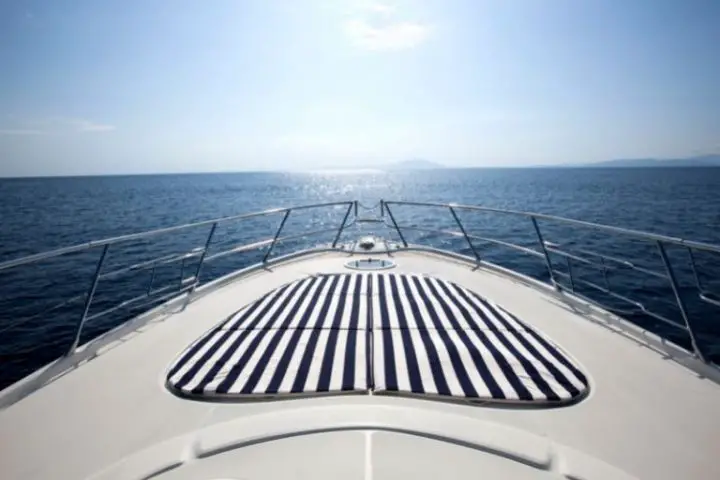
Table of Contents
Setting goals for you and your boat, features to look for living aboard a sailboat, coastal cruisers vs bluewater boats, monohulls vs catamarans, are you sure a sailboat is right for you, 10 great sailboats for living aboard.
A wise person once said no single boat has ever been built that was good at everything. Therefore, an essential first step in any boat purchase is to identify precisely what you are really going to do with this boat.
Here’s an example scenario. John, a fictional but accurate sailor, dreams of sailing the “Milk Run” to Tahiti one day. He doesn’t have a way to accomplish this right now because he has a career and bills to pay. But he wants to buy a boat to learn to sail on while he lives at a dock. So the question is, should he buy a boat that can safely and comfortably get him to Tahiti? Or should he save money by buying a smaller, simpler boat that he can live on and sail on his home bay?
There are pluses and minuses for both possibilities. If John buys his big “bluewater baby,” he’s going to spend a lot of money on a dream that he may never achieve. But, on the other hand, he can probably find a perfectly capable live aboard sailboat that will be more fun on his local waters for a quarter of the price of that “bluewater baby.”
If he can save up, retire, and sail off, he’ll probably have figured out a lot more about sailing and make different choices anyway. Few people keep boats for the long haul, they often find that they value designs or features they were completely unaware of when they made their first boat purchase. There are many choices in boating, and it takes years for the best of us to figure out what it is we want.
The point is don’t buy the boat for the “maybe someday” trip of a lifetime until you have an actionable plan to take that trip. Instead, look at what you really will be doing with the boat, and then buy the best boat you can find for that purpose.
Not all live aboard sailboats are created equally. Some have an aft cabin that is a little more than a glamorous camping tents. Others are palaces of beautiful teak and mahogany joinery, filled with everything needed to keep the crew safe and sound as they circumnavigate the globe.
For now, let’s focus on the single aspect of living aboard. Here are a few of the things you want to take a hard look at when evaluating different vessels.
You do not want to live in a boat that you cannot stand up in. For tall individuals, this might mean you have to look far and wide if you’re shopping for smaller vessels. People over about 6’2″ are going to have the most trouble. But keep looking. Hitting your head repeatedly gets very tiresome.
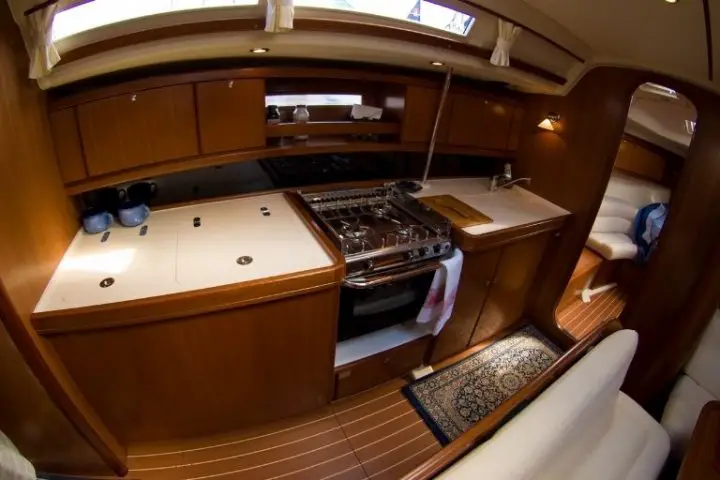
Electrical System
As a liveaboard, you’re going to use your electrical system constantly. Don’t buy a boat with a shoddy electrical system . Electrical fires are one of the most common sources of boat and marina fires. Make sure your surveyor pays extra attention during the survey. You need to have a safe and up-to-standards 120VAC shore power connection. You’ll use this all the time to run basics like your cooking appliances, heaters and air conditioners, and water heater.
Ventilation
Ventilation is essential on boats. It not only provides fresh air for the occupants, but it keeps the air moving in a damp and sealed environment. Without airflow, mold and mildew will quickly take over. Lockers and doors should have vents in them, and there should be deck vents that let the air down below.
Climate Control
Many boats do not have air conditioning or heating appliances. It can be tempting to pass since the point of a boat is to disconnect a little. But living on a boat without these luxuries is nearly impossible in most parts of the world. If you’re going to stay at anchor most of the time, you may be able to get away without AC. But if you’re going to spend any time at a dock, air conditioning is simply a must-have item for most people.
Two things should be noted here. First, most people wind up spending more time at docks than they think they will, so the air conditioner becomes more critical later on. Secondly, air conditioners are costly to install in a boat. Buy a boat with AC installed, and you will never regret it. Buy a boat without it, and you might be very hot, aggravated, and regretful.
Overall Comfort
Look for boats with comfortable living spaces. There are a lot of boats out there that look great in brochures. They have tons of places to sit, tables to work at, or lounges to sun on. But in practice, all of these places are uncomfortably shaped because they are wedged into the boat and have funny angles. Boat makers aren’t interested in making boats that people will live on—they’re interested in making boats that will sell. So the emphasis is usually put on looking good in photos, not necessarily on what is practical.
Unless you live alone and plan to stay that way, most boats benefit from some level of privacy. Remember, the smallest boats might not even have a bathroom door! However, larger boats are built with the idea of carrying more people—so you will more likely have private staterooms and more places to get some personal space.
Most boaters prefer to use the marina’s showers or get a gym membership. But having a dedicated shower on your boat is much more convenient, even if you only use it occasionally. Boats typically have a dedicated shower stall or what is known as a “wet-head.” The wet head is a shared space with the sink and toilet that can be closed off and used as a shower. Sometimes these are larger spaces and work nicely. Other times, it’s a lot of trouble to keep everything dry.
Waste System Capacity and Functionality
Again, many boaters prefer to use the shoreside facilities when possible. But a liveaboard boat needs to have a safe and legal way to contain waste. The holding tank’s size is of extra interest since a small tank may mean frequent trips to the pump-out dock. Also, pay attention to the type of system that is installed—is it the old-style hand pump toilet or an electric flush model?
Some liveaboards like using compact composting toilets. The choice is yours, but you’ll be living with it and maintaining it more than you can imagine until you own your first boat. Keeping it simple and functional is the priority.
Functional Galley
Much like the rest of the boat, boat builders don’t think too much about their galleys’ actual use and functionality. You need one with adequate cabinets and storage space, an easy-to-access fridge, and space on the countertops to cook.
Most boats come with thin, cheap cushions on the bunks. If you’re going to liveaboard, you need to upgrade your boat beds and get a real mattress. Boat mattresses have all sorts of angles and curves in them to maximize storage space, so it’s not easy to just buy a new one. A custom-cut spring boat mattress will cost thousands of dollars, but you can get a nice memory foam mattress and cut it to fit for a few hundred.
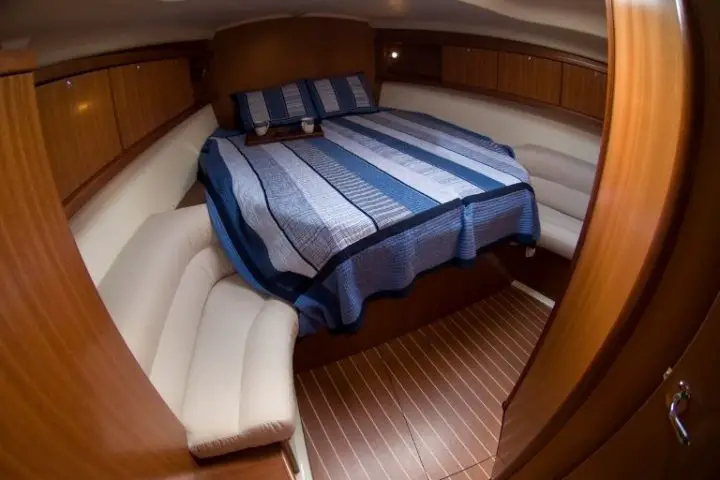
In the liveaboard sailboat world, there is a special allure to the bluewater sailboat . Like our fictional sailor John above, many folks dream of setting sail for distant lands.
What exactly makes a “bluewater” sailboat is something of a controversial topic. However, most sailors would point to design like heavy displacement, a comfortable ride and good performance in heavy weather, and robustness of construction not found in most production vessels.
Most things that differentiate a coastal cruiser from a bluewater boat don’t make much difference for living aboard. But many newer coastal cruisers feature wide-open cockpits, low swim-step transoms, and large companionway doors that would not be considered classically “bluewater.” But these features can make a massive difference in the liveability of the space and your overall comfort.
Only one thing is sure—bluewater liveaboard sailboats cost significantly more than regular coastal cruisers. So if you’re not planning ocean passages, you can get a lot more boats for your money by buying a well-equipped coastal cruiser.
An excellent resource for comparing bluewater sailboat designs is Bluewaterboats.org.
When it comes to purely living aboard, there is no doubt that a cruising catamaran is one of the most comfortable vessels you could choose. They feature an insane amount of living space, and it usually features open patios and salons that are perfect for living and entertaining.
Catamarans are, however, larger and more expensive than monohulls. A few older designs of small catamarans are on the market, some of which are incredibly seaworthy and interesting. But these cheaper catamarans are much closer to living on an uncomfortable monohull than on a beamy and airy charter catamaran.
How Small Is Too Small?
Famous cruising sailors Lin and Larry Pardy’s classic advice to would-be sailors was, “Go small and go now.” It’s important to realize that if your goal is to travel, the vessel matters less than you think. If you’re anchored in a beautiful anchorage in the British Virgin Islands, does the guy on the new Oyster 75 enjoying his sundowner cocktail more than you on your Albin 30? You’re enjoying the same drink, watching the same sunset, in the same idyllic anchorage.
But there are real size limits, of course. For a full-time live aboard couple, most people would agree that a sailboat in the mid-30-foot range is about as small as they’d like to go. Some very beamy designs, like Island Packets, have models in the low 30s that still provide ample space.
After getting aboard a few boats, most people quickly find what their comfortable range is. Some people love their Bristol Channel Cutters homey 28-foot hulls, while others cannot imagine living in anything less than 45 feet. Both answers are probably on the extreme ends.
Pardy’s case for going small still stands, however. As the length of your boat grows, so too do the bills. Sticking with the smallest boat that you can live on comfortably makes the most financial sense.
How Big Is Too Big?
Everything costs more on a bigger boat—slips, maintenance, parts, haul-outs, fuel, sails, etc. Getting a boat too big will quickly sink your budget. It also becomes psychologically too much to handle—too big for a beginner to maneuver at the dock and too many maintenance issues to wrap your head around.
For this article, we’re limiting our search to only include liveaboard sailboats. But before you go further in your research, consider carefully—is a liveaboard sailboat the right choice for you?
Most people who cruise on liveaboard sailboats end up motoring far more than they had ever imagined. And liveaboard sailboats come with all sorts of limitations on the living space that powerboats do not have. Liveaboard sailboats are generally narrower and less comfortable. They have more space “down below” with only small portlights, while motor vessels are more likely to have big, comfortable salons with picture windows.
If you’re traveling long distances and plan to sail, you do so for the romantic aspects of the act of sailing. Unfortunately, there is very little money saved by using wind power—for every long passage, there is maintenance and upkeep on the rigging and sails. Yes, you only need new sails and rigging every decade if you take care of them. But $10,000 to $20,000 to replace them will buy a slow motorboat a lot of diesel—up to $2,000 annually!
To travel and liveaboard, speed isn’t the question. Not all motorboats go fast. A boat that planes and goes more than about 12 knots is burning so much fuel and has engines so large that it becomes infinitely more expensive than a liveaboard sailboat.
But a displacement trawler uses an efficient diesel motor and burns only slightly more than a similar liveaboard sailboat under power. Thus, for the loss of the sailing ability, the owner gets fewer systems to maintain and far more living space.
So, how badly do you want to sail? Everything in boating is a give and take. Where does the balance lie for you and your crew?
There are so many sailboat designs that no list can be inclusive. They all miss some good ones. The focus here is on designs that have proven themselves comfortable for living aboard. Some are coastal cruisers, and others are truly happy on ocean passages. Some are value-priced “classic plastics,” while others are modern designs that will turn heads at any marina.
Like all the boats, every single design on this list has pros and cons. If there was a perfect boat out there, everyone would be sailing that boat. But there isn’t—we all love different boats for different reasons, and we all value different aspects of their design.
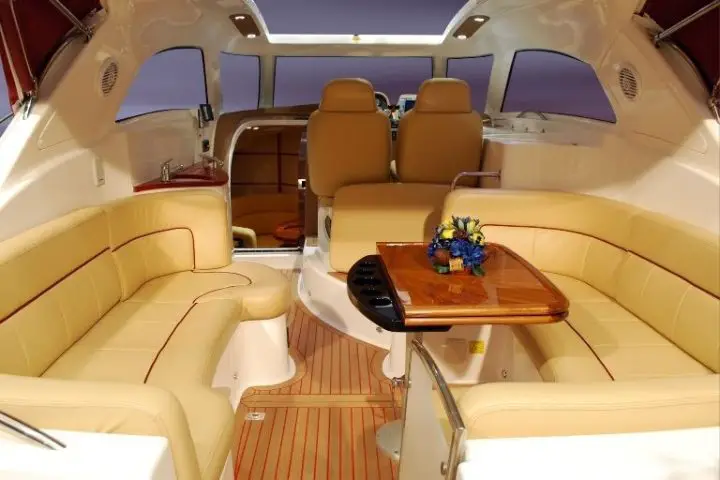
Monohull cruising sailboats have been around for thousands of years. Your search doesn’t need to be that broad, but in the last 60 years, there have been thousands of different designs coming and going. Here’s a look at some boats truly worth a second look.
Island Packet 32 or 320
Island Packets are built with classic features, like a sturdy full keel and a cutter rig. But they are also very beamy, which means a lot of living space in a short-length boat. They also have very shallow drafts compared to other vessels. No matter what size IP you like, expect a boat that feels much larger than its competitors on the inside.
It is also built far better than most other production boats. The 31/32/320 is a popular vessel, and many are available. For more modern features and even more space, check out the 37/370/38/380.
Catalina 30
Probably one of the most popular liveaboard sailboats is the venerable Catalina 30 . This boat is small but packs a tremendous amount of living space thanks to its beamy design. Best of all, the 30 was made for decades, so there are plenty to choose from, and many are available for less than $20,000.
There are plenty of other Catalina models that make great liveaboards too. Some of the 40-plus-foot Catalina Morgan designs are venerable offshore cruisers. But, in general, Catalinas are no-frills nearshore cruisers built for weekend coastal cruising.
Like Catalina, Hunters are coastal cruising production boats. There are lots to choose from, but liveaboards will want to look at those models in the high 30-foot range, like the Hunter 38. Of particular interest is the Hunter 41 or 410.
Beneteau Oceanis 40
Beneteau is the French-made equivalent of Catalina and Hunter—a capable coastal cruiser with plenty of different models to choose from. The most recent two series include the likes of the venerable 423 or Oceanis 40/43. Truthfully, there are so many great designs to choose from on the Beneteau line that you can probably pick any length and come up with a comfortable liveaboard.
Pearson 365
Pearson is a now-defunct production liveaboard sailboat company that put out some great designs. They were wide and tended to have great living space. Like those models listed above, they tend to have a lot of living space. Take a look at the Pearson 365 (ketch-rigged) and the 367 (cutter-rigged).
Islander Freeport 36
Island built strong coastal cruisers in California throughout the 70s and 80s. Many of their best designs came from the drawing board of renowned liveaboard sailboat designer Robert Perry. Some of the best ones included the Islander 36 and the Islander Freeport 36. The Freeport 36 has a gorgeous raised salon and a super comfortable liveaboard layout.
Catamarans offer a tremendous amount of living space, coupled with the spacious feeling of large balcony-like cockpits and huge windows. They cost quite a bit more to purchase and upkeep than the typical monohull, however. They also haven’t been around quite as long, so you are less likely to find older examples to save money on.
Gemini 105MC
The Gemini 105M and 105MC are interesting vessels in that they morph and affordable monohull into a catamaran package. It has a single diesel engine and can fit in most standard marina slips. Yet, it is a shallow draft catamaran that is fun to sail and has a unique living space, including a queen-sized berth and a large bathroom with a shower.
Lagoon is a French-based manufacturer of charter and owner catamarans. They built nearly 1,000 hulls of their most famous model, the Lagoon 380 , over a 20 year period. These cats are wide and spacious, with a unique and beautiful living space. The galley is up, and there are wrap-around windows. Other good liveaboard options include the venerable 440/450, the older 37, and the new 42.
Fountain Pajot Athena 38
Fountain Pajot’s are similar to Lagoons—French-built production catamarans with similar features, sizes, and build qualities. The older FP Athena 38, Lipari 41, or new Lucia 40 are all wonderful liveaboard catamarans.
Leopard makes catamarans in South Africa, and they are the supplier for The Moorings charter company boats. Their earliest models, the 38 and the 42/43 are still some of the most sought-after liveaboard cruising cats around. Newer versions of their 39, 40, and 44 have modern and spacious interior, fabulous for living on.
There are dozens of other South African-built catamarans that make wonderful liveaboards. Often, the same boatyard builds similar designs by different names. For example, the Voyage/Maxim/Norseman 380 is a beautiful, well-built catamaran that makes an outstanding liveaboard. The Admiral 38 or 40 are also stellar boats.
To read more about great liveaboard sailboat manufacturers, read our review of the best sailboat and catamaran manufacturers .
Matt has been boating around Florida for over 25 years in everything from small powerboats to large cruising catamarans. He currently lives aboard a 38-foot Cabo Rico sailboat with his wife Lucy and adventure dog Chelsea. Together, they cruise between winters in The Bahamas and summers in the Chesapeake Bay.
Leave a comment
Your email address will not be published. Required fields are marked *
Save my name, email, and website in this browser for the next time I comment.

- BOAT OF THE YEAR
- Newsletters
- Sailboat Reviews
- Boating Safety
- Sails and Rigging
- Maintenance
- Sailing Totem
- Sailor & Galley
- Living Aboard
- Destinations
- Gear & Electronics
- Charter Resources

10 Best Used Cruising Sailboats
- By John Kretschmer
- Updated: May 24, 2024
The appeal of offshore voyaging is difficult to explain to land people who can’t imagine life without basic human rights like copious quantities of hot water and unlimited data. It can even be challenging to explain to fellow sailors who think the notion of spending days or weeks at sea is a form of waterboarding, some kind of self-inflicted torture.
But for those of us who understand, who relish intimacy with the untamed wilderness that is the ocean and embrace self-reliance and individual expression while accepting the dispassionate whims of Neptune, this is the good life.
There are two essential truths about this life: One, money does not matter. Cruising budgets and lifestyles reflect bank accounts with variously positioned commas; it’s the passages and landfalls that add up, not your investment portfolio. And two, a good bluewater sailboat — not necessarily an expensive boat, but a well-designed, solidly built, imminently seaworthy boat that is only limited by your moxie and imagination — is the key to successful bluewater passagemaking.
– LEARN THE NAVIGATION RULES – Know the “Rules of the Road” that govern all boat traffic. Be courteous and never assume other boaters can see you. Safety Tip Provided by the U.S. Coast Guard
So, to that second point, I’ve compiled a list of interesting and affordable cruising sailboats for serious voyaging. A list of 10 sailboats for any purpose, much less world cruising, is sure to evoke outrage from strong-minded sailors, who by nature tend to be a bit opinionated. Stand by before hurling insults my way, and let me explain. I have decided to stay away from the sailboats we know by heart, the iconic old boats that usually populate a list like this: the Westsail 32, Tayana 37, Shannon 38 and Valiant 40 (the last of which, with a bit of searching, can still be found at or just below $100,000).
My list of some of the best liveaboard sailboats is eclectic and includes a mix of well-known and obscure manufacturers, but all the boats are linked in three ways: All are top-quality vessels capable of crossing oceans. They’re affordable, although in a few cases you have to look for older models in less-than-stellar condition to stay below $100,000. Indeed, in some ways, this list of used sailboats is a function of age; most of the boats were priced at more than $100,000 when new but have dipped below our self-imposed threshold in middle age. And finally, they’re all boats that I have encountered in the past few years in far-flung cruising destinations .
Island Packet 35
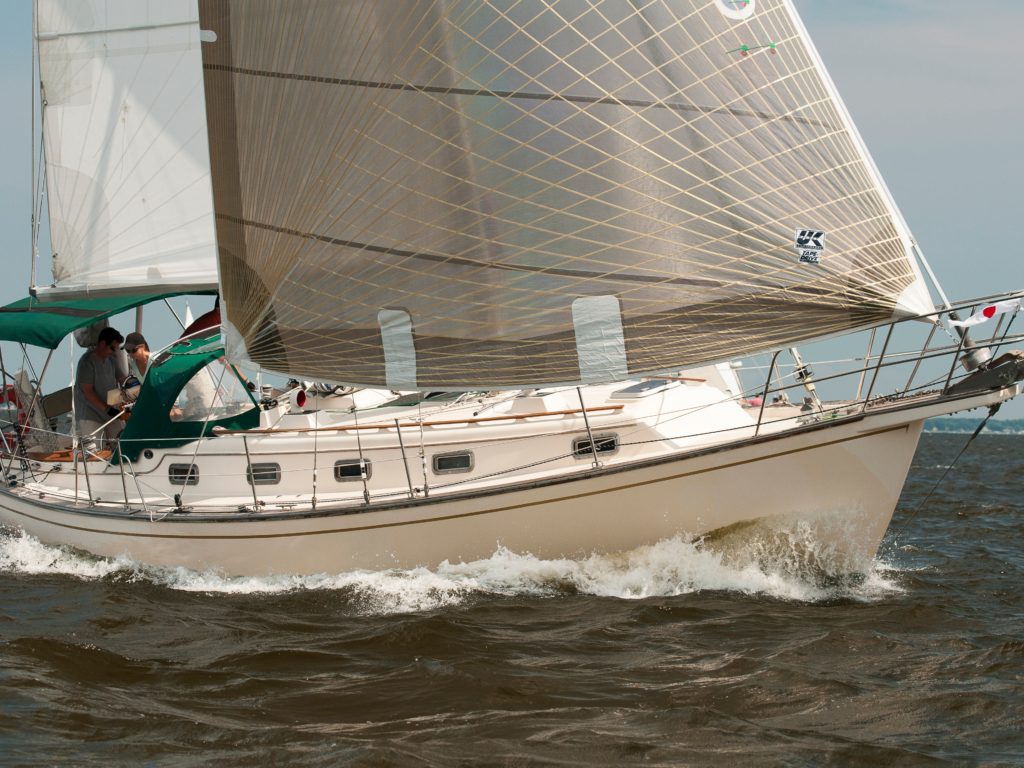
Love them or loathe them, Island Packets are everywhere. To some, the beamy, full-keel, high-freeboard hull designs seem quaint, to put it charitably. To others, the robust construction standards, roomy interiors and overall user-friendliness make them the ideal cruising boat. More than most, sailing vessels are compromises, and Bob Johnson and his crew at Island Packet were brilliant in prioritizing the needs of sailors. The IP 35 was introduced in 1988 and features a huge cockpit, an easy-to-handle cutter rig with a jib boom, and a clever, comfortable interior with the volume of many 40-footers. It might not be the fastest boat upwind, but the long waterline translates to good performance off the breeze, meaning the IP 35 finds its stride in the trade winds. In all, 188 boats were built before production stopped in 1994.
Don’t confuse the IP 35 with the IP 350, which was launched in 1997 and included a stern swim step. You won’t find a 350 for less than $100,000, but you will have a choice among 35s, especially those built before 1990. With two nice staterooms, the 35 is ideal for family cruising. I know of a couple of 35s that have completed the classic Atlantic Circle passage. It’s perfect for a sabbatical cruise because it holds its value and there’s a ready market when it comes time to sell.
Prout Snowgoose 37
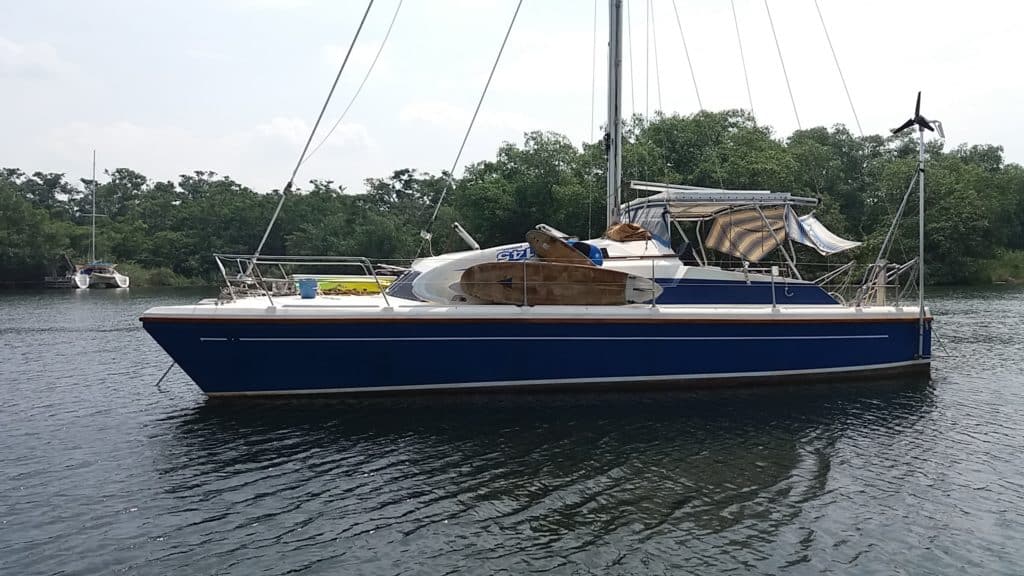
There’s no room for discussion: Catamarans are crossing oceans, and many sailors are choosing cats for world cruising. My last visits to the Azores and Canary Islands, the classic Atlantic waypoints, proved the point. I’m not much of a statistician, but by my count, at least a quarter and maybe a third of the boats I saw were catamarans. There would be more on this list, but they are just too expensive. Finding a quality catamaran for less than $100,000 is tough. One boat to consider is the classic workhorse multihull, the Prout Snowgoose 37.
When the Snowgoose 37 was launched in 1983, English builder Prout & Sons had already been in business for nearly 50 years. The 37 was an updated version of the Snowgoose 35, one of the most successful cruising cats ever. In 1986, the 37 was updated again; the Snowgoose Elite model included more beam and interior upgrades. These models are challenging to find for under $100,000, but it’s possible. A quick glance at yachtworld.com shows several of both models available for less than $100,000. Again, the strong dollar makes European boats an excellent value.
The Snowgoose 37 is not sexy like go-fast cats, and not roomy like modern cruising cats. It is, however, seaworthy. Of the 500 built, many have circumnavigated. Older boats have solid fiberglass hulls, and more recent models are solid glass from the waterline down and cored above. The cockpit is rather compact by catamaran standards, and the bridgedeck is solid (no tramp). Many 37s and all Elites were rigged with staysails, a big plus in heavy weather. The masthead-rigged Snowgoose 37 can be sailed like a monohull offshore, and it’s quite nice not having a huge, roachy mainsail to wrestle with in a storm. With a 15-foot-3-inch beam for the 37 and a 16-foot-3-inch beam for the Elite, it’s easy to find affordable dockage and yards for haulouts. Most boats have three double cabins, making the Snowgoose 37 an ideal family cruiser.
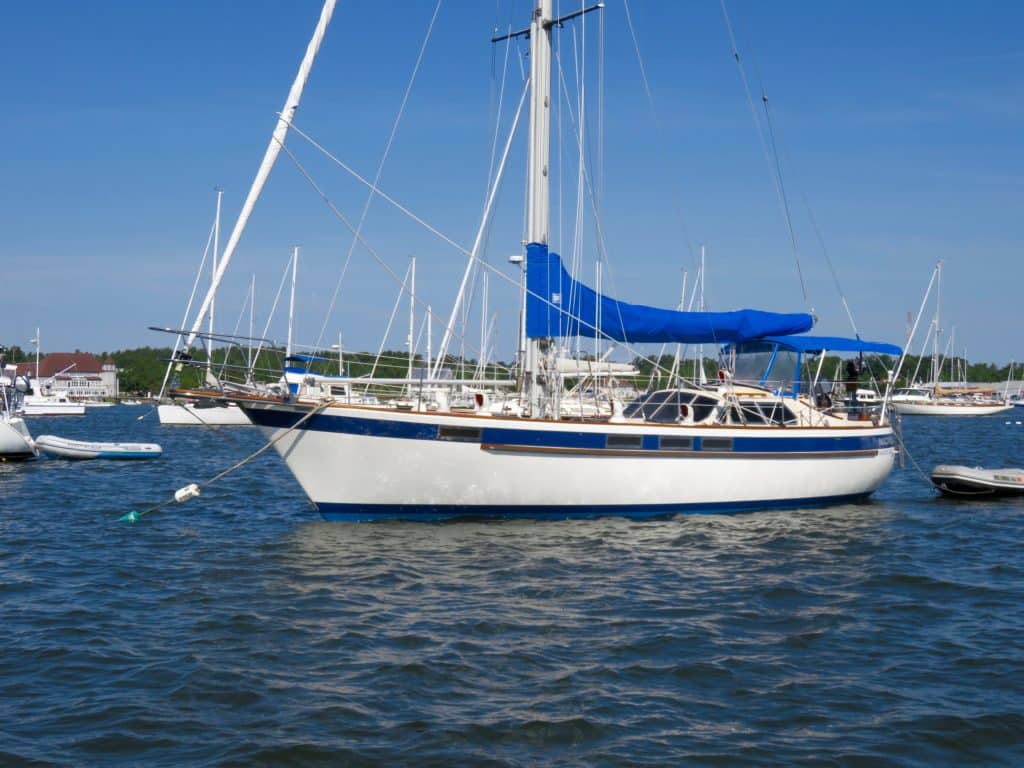
The Corbin 39 is not as well known as it should be. It’s a capable bluewater sailboat cruiser with many impressive voyages logged. My Quetzal spent several weeks moored alongside a handsome 39 in Corfu that had sailed around the world, and I also spent a winter in Malta in the same boatyard as another 39 that had recently crossed the Atlantic. A canoe-stern, flush-deck pilothouse cutter, the 39 was offered with either an aft or center cockpit. Designed by Michael Dufour and constructed by Corbin les Bateaux in Canada, hull number one was launched in 1977. Built in various locations in Quebec, 129 boats were launched before a fire destroyed the deck tooling in 1982. A new deck with a larger cockpit was designed, and 70 more boats were laid up before production ceased in 1990.
The rub on the Corbin 39 is that the majority of boats were sold as kits with owner-finished interiors. Kits varied from just hull-and-deck to “sailaway,” with everything fitted except the interior. Only 15 boats were finished at the factory. Not surprisingly, the interior quality is unpredictable, from rough-hewn lumberyard specials to beautifully handcrafted gems finished by marine professionals. The difference is reflected in the price. A nicely finished, well-equipped model from the mid-’80s typically sells for between $60,000 and $80,000.
The hull shape features a long fin keel and skeg-mounted rudder. The hulls are heavily laid up and include Airex coring. Early decks were plywood-cored, but most boats have Airex in the deck as well. Ballast is 9,000 pounds of internal lead, translating to a 40 percent ballast-to-displacement ratio. The wide flush deck is spacious, and the sleek pilothouse usually includes inside steering. Massive double anchor rollers are incorporated into the bowsprit in later models. Most boats include a double-spreader spar, and almost all were set up as cutters. There’s plenty of freeboard, which becomes obvious below. While interior arrangements vary considerably, there’s a lot of room to work with. I prefer the post-1982 aft-cockpit 39s; they’re generally of a higher quality than earlier boats.
– CARRY A BEACON – Satellite beacons such as EPIRBs or PLBs allow boaters to transmit distress signals and their exact coordinates from anywhere on the planet, no cell service required. It may be the best $400 you ever spend. Safety Tip Provided by the U.S. Coast Guard
Cabo Rico 38
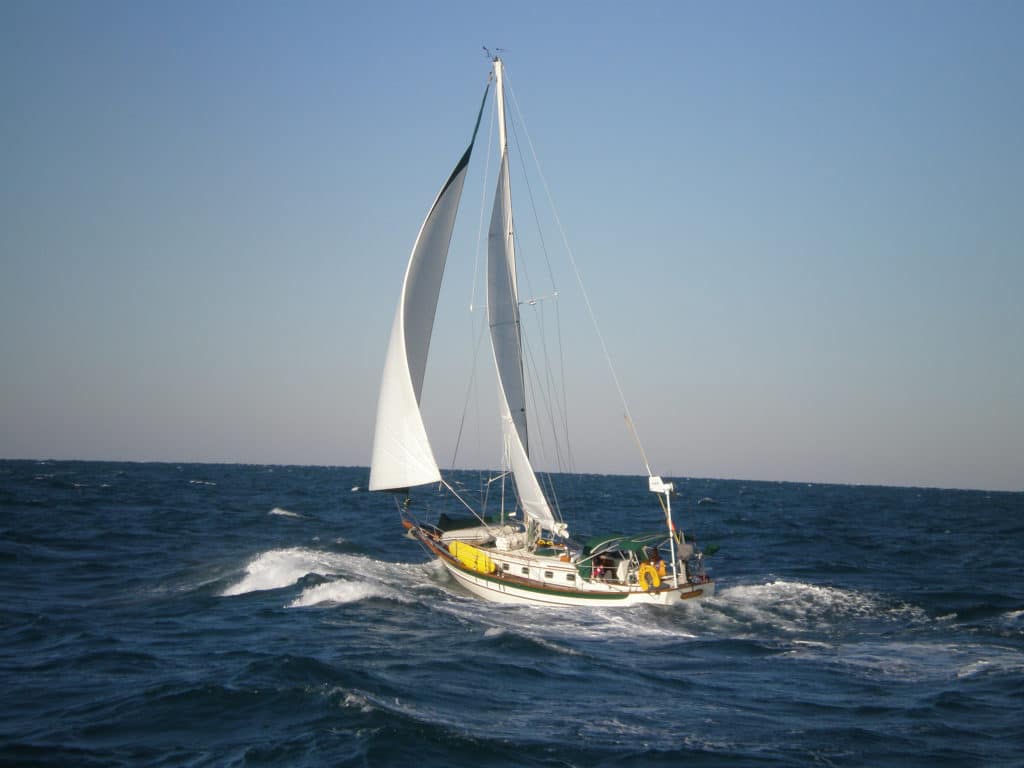
“The Cabo Rico 38 hull shape is the one in which everything came together best,” wrote Bill Crealock in his design notes. He might have changed his mind later in life, considering that the Cabo Rico was introduced in 1977 and he designed many boats after that, but few will dispute that this 38-foot cutter, built in Costa Rica, is flat-out beautiful. From the clipper bow to the sweet sheer to the abundance of honey-colored teak, the Cabo Rico 38 is a boat to inspire the most practical among us to quit their job, buy this vessel, and head for the South Pacific.
Not surprisingly, many people have done just that. Cabo Rico built 200 full-keeled 38s, with most of the production occurring in the 1980s. There’s always a selection of boats for sale for less than $100,000. Cabo Rico was an outlier among manufacturers of the time, building serious cruising boats in Central America instead of Taiwan, but quality control was always excellent. The full keel is slightly cutaway, and the rudder is attached to the trailing edge. The prop is in an aperture and totally protected, but not well suited to backing into a slip. Full-keel boats may make some younger sailors cringe, but the CR 38 has a very soft ride in rough seas and heaves to effectively. It also has a solid fiberglass hull with a layer of balsa for insulation. Sometimes it’s noted that the hull is balsa-cored, but it’s not. After about hull number 40, lead was used instead of iron for internal ballast. The deck is balsa-cored, however, and there’s a substantial bulwark. Items to be wary of are the teak decks (most 38s have them) and the fittings supporting the bobstay.
A true cutter rig, the 38 has just under 1,000 square feet of working sail area and performs better than most people suspect. The staysail was originally set on a boom that cluttered the foredeck and limited sail shape. Many boats have been converted with furling staysails sans the boom — a nice upgrade. When the wind pipes up, the 38 tracks nicely with a reefed main and staysail. I encounter 38s all over the Caribbean. They’re easy to spot; they’re the beautiful boats in the anchorage.
Tayana Vancouver 42
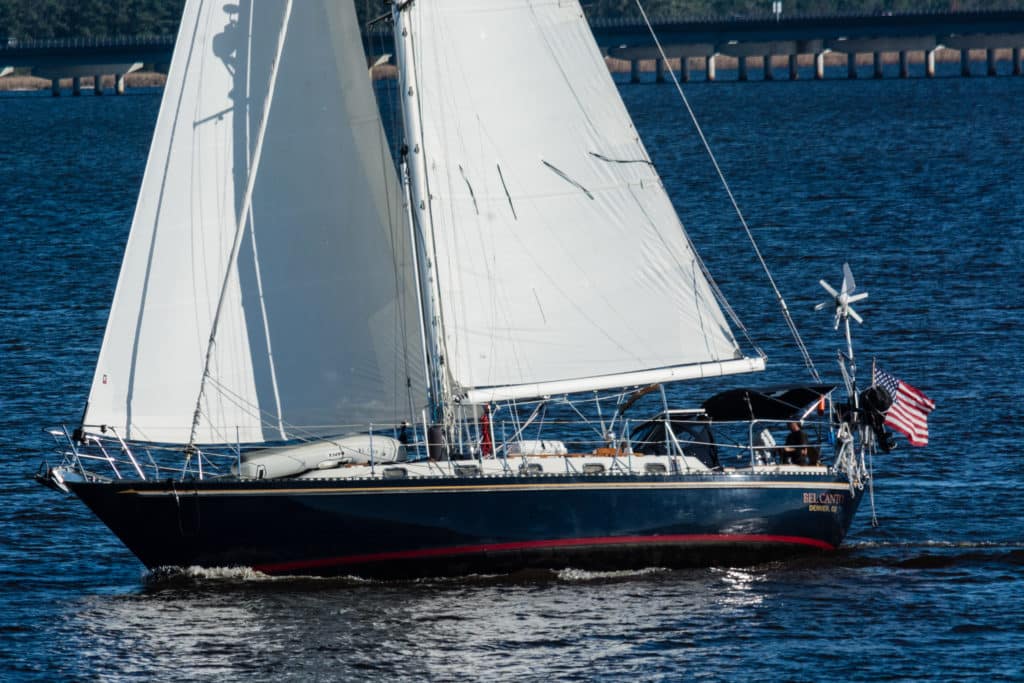
Ta Yang, builder of Tayana sailboats, has been building capable cruising boats forever, it seems. The Robert Harris-designed Tayana Vancouver 42 has been a mainstay of the serious cruising fleet since the day it was launched in 1979, and is still in demand today. The company built 200 boats, mostly in the ’80s and early ’90s, although a few V42s were built into the 2000s. With a bit of digging and some haggling, you can find boats for less than $100,000, but they’re likely to be older models. As of this writing, yachtworld.com has eight V42s listed, with three asking less than $100,000.
I’ve encountered the V42 all over the world, and in my yacht-delivery days, I had the pleasure of delivering a couple of 42s up the East Coast and down to the Caribbean. The double-ended hull shape with a fin-skeg underbody is stiff and seaworthy, if not wickedly fast. Considering the rugged construction, with a solid fiberglass hull and balsa-cored deck, nobody has ever accused Ta Yang of going light on its boats. Ballast is internal iron, a massive single casting that weighs in at 11,800 pounds. Ta Yang has evolved as a builder, and later models included upgrades like vinylester resin and larger Yanmar diesels.
A true cutter, the V42 has a double-spreader rig and is heavily stayed. The seagoing deck is cambered to shed water. Teak decks, with all their virtues and vices, were common; I’d look for a boat that’s been de-teaked. Like the Corbin 39, the V42 came with either a center or aft cockpit, although most boats were aft-cockpit models. The aft cockpit is deep and secure, if a bit tight due to volume sacrificed by the canoe stern. The center cockpit is cramped but offers excellent visibility. The interior is lovely, with exquisite Taiwanese joinery. Although interior arrangements vary because Ta Yang encouraged owner input, across the board, this is a friendly boat for living aboard. The aft-cockpit model includes one head and a traditional layout with excellent light and ventilation. The center-cockpit model features a large owner’s stateroom aft.
Wauquiez Pretorien 35
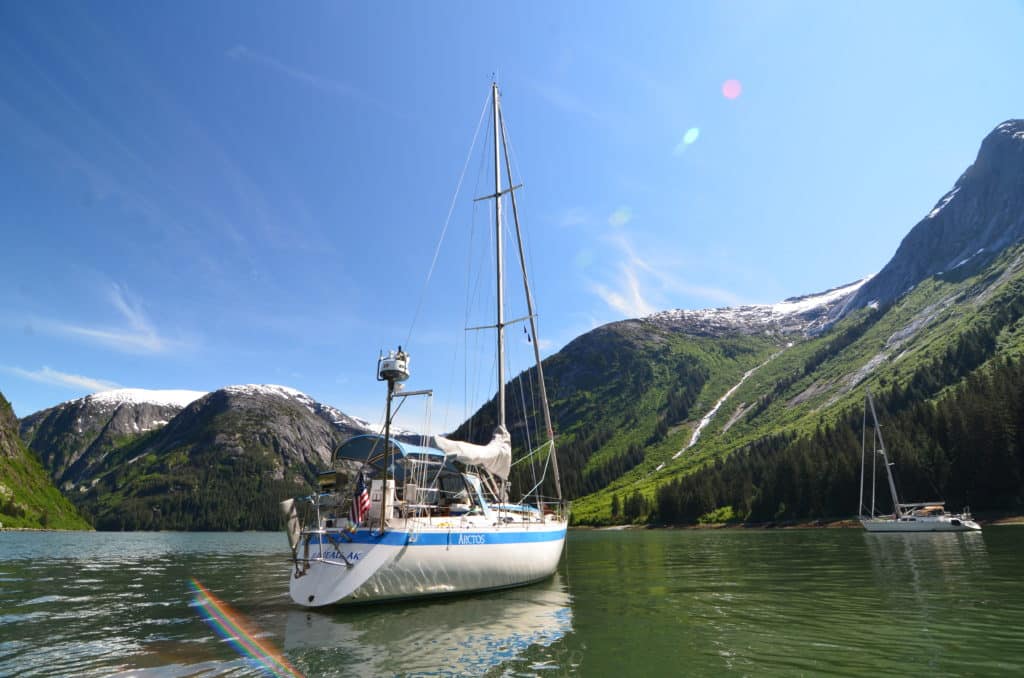
The Pretorien 35 does not pay homage to tradition. The Euro-style low-slung wedge deck and flattish lines were thoroughly modern when the Pretorien was launched in 1979. Sure, there are IOR influences in this well-proven Holman & Pye design, including a slightly pinched stern, cramped cockpit, and a high-aspect, short-boom mainsail that results in a large foretriangle. But a small main is easy to handle offshore, especially in squally conditions, and a large poled-out furling genoa provides a low-stress way to cross oceans. The test of a design is revealed long after the launch, and the Pretorien has aged brilliantly. It’s often mistaken for a Swan or Baltic. Famed voyager and author Hal Roth chose a Pretorien for his last boat.
Below the water, which is what really matters at sea, the Pretorien pushes the right buttons for serious sailing. A fine entry provides enough of a forefoot to prevent pounding in lumpy conditions, and as on the Valiant 40, the fin keel incorporates a stub to which the external ballast is fastened. The rudder is mounted well aft for excellent steering control, especially on a deep reach, and is tucked behind a narrow but full-length skeg. The Pretorien displaces 13,000 pounds, of which 6,000 pounds is ballast, translating to a stiff, seakindly boat.
The construction is superb. The solid fiberglass hull includes longitudinal stringers that stiffen the panels and encapsulate the bulkheads. Tabbing and fiberglass work is first-rate throughout. Wauquiez was one of the first builders to use solid laminate beneath high-load deck fittings. The side decks are wide and, with the chainplates well inboard, easy to navigate. The interior arrangement is conventional, but ample beam amidships helps create a surprisingly spacious feel below.
There were 212 Pretoriens built during a seven-year production run, so there’s usually a good selection of boats on the used market. Today’s strong dollar makes European Pretoriens an excellent value.
– SHOW THEM HOW MUCH YOU CARE – Nothing says ‘I love you’ like making sure the kids’ life jackets are snugged up and properly buckled. Safety Tip Provided by the U.S. Coast Guard
Gulfstar 44
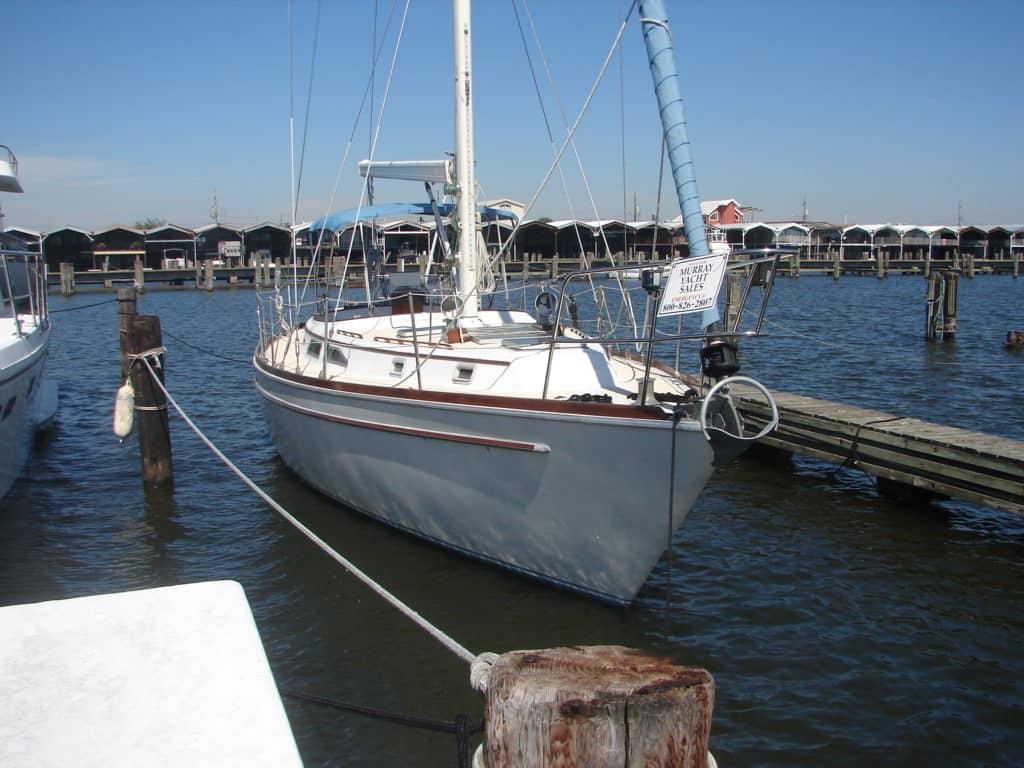
Gulfstar had a terrible reputation in the early ’70s: It was infamous for producing wide-body motorsailers with tiny rigs and chintzy Formica interiors. Company founder Vince Lazzara was adept at reading market trends and upped his game in the late ’70s and ’80s. Lazzara, who also founded Columbia Yachts, was a veteran of the production-sailboat wars and realized that buyers were demanding high-quality boats that sailed well. The Gulfstar 44 was launched in 1978, and 105 were sold before the company started producing the Hirsh 45 in 1985.
Some mistake the G44 for a Bristol, and it has a similar profile, right down to the teak toerail and raked cabin trunk. A sleek center-cockpit design, the hull shape features a 5-foot-6-inch fin keel, a skeg-hung rudder and moderate proportions. I know the boat well, having delivered one from Bermuda to Annapolis and another from Fort Lauderdale to Boston. It has a nice ride in lumpy seas and powers up when the big genoa is drawing on a reach. The construction is typical of the time, with solid fiberglass hulls and cored decks. Gulfstars were known to blister, and it’s likely that any 44 you find will have had an epoxy bottom job along the way — and if it hasn’t, it will need one. The keel-stepped spar has an air draft of 55 feet. Some owners have modified the sloop rig with a staysail. The cockpit is roomy, especially for a center-cockpit design, although there’s not much of a bridgedeck. All sail controls are led aft. Lazzara was an early proponent of this feature, and the boat is user-friendly overall.
The interior sells the boat. It’s nicely finished in teak, and the layout is made for living aboard. The aft cabin includes an enormous double berth with an en suite head and stall shower. The main saloon is spacious and well ventilated, although beware of the plastic opening portlights. If you are looking for a comfortable, well-built center-cockpit cruiser but can’t find one that you can afford, track down a Gulfstar 44; you’ll be pleasantly surprised.
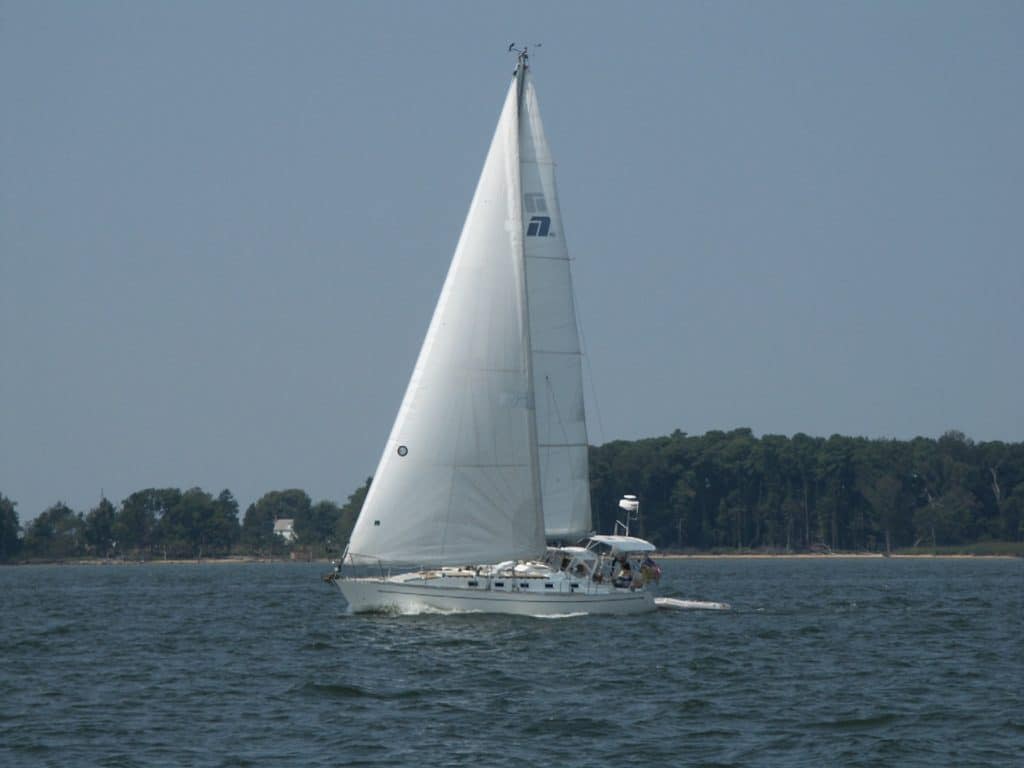
Any list of bluewater cruising sailboats must include a Robert Perry design. I could have easily put together nine Perry boats for this list. The Nordic 40 may surprise some, especially because 40 feet is an iconic length, bringing to mind such boats as the Valiant 40, Hinckley Bermuda 40, Bristol 40, Pacific Seacraft 40, Passport 40 and others. The trick is finding a 40-footer for less than $100,000. Nonetheless, the Nordic 40 and its larger sister ship, the 44, are among my favorite boats.
Based in Bellingham, Washington, Nordic produced world-class yachts during its brief production run in the 1980s. Only 40 Nordic 40s were launched between 1982 and 1987, but they’re worth seeking out on the used-boat market. The 40 features the classic double-ended Perry hull shape, with a fine entry, a deep and powerful fin keel, a skeg-mounted rudder positioned well aft, and a reverse transom. Freeboard is moderate and the sheer line is subtle, but to my eye, with its double-spreader rig and gently sloping deck line, the boat is poetry in the water.
The hull is solid fiberglass and the deck is balsa-cored, with solid laminates below loaded-up deck fittings. Original boats came with Navtec rod rigging and a hydraulic backstay, but many have been upgraded by now. Sail-control lines are led aft to the compact but functional T-shaped cockpit. The traveler is forward of the companionway, allowing for a cockpit dodger. The Nordic 40 is nimble in light to moderate breeze but can also stand up in a blow and heave to decently.
The interior is well suited to a cruising couple. It’s really a two-person boat, with a V-berth forward and large C-shaped galley aft, with plenty of counter space and a huge fridge. It includes the normal deft Perry touches — excellent sea berths, a separate stall shower and generous tankage. If you do find a Nordic 40 on the used market, be sure to take a hard look at the Westerbeke diesel and the V-drive transmission.
Pacific Seacraft 34
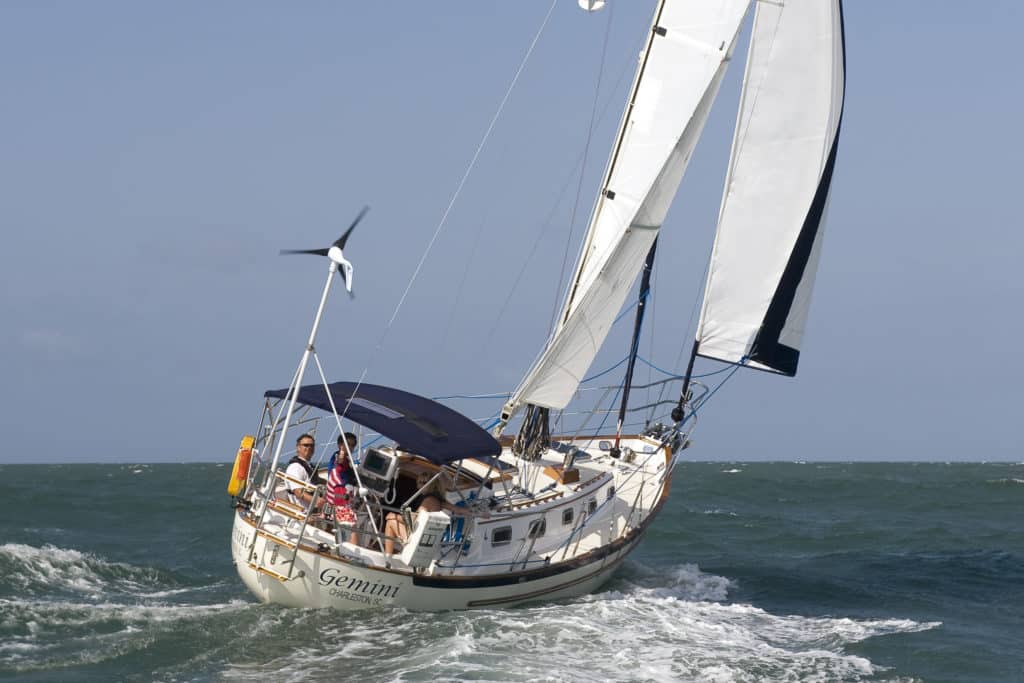
A handsome, nimble and capable double-ender by legendary designer Bill Crealock, the Pacific Seacraft 34 is well proven, with scores of ocean crossings in its wake.
After the boat was first launched as the Crealock 34 in 1979, Pacific Seacraft introduced a fifth model years later, a scaled-down version of the popular PS 37. Though expensive at the time, the 34 was another success story for one of America’s premier builders, and hundreds of boats were built in the company’s yard in Santa Ana, California. There is always a good selection of used boats available for less than $100,000. Another nice perk for used-boat buyers is that the 34 is back in production at the reincarnated Pacific Seacraft yard in Washington, North Carolina, providing an outlet for parts and advice. The company is now owned and operated by marine archaeologist Stephen Brodie and his father, Reid.
The 34 blends traditional values above the waterline with what was then a more modern underbody, with a long fin keel and skeg-hung rudder. A bit hefty at 13,500 pounds of displacement, the design otherwise is a study in moderation, and drawn with a keen eye toward providing a soft ride in a seaway and staying on good terms with Neptune in a blow.
The hull is solid fiberglass, and early decks were plywood-cored before Pacific switched to end-grain balsa. The hull-to-deck joint incorporates a molded bulwark that offers added security when you’re moving about on deck, and a vertical surface for mounting stanchions.
Most 34s are cutter-rigged for versatility but carry moderate-size genoas instead of high-cut yankees for more horsepower off the wind. Down below, the layout is traditional, but the 6-foot-4-inch headroom is a pleasant surprise. The Pacific Seacraft 34 is perfect for a cruising couple.
John Kretschmer is a delivery captain, adventurer and writer, whose own boat Quetzal , a 1987 Kaufman 47, has seen a refit or two over the years. His latest book is Sailing a Serious Ocean: Sailboats, Storms, Stories and Lessons Learned from 30 Years at Sea , also available on his website .
- More: classic plastic , DIY Sailboat Projects , Sailboat Reviews , Sailboats , used boat guide
- More Sailboats

New Sailboat Brand: Mishi Yachts

For Sale: 2005 Tayana 48

For Sale: 2015 Catalina 355

For Sale: 1998 Hinckley 51
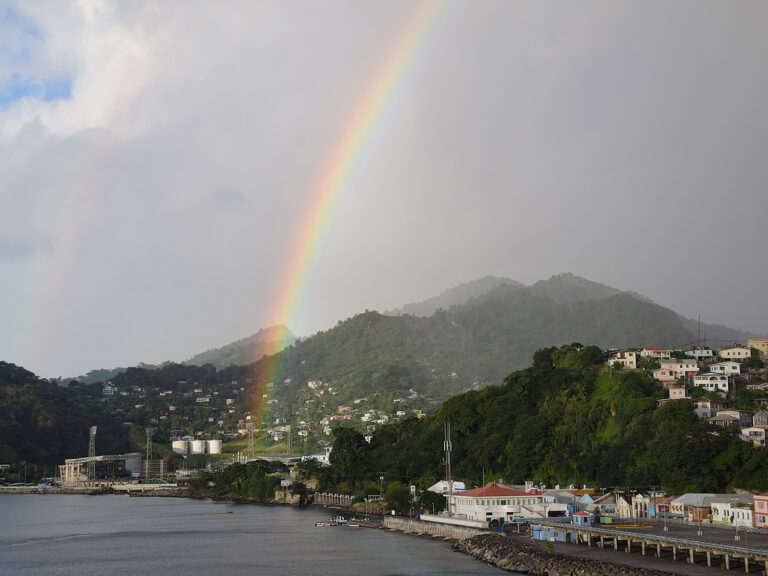
Hurricane Beryl Relief Efforts: How You Can Help

Gary Jobson To Talk U.S. Prospects in Upcoming World Sailing Competitions

Make Downwind Sailing Fun Again. Turn Off That Motor and Unfurl Your Kite!
- Digital Edition
- Customer Service
- Privacy Policy
- Email Newsletters
- Cruising World
- Sailing World
- Salt Water Sportsman
- Sport Fishing
- Wakeboarding
13 Dirt-Cheap Liveaboard Sailboats (That Are Actually Good)
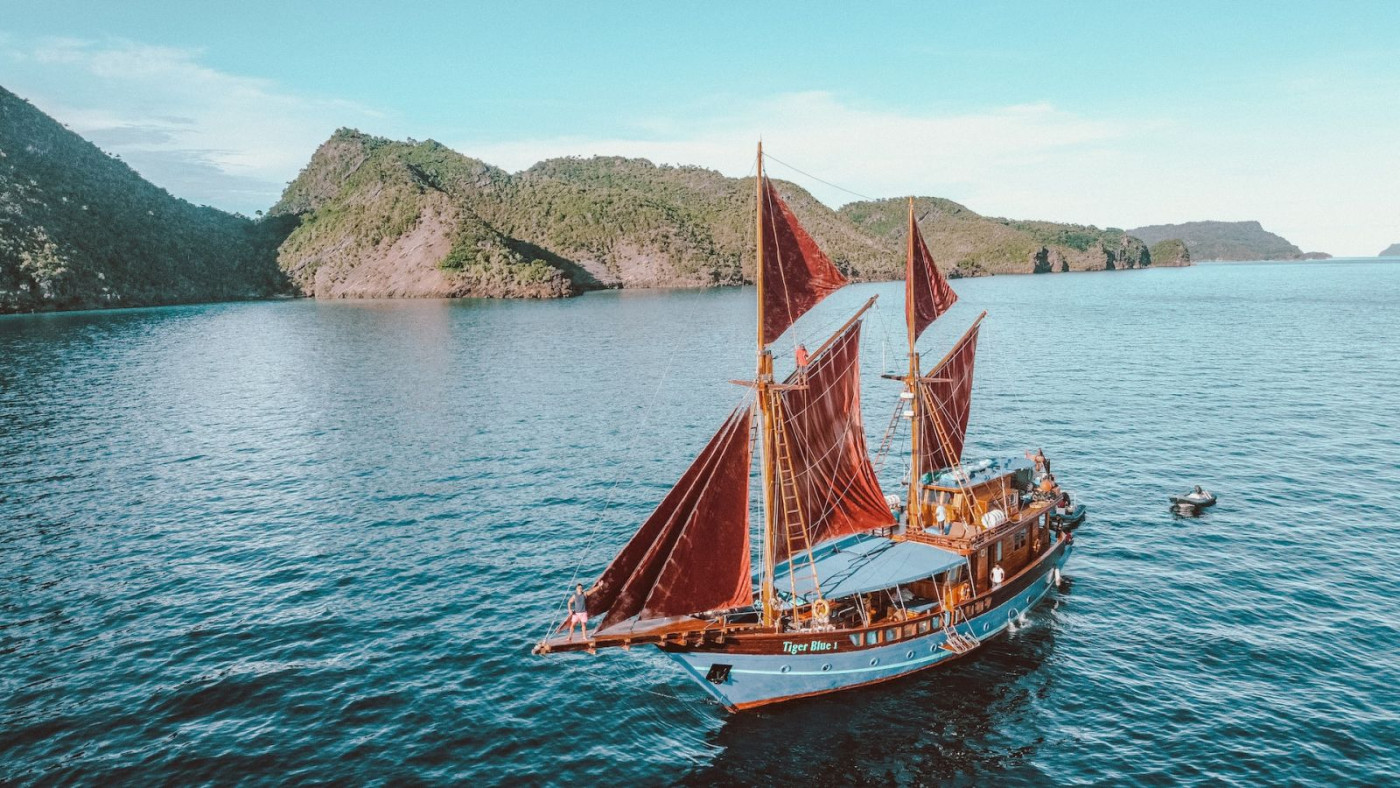
When it comes to selecting a dirt-cheap liveaboard sailboat, you don't have to compromise on quality. There are many classic models and a few hidden gems that provide comfort, space, and sailing capabilities at a very affordable price. In this article, you'll find a list of classic liveaboard sailboats, as well as a few original finds that can fit your budget.
Liveaboard sailboats that are cheap but actually good include Westsail 32, Alberg 30, Tayana 37, Catalina 30, Ericson 35, Albin Vega 27, Bristol 32, Morgan 323, Contessa 32, Pearson 365, Hunter 31, Cal 34, and Tartan 30. The prices of these boats range from $5,000 to $50,000 or more.
Living aboard a sailboat on a budget doesn't mean you have to settle for less. These affordable boats can still provide the comfort and performance you're looking for. We've included some models that you can find on Craigslist.
- These budget-friendly liveaboard sailboats offer a great combination of affordability, performance, and comfort, making them ideal choices for living the sailing dream.
- Some classic models that provide you with enough room to move around and store your belongings include the Alberg 30 and the Tayana 37.
- Classic models such as the Westsail 32, Alberg 30, Tayana 37, Catalina 30, Ericson 35, and Albin Vega 27 are known for their seaworthiness and versatility.
- The cheaper the boat, the more likely you'll need to invest in repairs and spare parts over the years. This is where some more obscure finds can surprise you, such as the Contessa 32 and the Cal 34, which offer easy maintenance and relatively cheap spare parts.
On this page:
13 cheapest liveaboard sailboats that are good, key features of a good liveaboard sailboat, classic liveaboard sailboat models, affordable liveaboard sailboats.
| Price Range | |
|---|---|
| $30,000 to $80,000 | |
| $5,000 to $20,000 | |
| $40,000 to $120,000 | |
| $10,000 to $40,000 | |
| $20,000 to $50,000 | |
| $5,000 to $20,000 | |
| $10,000 to $50,000 | |
| $20,000 to $40,000 | |
| $20,000 to $50,000 | |
| $30,000 to $80,000 | |
| $10,000 to $30,000 | |
| $10,000 to $30,000 | |
| $10,000 to $30,000 |
When looking for an affordable yet reliable liveaboard sailboat , there are several important features to consider. These can greatly affect your overall experience and satisfaction with your chosen boat.
Layout and space : On a liveaboard sailboat, space and layout are crucial. You'll want a boat that offers efficient use of space, a comfortable living area, a functional galley, and adequate storage. Generally, 25 to 35 feet in length is the ideal size range for a liveaboard.
Sailing performance : Even if you plan to live aboard primarily , sailing performance should still be a priority. Consider its ability to handle light winds, heavy winds, and everything in between. Your boat should be able to handle various sea conditions and be easily maneuvered. It should be versatile enough for various wind conditions and sea states.
Hull design : The hull design of your sailboat will affect its stability and performance in the water. Look for a design that offers a good balance between comfort, safety, and speed. A full-keel or modified full-keel design provides stability and tracking in rough seas, while a fin keel offers better maneuverability in tight spaces like harbors and marinas.
Maintenance and construction : Pay attention to the boat's construction materials and quality. Fiberglass and aluminum are popular choices due to their durability and low maintenance requirements. Wooden boats tend to be more affordable but may require more maintenance and care.
In this section, we will discuss some classic liveaboard sailboat models that are known for their affordability, functionality, and reliability. These boats have stood the test of time and are excellent choices, especially for novices.
Westsail 32 is known as "the cruiser that launched the cruising boom"
The Westsail 32 is a sturdy, reliable, and comfortable liveaboard option for those seeking a classic, bluewater cruising boat. Designed by William Crealock, it boasts heavy construction, a full keel, a roomy interior, and seaworthy capabilities. With many of these boats available on the market, you can find a Westsail 32 in good condition at affordable prices.
Alberg 30 is a classic full-keel cruiser known for its seaworthy design
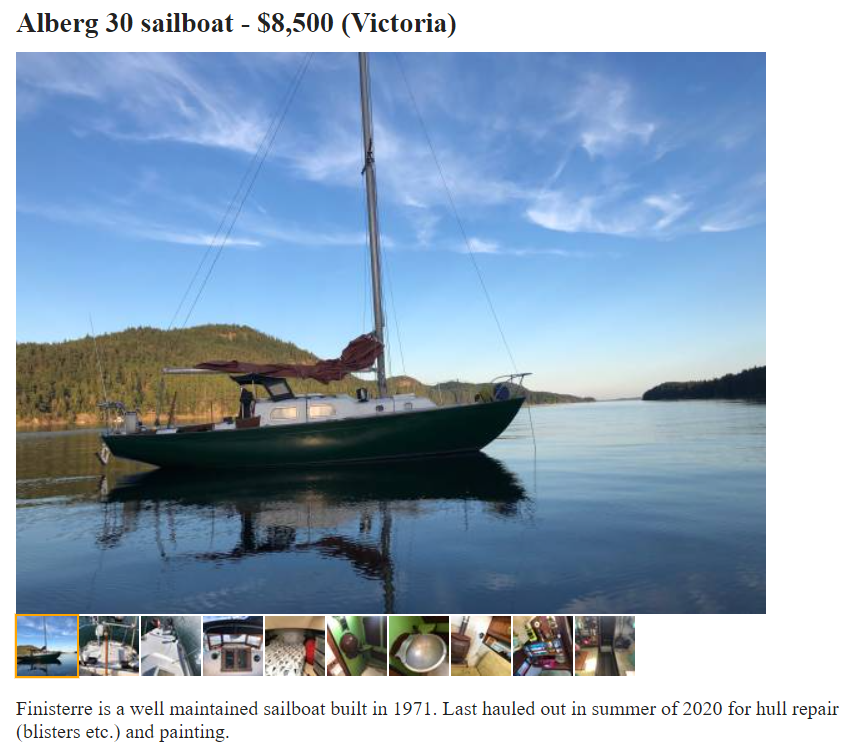
The Alberg 30 is a classic design from the 1960s, created by Carl Alberg, and built by Whitby Boat Works in Canada. This boat is known for being easy to sail and is a perfect choice for new liveaboards. The Alberg 30 has a simple layout, adequate living space, and enough storage to make it a suitable option for long-term living, all while keeping to a budget.
Tayana 37 is known for its seaworthiness and durability
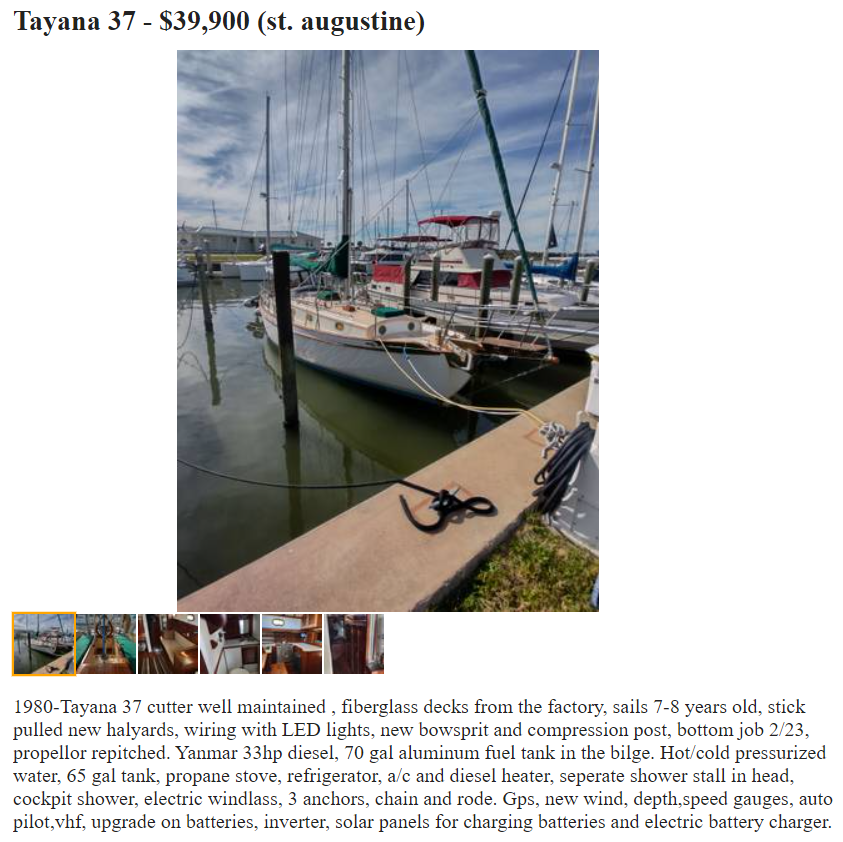
Designed by Robert Perry and built in Taiwan, the Tayana 37 is a popular and capable bluewater cruiser. This well-built classic boat is known for its comfort, safety, and ease of handling when sailing long distances. The Tayana 37 offers plenty of space and storage, making it a delightfully practical liveaboard choice, even for small families or couples.
Catalina 30 is one of the most popular sailboats of all time
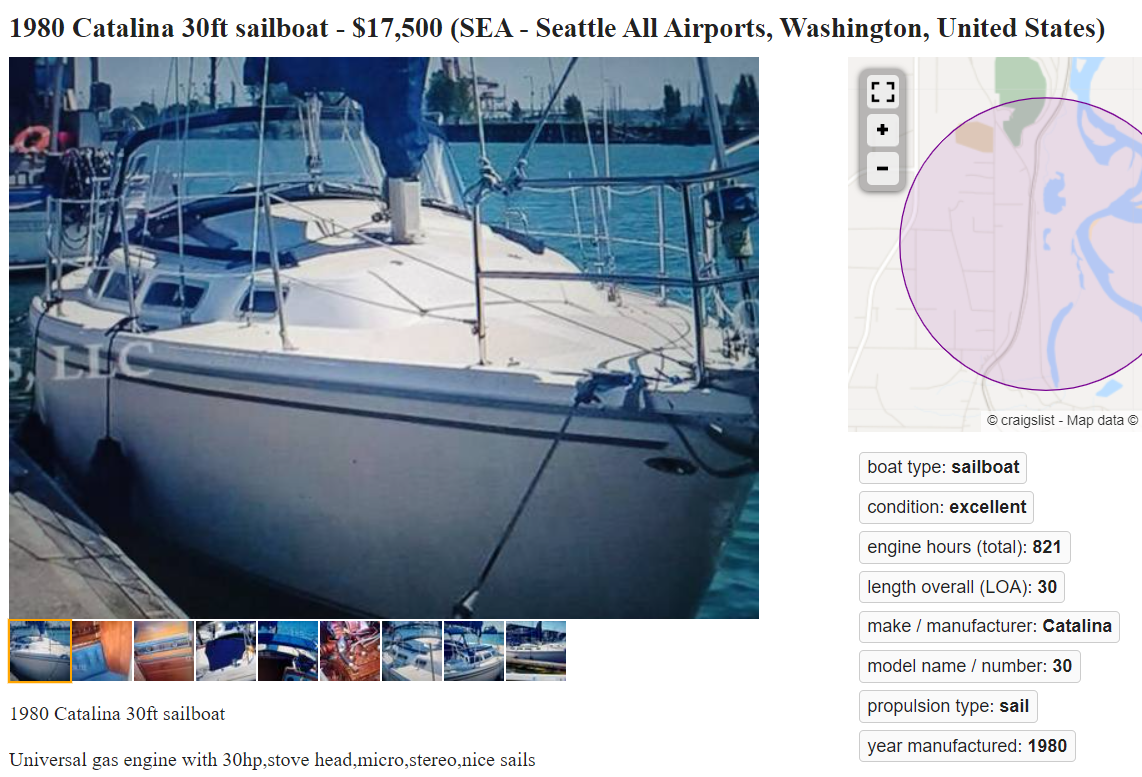
The Catalina 30 is one of the most popular sailboats in its size range and has a reputation for being an incredibly spacious boat, given its 30-foot length. Designed by Frank Butler, the Catalina 30 is known for its roomy interior and user-friendly layout, making it a fantastic option for liveaboard enthusiasts. The affordability and availability of the Catalina 30 also make it a top choice among sailors. It’s a tried-and-true option for liveaboard enthusiasts.
Ericson 35 has solid build quality
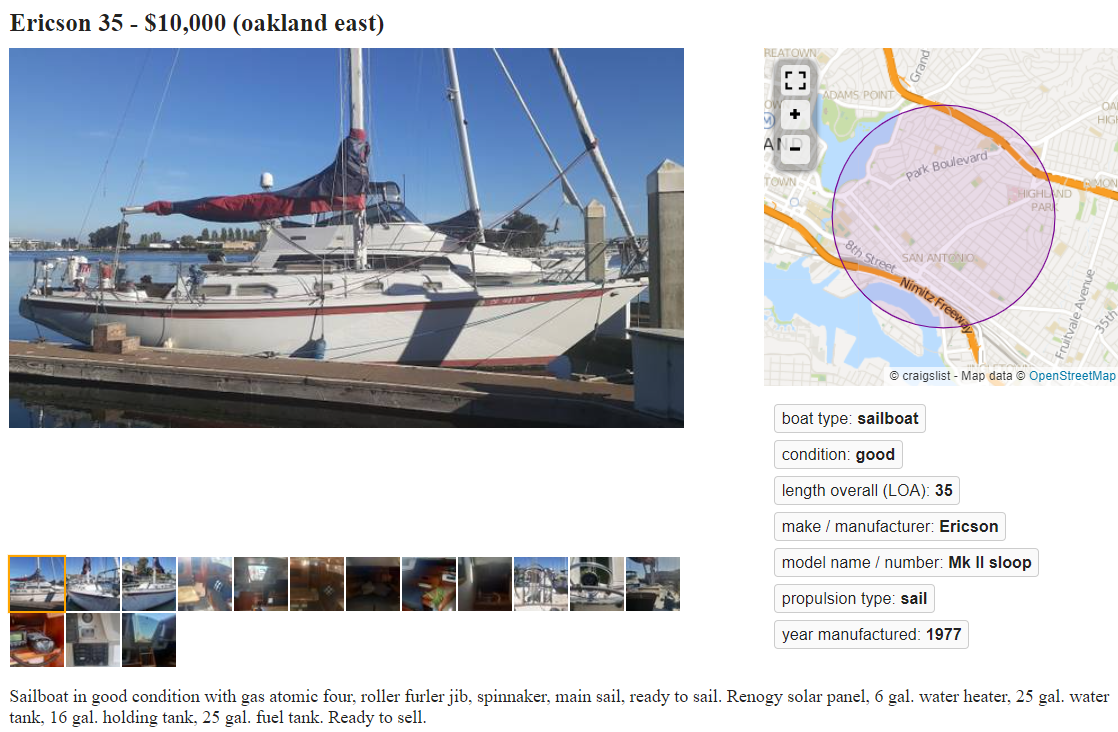
For those looking for a slightly larger liveaboard sailboat, the Ericson 35 is an excellent option. Designed by Bruce King and built by Ericson Yachts, it is praised for its solid build quality and comfortable accommodations. The practical layout and generous storage space make the boat a desirable choice for those looking to live aboard on a budget .
Albin Vega 27 is a proven ocean cruiser
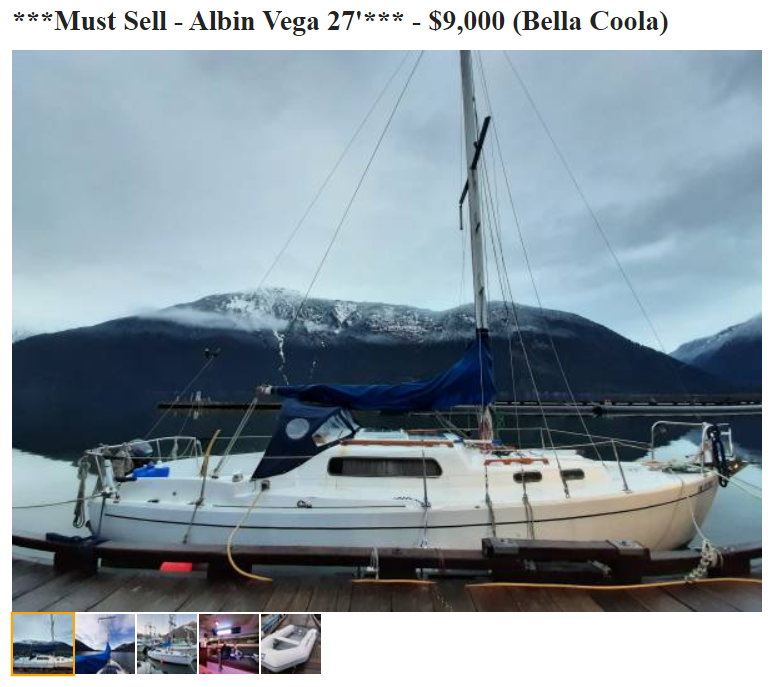
The Albin Vega 27 is a smaller liveaboard option for those who prioritize simplicity and affordability. Designed by Per Brohäll and built in Sweden, the Albin Vega 27 is a proven ocean cruiser with a surprising amount of space for a boat of its size. If you're looking for an affordable liveaboard sailboat with a compact yet functional layout, the Albin Vega 27 might be the perfect fit for you.
In your quest for a dirt-cheap liveaboard sailboat that's actually good, there are some finds worth considering. Let's dive into these affordable gems that were built for liveaboard life and sailing.
Bristol 32 is known for its classic design and solid construction
The Bristol 32 is a classic liveaboard sailboat with a solid reputation for its sturdy construction and excellent sailing performance. Designed by Ted Hood, this boat is known for its comfortable living spaces and adequate storage. A used Bristol 32 can be found at a reasonable price, making it perfect for those with a tight budget.
Morgan 323 provides stability and safety
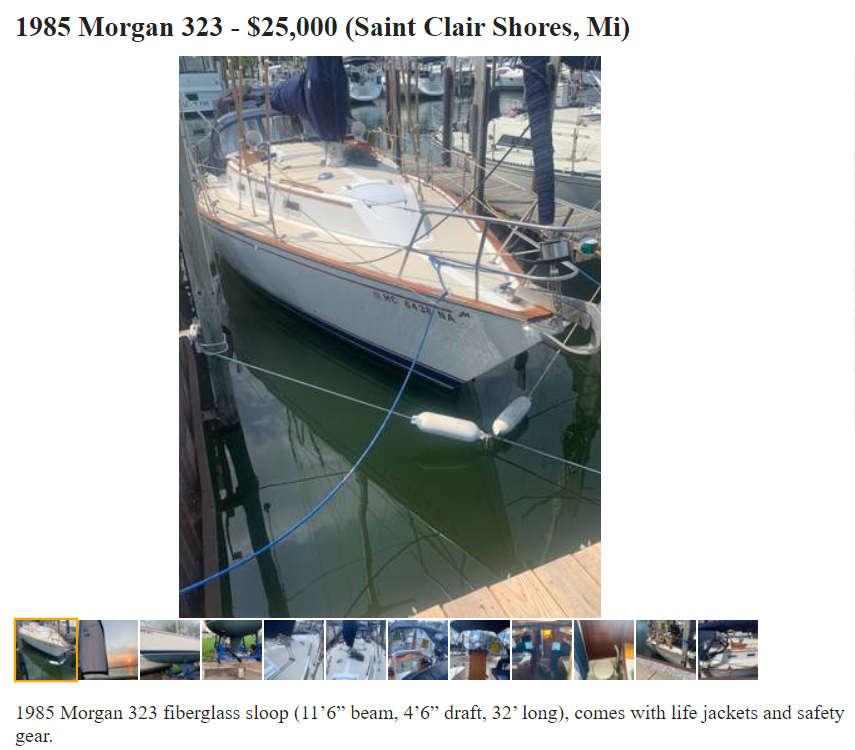
Next is the Morgan 323, which offers a great deal of interior space for a 32-foot sailboat. The well-designed layout ensures you have all the necessary amenities for living aboard while maintaining high sailing performance. Equipped with a full keel and skeg-hung rudder, the Morgan 323 provides stability and safety while underway.
Contessa 32 has a solid reputation for being safe, seaworthy, and comfortable
A British classic, the Contessa 32 is a small yet capable liveaboard sailboat , perfect for a couple or solo sailor. With its sleek lines, excellent performance, and well-built hull, the Contessa 32 is a go-to choice for many budget-conscious sailors. It's a rugged, seaworthy vessel that can handle various weather conditions with ease.
Pearson 365 is suitable for long-term and weekend cruises
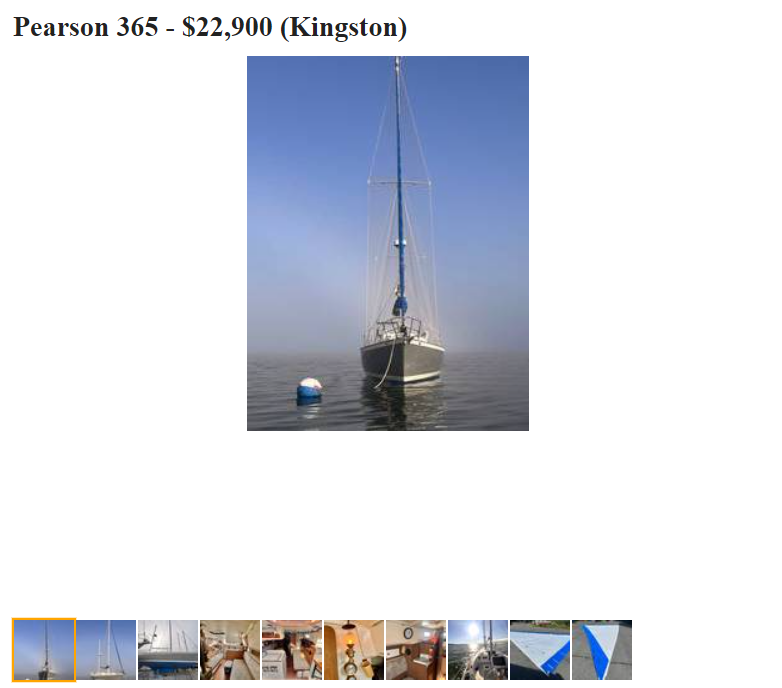
The Pearson 365 is another popular liveaboard sailboat, known for its spacious interior, comfortable accommodations, and reasonable price. With a roomy cockpit, plenty of storage, and a versatile sail plan, the Pearson 365 is well-suited for both long-term liveaboards and weekend cruisers.
Hunter 31 is well-rounded and spacious
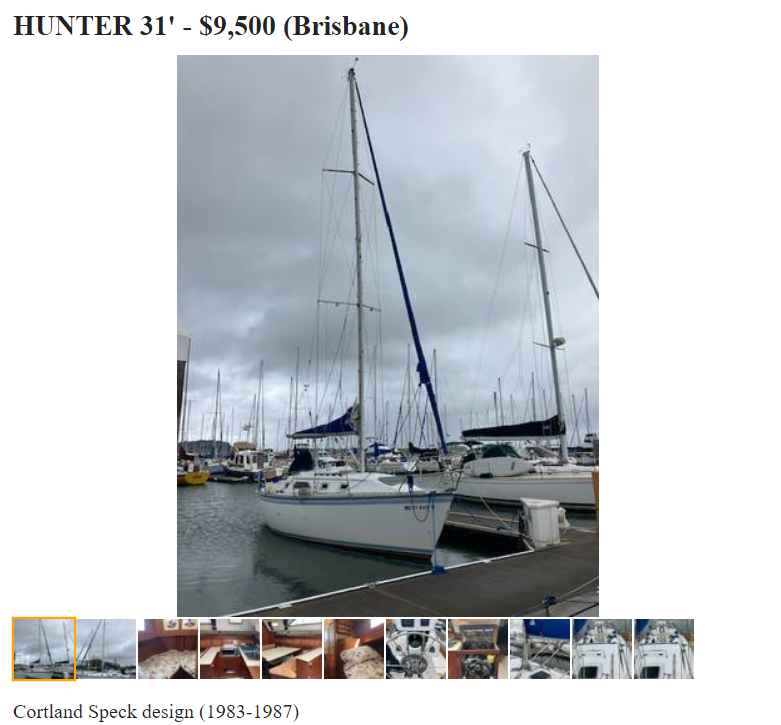
Affordable and easy to find, the Hunter 31 is a popular choice for budget-conscious sailors searching for a suitable liveaboard. With its beamy hull, the Hunter 31 boasts a spacious and functional interior. While not a traditional bluewater cruiser, the Hunter 31 can hold its own in coastal and nearshore environments.
Cal 34 offers solid sailing performance
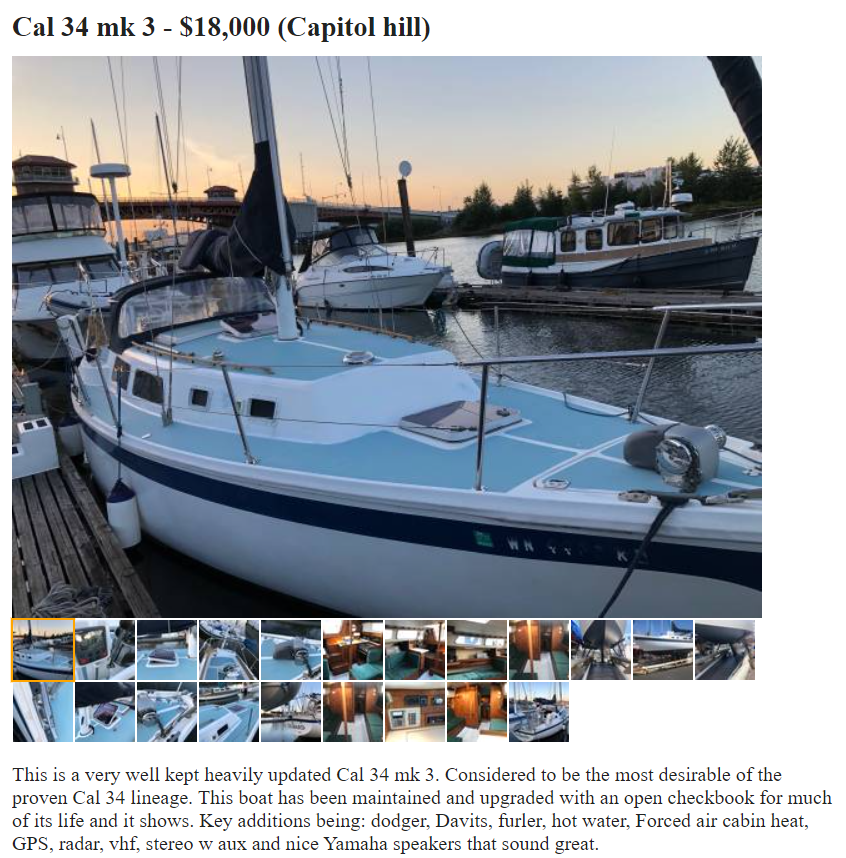
Another solid liveaboard option is the Cal 34. This well-designed sailboat has earned a reputation for its quality construction and comfortable living spaces. The Cal 34 strikes a suitable balance between performance and affordability, making it a popular choice among budget-conscious sailors.
Tartan 30 has enough space for living aboard
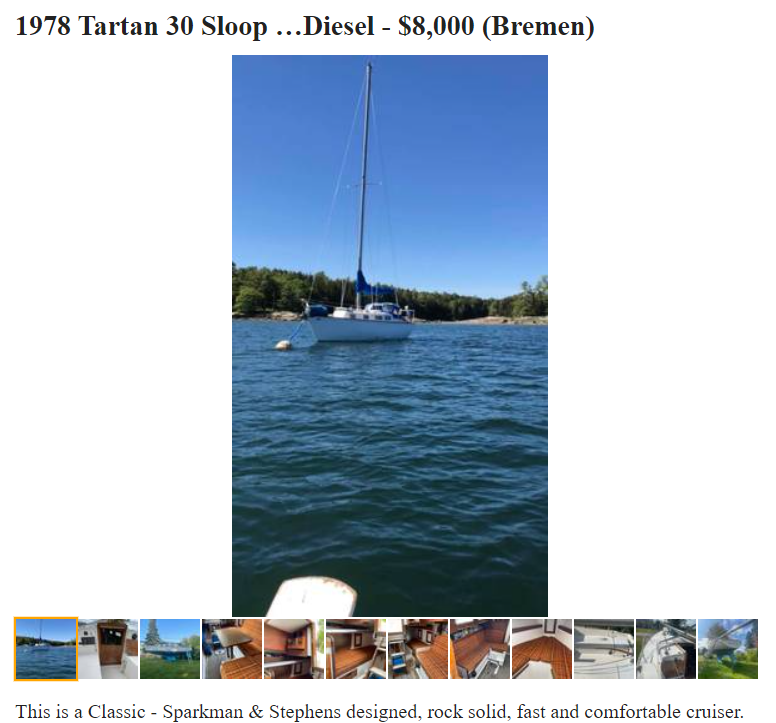
Last but not least is the Tartan 30. This sturdy sailboat is known for its seakeeping abilities and high-quality construction. The Tartan 30 provides adequate space for living aboard while maintaining its performance capabilities. Finding a used Tartan 30 at a great price is an excellent opportunity to secure an affordable, comfortable liveaboard.
Leave a comment
You may also like, sailboat vs. powerboat: what's the best liveaboard.
So you've chosen to live on a boat—the first step towards a pretty awesome dream. Now you gotta start figuring out the logistics. First of which is the choice of …

13 Most Practical Boat Liveaboard Places in the US

13 Best Liveaboard Sailboats (under 30 & 50 ft)

How To Self Isolate as a Liveaboard Sailor (7 Tips)

How To Live On a Boat For Free: How I'd Do It

10 Best Sailboats To Live In
If you’re tired of life on land and crave the freedom of the sea, then living on a sailboat might just be the answer. Residing on a boat means you can sail off for adventures anytime you like, and the world is your oyster as they say.
Although the initial cost may be high, living on the water is typically cheaper than living in a traditional house. It can be a wise financial move and a wonderful way to explore the world from the comfort of your ‘home’.
However, If you’re planning on making a sailboat your permanent home, there are lots of factors to consider. Predominantly, you will need a boat with a suitable and comfortable cabin. Each sailboat has different amenities and sizes, and budget will dictate what you can realistically buy.
Before you purchase, it’s vital to gather as much information as possible about what you need. Read online articles about other people’s experiences and identify any issues that they have come across to help inform any choices you make.
You will also need to decide what level of comfort you require. Some boats come with the minimum of amenities and some are all singing and all dancing.
It’s also important to decide what size and type of boat you will need. Some are designed with reduced furniture, so there’s more room for storage to keep things needed for long journeys.
Coastal sailboats are usually more luxurious and more suitable if you only plan on shorter journeys. So, let’s have a look at 10 of the best sailboats currently on the market.
Catalina
The Catalina is a well-known and trusted brand of sailboat , and they offer several models with different facilities depending on requirements.
The Catalina first appeared in 1972 and is still being made and improved upon today. They are super reliable and offer a spacious and modern interior. For example the Cruiser 315 offers comfortable cream leather sofas with an eating area.
There is adequate lighting and integrated flat screen TV. There are modern conveniences such as fixed ports for digital needs along with a table to work/eat from.
The kitchen area is equipped with a fridge/freezer, drawers, cabinets, and a two burner stove and oven. The sleeping area is cozy and soundproof. The teak interior gives a feeling of warmth and security.
The 315, 355 and 445 series sailboat is constructed of fiberglass and many additional features that make this boat sturdy and stable. It has the benefit of watertight StrikeZone, Collision bulkheads and mast system that is supported by a SecureSocket feature that ensures the boat is watertight.
DeepDefense Rudder controls ensure that steering is failsafe. In addition, it has a deck stepped mast along with the benefits of a keel-stepped mast.
Contessa
The Contessa is another long-standing contender and has been in circulation since 1970. Although the standard models are no longer built, sailboat builders will produce custom-made boats to this day.
The Contessa is famous for being one of the best cruising boats ever made and makes ideal boat homes also. They lack the luxury of the Catalina but have adequate facilities and a no frills design.
For example, the Contessa 32 is 32 feet (ca. 10 m) in length and is super stable and makes a perfect small family boat. The sail plan can be handled by one person and is easy to maneuver.
The interior is cute with a separate master bedroom and small shower, although compact, the area feels safe. It has a plethora of safety features and are available at competitive rates.
Nordic 40
The Nordic sailboat has been around since the early 80s and is one of the largest boats available. It’s perfect for cruisers and provides a substantial home to live in.
The cabin provides standing room, so no bending required. There is a very spacious bedroom and a full galley that is light and airy. It is equipped with two deep sinks, a large counter area and a 3 burner stove. The L shaped settee is spacious and next to it is a fold down mounted table which is extendable when entertaining extra guests.
It has the benefit of extra storage making full-time living and travelling a breeze, in fact it’s quite possible to fill the sailboat with enough provisions to last several months if needed.
In addition, she is able to carry sufficient fuel and water for long trips. The Nordic also offers ample ventilation, with 10 opening ports and 2 big hatches. For cold days it has an insulated hull which easily heats the boat.
The cockpit is easy to navigate and offers all round wide coamings, seaback that are high and large winches accessible from the helm. Furthermore, the Nordic comes equipped with safety features such as a raised bridge deck and padeyes for safety harnesses. All In all this is a great sailboat to live in.
Pearson 34
This long-standing 34 foot boat has been around since the 80s and is another spacious option. It’s the most home-like sailboat we’ve chosen for those that enjoy creature comforts and miss the feel of a traditional living space.
The head of the cabin is enclosed but spacious, and it has a separate master bedroom with ample storage. There is also more floor space than most sailboats allowing you to walk around with ease.
Nor’Sea 27
This compact little boat is ideal for a single person wanting to live aboard a sailboat. It benefits from all the necessary amenities you would find in a larger boat. It’s comfortable and cheaper to maintain. Furthermore, it has a cute little galley along with a shower and toilet.
The berth easily converts into a dining area and also contains two bunks under the cockpit for visitors. The Nor’Sea’s portable design means it is easily transported with a vehicle to the place of your choice.
This cruiser is designed for long-distance journeys and can withhold bad weather successfully. Its heavy-duty construction makes it a powerful and seaworthy boat, as well as being aesthetically beautiful.
Islander 36
This sailboat is a superb choice for living aboard and has been designed for cruising. The interior is elegant with wooden trims and impressive cabins. Furthermore, it is more than capable of handling heavy air and huge swells making it a super safe option for sailing adventures.
The cabin area is small but has a good-sized V berth as well as a shower and head. Two settees to port and a fold up table means there is adequate space to eat. In addition, there is a navigation seat at the quarter berth.
The Islander offers several drawers and canned lockers, with an ice box included as standard. There is an option to upgrade to better facilities if needed. Another advantage of the Islander is the integrated steps down to the cockpit, as opposed to the usual ladder. They also provide an extra seating area when you have guests.
The boat holds 50 gallons (0.19 m³) of water and 30 of fuel, meaning you need to have back-up if you’re travelling, but this amount is ideal for boat living or coastal cruising.
Pacific Seacraft Flicka 20
This tiny sailboat is a little monster at sea and ideal for living in. It’s lightweight and portable, meaning you can move your small home via the sea or land.
The interior is surprisingly roomy, with all amenities you’d expect from a more expensive sailboat. Interestingly the designer of the Pacific Seacraft spent many years aboard the boat and sailed it around the world; proof of his outstanding workmanship.
The deck space isn’t the best feature, but it’s adequate and the underneath more than makes up for it. It has all the usual amenities with a unique charm meaning once you have it you’ll not want to part with it.
Below deck offers a generous 5’11” headroom, which is unusual for a small boat. The high topsides mean that the boat offers outboard bookshelves as well as galley lockers.
The boat is incredibly easy to maneuver and cheap to run, and sails beautifully. If you’re not looking for luxury but a solid and seaworthy construction, then this is the boat for you.
O’Day 28
This affordable sailboat makes cruising effortless. It’s suitable for living in coastal sailing and offshore. Its helm is of similar quality and size to a larger boat. In addition, it benefits from a larger than normal fuel tank for the inboard engine and a very large freshwater capacity at 25 gallons (ca. 95 l). You can even add extra tanks in the storage for longer trips.
The cabin of the O’day is spacious with plenty of areas to store everything you would need for a journey or for everyday living. It has a wide beam that doesn’t make it feel cramped. Furthermore, it has 2 extra long settees that lie side by side to the center table. You can gain extra width by stretching it out under the storage bins.
During anchor (see also ‘ Best Types Of Boat Anchors ‘) the passageway becomes a shower and storage locker. The 2 man V berth converts to a double bed as well as a king-sized quarter berth at starboard. What’s not to love?
William Atkin Eric 32
This unique sailboat was designed by famous architect William Atkin way back in 1974. It has a wooden construction using tropical hardwood. The design was taken from the old-fashioned sailboats that are super resilient in rough seas. It is classed as a long-range cruiser.
The William Aitkin is the perfect boat to live in,, and the interiors are spacious and uniquely designed for comfort. It contains 6 berths, a double, single, and two further singles at the fore cabin. It provides loads of storage space in the galley. At the center there’s a saloon drop leaf table, underneath of which there is a settee berth. The boat can easily house 1-4 adults.
Perhaps the one disadvantage of the William Atkin is maintenance. Due to its wooden construction it requires careful maintenance to keep it fully functioning. But some feel that it’s totally worth it to reside on such a unique boat.
Pacific Seacraft Allegra, 24
Similar to the Flicka 20 the Allegra is blessed with extra space and the ideal choice if you need to move about a bit more. It offers 4 feet (1.22 m) extra with more cabin amenities. In addition, it has extra headroom and handles the sea effortlessly. The interior is still small and only suitable for a couple with the occasional guest.

Buyers Guide
Buying a sailboat is a big investment, so it’s important to know what to look for. We’ve put together this handy guide to get you started.
Cruising or offshore?
If you are planning on lots of trips with your boat then an offshore sailboat is the best option, cabins tend to have less furniture to weigh the boat down and living quarters are pretty minimal. Perfect for couples who want to use their boat to see the world.
If you are mainly going to cruise along the shore or remain in one place predominantly, then a coastal cruiser is the best option.. They have a more luxurious internal layout with extra features and amenities. However, you won’t have much in the way of extra storage, as the space is taken up with extra features.
If you plan to live permanently on your boat, think about headroom. Whilst it’s fine for a short time to duck your head when walking around, you may find it’s nice to be able to stand upright if you’re there all the time. It can affect posture and cause spinal problems if forced to bend your neck consistently so it’s useful to bear this in mind.
If you’re planning on working as well as living in your boat, be sure to choose one that has adequate electricity availability. A 120V AC outlet should be available and most liveaboard boats will have all the connections you would find in a standard house, so you can charge phones and use it as needed.
In addition, it;’s also important to stay connected to the outside world. It can get lonely aboard a boat, so be sure not to isolate yourself from loved ones.
The galley is what houses traditional kitchen facilities. This is important as it can be difficult living every day without the basics needed for preparing and cooking food. Be sure the boat includes an ice box or fridge, a sink and a stove.
Toilet and cleaning
The right sanitation is crucial when living aboard a boat, so be sure to choose ones with proper toilet facilities and a decent pump for getting rid of waste.
Depending where you are stationed, you can utilize Marina facilities such as showers if you don’t want to have one on board. However, there are some great options for integrated showers, but you must ensure the bilge pump is fully maintained to avoid floods below the floor.
Electric lighting is important on liveaboard boats. Although not always needed for consistent sailing, it’s safer to have it if you spend considerable time aboard. Electrical lighting is safer and super convenient.
Ventilation
Ventilation is important for comfort. The larger the boat, the more ventilation options there should be. Mold can be a hazard without adequate ventilation and is very bad for the health, so be sure to deal with any issues swiftly and have the right tools to do so.
Living space
As well as the obvious sleeping spaces, it’s important to have somewhere to eat and work if needed. A mid-table or areas that convert are very handy and will make normal activities easier and more comfortable.
Maintenance/cost
When budgeting for your new sailboat, be sure to factor in maintenance costs. Given your new home will exist on water, it’s crucial that you keep on top of plumbing, mechanics and electrics.
Although cheaper than living in a bricks and mortar home, living aboard a sailboat comes with its own costs . You will need to compare prices of boat insurance, which can be as costly as a house. Furthermore, you should consider boat mortgage costs, slip fees, waste elimination, gas, and food.

Frequently Asked Questions
How do i find a marina to live on.
The most important consideration when finding a Marina is what they offer in terms of amenities. It’s advisable to allocate some time to looking at Google Maps and checking out the location you are interested in. Discuss with managers what they offer.
Monthly rent is usually low, and many include monthly electrical costs. If you sign a long-term contract, they will often offer a discount.
Choose a Marina that has a nice social vibe. Living aboard a boat can get lonely, so be sure to connect with others, very often there is a lovely community with like-minded individuals.
It’s also important to think about how much shelter exists in the Marina you want to moor your boat. This might affect how long you can keep it there or increase the risk of weather based damage.
How is the boat heated in the winter?
The majority of sailboats have stoves that burn solid fuels such as wood and coal. The more luxurious options have central heating or diesel stoves that can heat radiators. Whatever is used, it’s pretty easy to heat a boat, as it is fully insulated and smaller than a house.
How do I get mail ?
Many Marinas offer a service where residents are able to receive mail via an address, but it’s worth researching different options such as mail forwarding or PO boxes at local post offices. There are awesome special services available for nomad individuals.
What mooring should I choose ?
There are several options for mooring, and it’s largely dependent on your requirements:
- Pile mooring (the boat is secured between 2 posts made of metal or wood)
- Drying mooring (Access limited due to tidal wave)
- Swinging mooring (Boat allowed to swing and secured by bow)
- Deep water mooring (Mooring never dries and is of sufficient depth)
- Finger berth (small area for single boat, on a marina)
- Pontoon berth (alongside pontoon with access to shore via walking or dingy/water taxi)
- Mud berth (Remaining on ground during the majority of tidal cycle)
Choosing the right mooring will depend on how often you need to access shore, what your boat is made of and Marina availability.
Living on the water can be a lucrative and minimalist way to live, and with the right information you can make sailboat living a successful and positive way of life.
Related Posts:

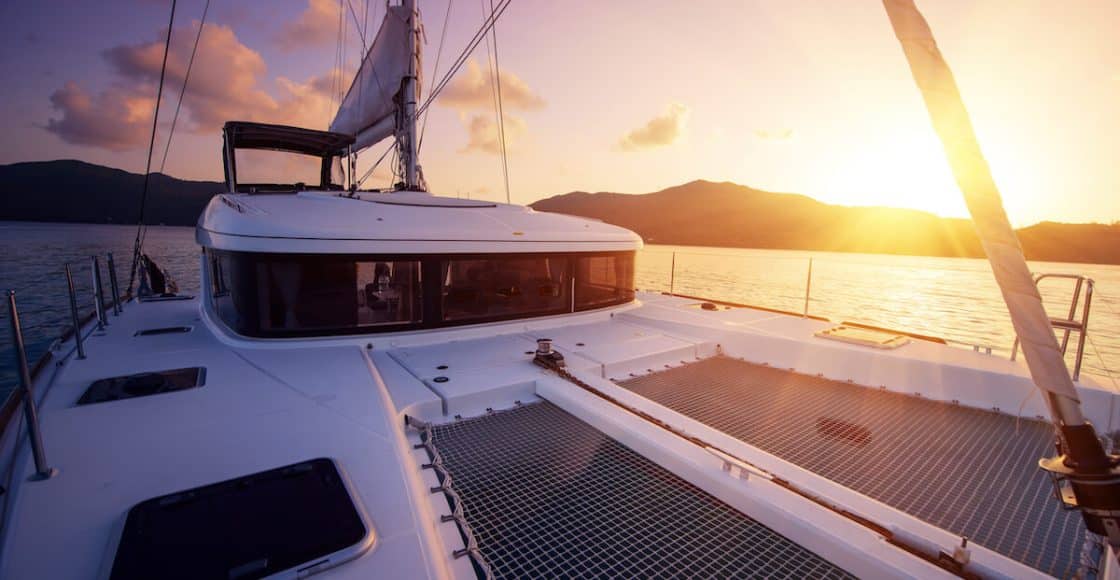
5 Best Liveaboard Boats

Table of Contents
Last Updated on November 3, 2023 by Boatsetter Team
Want to live aboard a boat? Maybe you’re looking for more affordable waterfront living, or an alternative lifestyle – either way – living on a boat has many rewards. That said, choosing the right boat will make all the difference to your happiness. Before you commit, consider these five best liveaboard boats :
- Motor yachts and cabin cruisers
- Trawlers
- Sailboats
- Catamarans
- Houseboats
Find Live Abroad Boats ready for rent here
Motor yachts and Cabin Cruisers
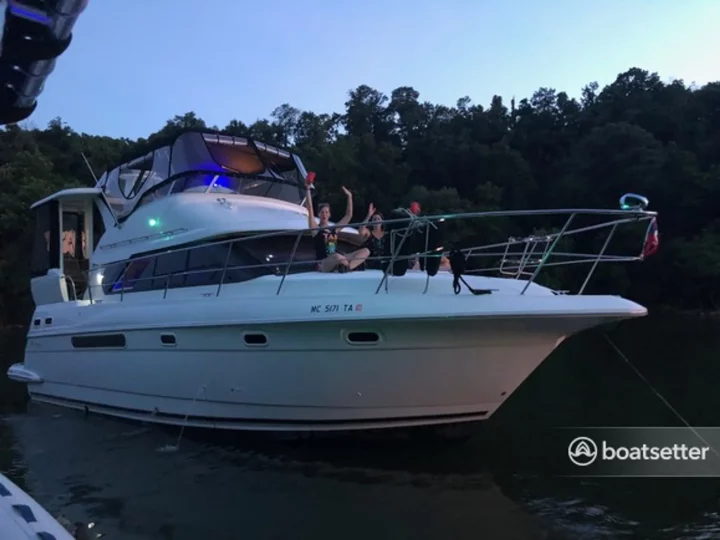
Motor yachts is a broad term that encompasses large(ish) motorboats with accommodations like a bed (sleeping cabin), a head (bathroom), and a galley (kitchen). These boats can be quite large such as an Absolute 50 with a flybridge that provides extra space for outdoor recreation/entertainment, like the backyard of a house.
Models like these usually have three cabins and two heads to accommodate an entire family. Of course, big boats come with big price tags and lots of maintenance needs, so you may not save much over living in a condo.
Consider how much space you need and check out some best liveaboard boats under 40 feet. Cabin cruisers like the Cutwater 32 are great choices. This boat has one cabin as well as a galley and lounge area (living room) with large windows that bring in lots of natural light and air.
The twin outboard engines can transport your home to new surroundings in the blink of an eye. Best of all, boats under 40 feet may save you a million dollars (literally) over large motor yachts and provide many of the same amenities.
2. Trawlers
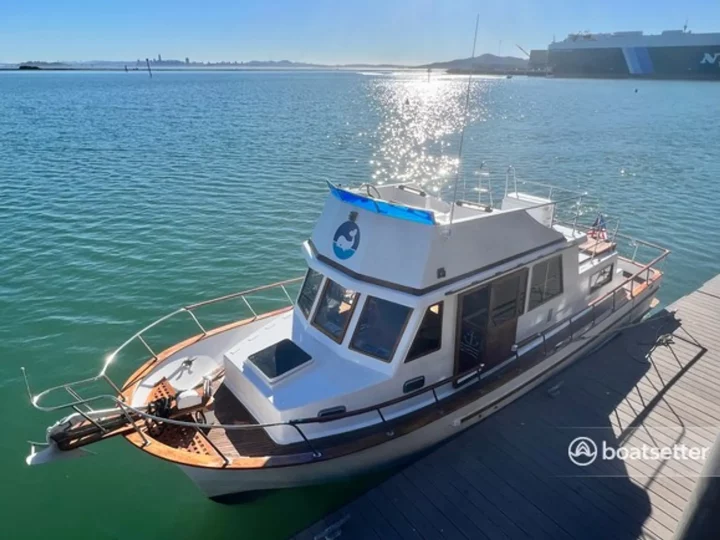
Trawlers are a great option because they are built with the liveaboard lifestyle in mind. They’re typically slower boats designed for long-distance cruising, and they come in many sizes from a large Nordhavn 60 built for tough ocean conditions to a more compact Beneteau Swift 35 that’s ideal for coastal cruising.
Most trawlers have good liveaboard layouts and will travel at speeds 8-10 knots, where they offer good fuel consumption , which is important with high diesel prices.
Pro Tip: Not all trawlers are slow – the French Swift series is designed to run at planning as well as trawling speeds, so you get the best of both.
READ MORE: Don’t Ignore Your Bucket List: Great Loop
3. Sailboats
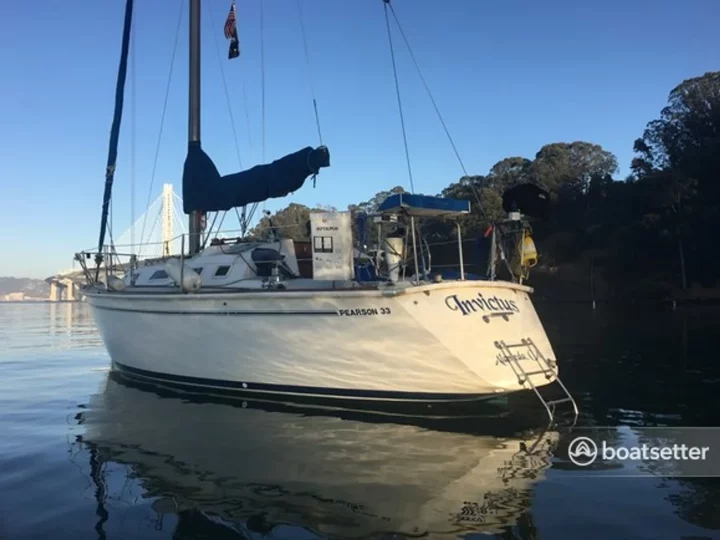
Perhaps you’re contemplating living aboard in preparation for long-distance cruising under sail. Sailboats come in all sizes, just like motor yachts, but they’re usually narrower, and most of the living aboard happens lower down in the boat, so they’re not as airy and light.
On the plus side, because space is more premium, sailboat design is very efficient, so you can pile a lot into a sailboat and still have room for sailing necessities.
Looking for a compact sailboat? Consider the Jeanneau Sun Odyssey 380 with two or three cabins in just 38 feet. For something a bit roomier, check out the new Hanse 510 . This massive model can be spec’d with up to five cabins and even has a tender garage.
The great thing about sailboats is that you can travel long distances when you want to change your neighborhood entirely – and with little money spent on fuel.
4. Catamarans
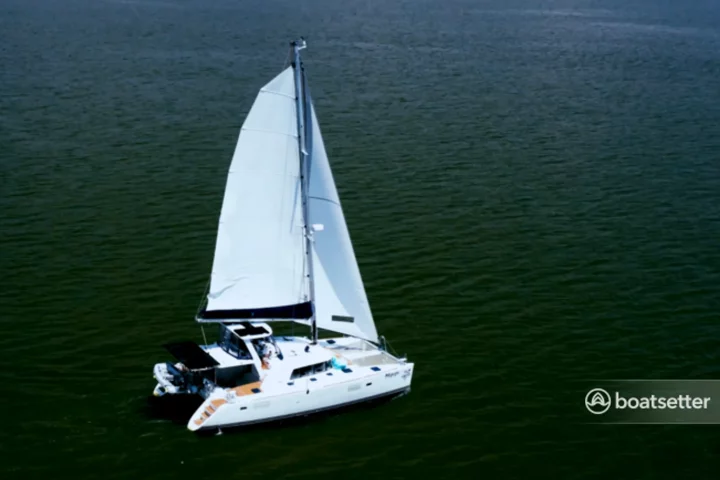
Catamarans are boats with twin hulls and they can be both power and sail models. They have many advantages including more room aboard than the same-length monohulls with better cabin privacy and more system redundancy for backup options.
They’re more stable both in motion and at anchor (dock) so they produce less seasickness and are more comfortable in a rolly anchorage at night. They’re roomy platforms for kids as well as older folks but due to their beam (width), it’s harder to find a slip for them in a marina.
Sailing cat models come in various sizes and prices. Production boats like the Fountaine Pajot Isla 40 and the Excess 11 are both around 40 feet but feel much bigger than a monohull sailboat of equal length.
Many cats come in an “owners’ version” where one entire hull is dedicated to the master suite which is like a bedroom at home. Models like these start around $500,000 but upmarket, carbon fiber, semi-custom designs like the HH55 will set you back multiple millions.
Powercats are growing in popularity and offer the same amenities as their sailing counterparts, except they have bigger engines to travel at much greater speeds. Powers can be on the smaller side, like the 32-foot Aspen C100, or quite sizeable, like the Aquila 54. Cats tend to be more expensive to purchase and to own since there are two of just about everything to maintain.
5. Houseboats
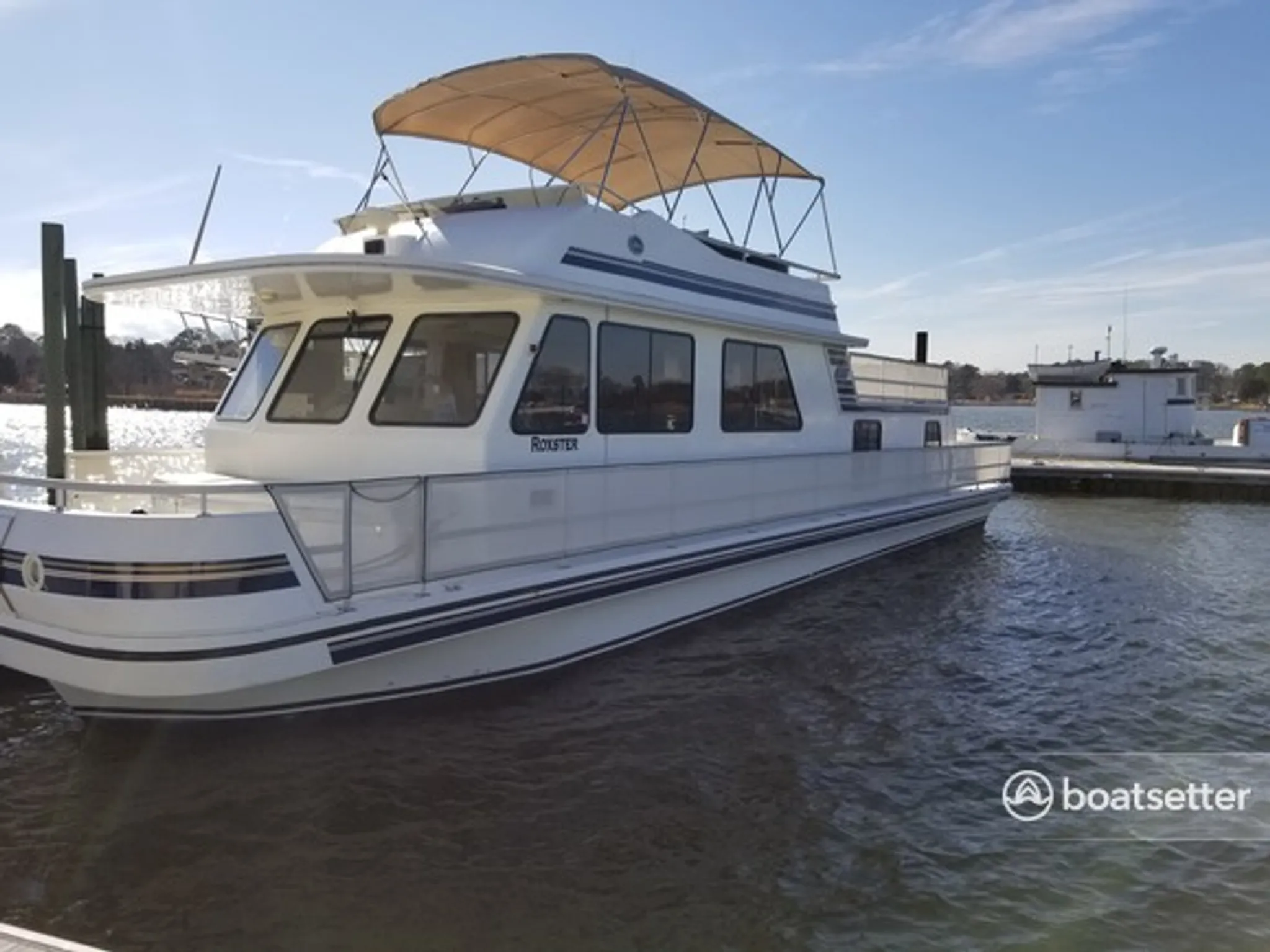
If you want to live aboard but have little interest in being mobile, you may consider a houseboat. These boats usually maximize living space and are shaped more like houses than boats. Household-sized amenities, including side-by-side refrigerators, massive sofas, and large TVs can be had.
Because they don’t require much technical gear like engines, electronics, and advanced power systems, houseboats can be quite affordable and can make the best liveaboard boats under $100k.
A few companies build houseboats like Eco-Sea Cottages, but many will be one-off and home-built designs. Although these boats don’t move (much), they must still have a solid floating foundation to be safe, and only some marinas will allow them to dock there.
One more thing to consider
There are no hard rules as to what makes a great liveaboard boat! You just have to find one that suits you and your budget. Read our Living on a Boat post for more insight, and be sure to browse through Boatsetter to find the perfect liveaboard boat.
About Boatsetter
Boatsetter is a unique boat-sharing platform that gives everyone — whether you own a boat or yyou’rejust renting — the chance to experience life on the water. You can list a boat , book a boat , or make money as a captain .
List. Rent. Earn— Only at Boatsetter

Zuzana Prochazka is an award-winning freelance journalist and photographer with regular contributions to more than a dozen sailing and powerboating magazines and online publications including Southern Boating, SEA, Latitudes & Attitudes and SAIL. She is SAIL magazines Charter Editor and the Executive Director of Boating Writers International. Zuzana serves as judge for SAIL’s Best Boats awards and for Europe’s Best of Boats in Berlin.
A USCG 100 Ton Master, Zuzana founded and manages a flotilla charter organization called Zescapes that takes guests adventure sailing at destinations worldwide.
Zuzana has lived in Europe, Africa and the United States and has traveled extensively in South America, the islands of the South Pacific and Mexico.
Browse by experience

Explore articles
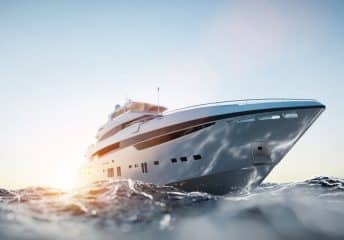
How Much Does It Cost to Charter a Yacht?

New Orleans Boating Guide
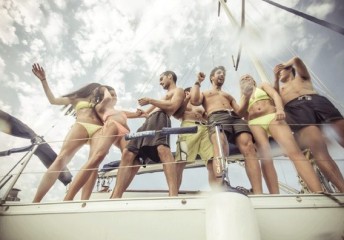
Your Tortuga Music Festival boat rental is the best seat in the house

Sailing Fanatics! Red Bull Foiling Generation is Back
- Search Please fill out this field.
- Manage Your Subscription
- Give a Gift Subscription
- Newsletters
- Sweepstakes
- Culture + Design
- Where to Live
10 Best U.S. Suburbs to Live in for Affordable Housing, Top-rated Schools, and Excellent Job Opportunities
There's more to these American suburbs than white picket fences and large backyards.
:max_bytes(150000):strip_icc():format(webp)/Dobrina-Zhekova-2885480a814f40a2801fda922af4d135.jpeg)
VickyRu/Getty Images
Suburbs are a quintessentially American concept. Developed post-World War II outside large cities to provide affordable housing for the country’s middle class, suburbs are now integral to large metropolitan areas. Today, half of all Americans live in suburbs of different densities, driven by rising costs in cities plus a desire for more space and a laid-back lifestyle. Because of that shift, suburbs are now more racially diverse than ever, offering a wide range of amenities like excellent restaurants, shops, and entertainment, but also top-rated public schools, medical centers, and recreational facilities.
And while some suburbs have managed to remain beacons of middle-class America, drawing new residents with affordable housing, in others, access to top-notch amenities comes with proportioned real estate values.
Here, we rounded up the best U.S. suburbs to live in based on feedback from expert realtors and recent livability rankings.
Johns Creek, Georgia
rodclementphotography/Getty Images
Johns Creek, a rapidly growing suburb north of Atlanta, consistently ranks as one of the area's best and wealthiest communities , with a median household income of more than $130,000. With low crime rates, excellent schools, and access to many outdoor activities (it's close to the Chattahoochee River National Recreation Area), this city of about 82,000 residents is a top choice for families in the Atlanta region.
Jessica Weston, senior vice president and managing broker at Harry Norman, Realtors , explained that one of its most highly anticipated new developments, Town Center, will have 192 acres of residential and business facilities promoting "wellness and sustainable living, further enhancing Johns Creek's already impressive lifestyle offerings."
According to Zillow , the median home value in Johns Creek is $704,470.
Cinco Ranch, Texas
Steve Gonzales/Houston Chronicle via Getty Images
As the third-best suburban community in the country, Cinco Ranch has plenty in store for its residents.
"The amenities alone make living in Cinco Ranch one of the best lifestyles to be found in the greater Houston area," Rebecca Turner, a realtor at Greenwood King Properties , said, adding that the community's resort-style facilities include three lakes, 11 pools, more than 70 playgrounds, and 231 miles of hiking and biking trails.
Families with teenage children are drawn to the area for its A+-rated high schools.
"Cinco Ranch, like most of Houston, continues to appreciate at a fast clip," added Turner. "Unlike other areas of Texas and the country, which have had to deal with a real estate reset and falling prices after the COVID-19-influenced boom, Cinco Ranch continues to be a desirable neighborhood where home values and equity are rising at a healthy rate."
The current median home value is $543,996 , and homes go to pending status in just six days.
Okemos, Michigan
Jacob Boomsma/Getty Images
Located east of Michigan's capital, Okemos has been recognized multiple times as one of the top 10 suburban communities in the country and the best in Michigan for its public schools, diversity, job opportunities, affordable housing (the median home value is $367,266 ), and parks.
The town of about 26,000 residents has an impressive number of attractions, too, including the Meridian Historical Village, which consists of seven 19th-century historic buildings; Harris Nature Center; and many parks. The town is also just a few miles from Michigan State University in East Lansing.
North Bethesda, Maryland
Benjamin C Tankersley/For The Washington Post via Getty Images
"I grew up in North Bethesda and moved back here to raise my children in the same neighborhood where I was brought up ... Between the wonderful school system, plethora of amenities, and robust recreational facilities, residents have so much at their fingertips, so much to choose from," Meaghan Miller, an agent at Long & Foster Real Estate , said of North Bethesda, a Montgomery County census-designated area that is now one of the most sought-after communities in the Washington, D.C. metro area. The community also has many restaurants, farmers markets, and cultural institutions such as The Music Center at Strathmore, transforming it into a destination in its own right.
Nationally, North Bethesda is ranked the seventh-best suburb to live in and one of the best places to raise a family in America, according to Niche.com. However, real estate prices are higher than the national average, reflecting the town's popularity and the region's high cost of living . In May 2024, the median sale price was $570,000 .
Coppell, Texas
TrongNguyen/Getty Images
With beautiful parks, top-rated public schools, restaurants, independent boutiques, and coffee shops, Coppell attracts many families and those seeking a quieter, more laid-back lifestyle close to the Dallas/Fort Worth metro area.
"It's conveniently located within a short distance to the Dallas Fort Worth International Airport and makes a wonderful location for those who travel for business and pleasure," said Deb Borrell, executive vice president of relocation at Allie Beth Allman & Associates .
Coppell also ranked as the second-best place to live in Texas (after Cinco Ranch) and the third-best place for public schools in the Lone Star State.
The current median home price in Coppell is $643,116, according to Zillow . However, Borrell pointed out that the community offers a range of housing options at various price points.
Brookline, Massachusetts
DenisTangneyJr/Getty Images
This Boston suburb may be steeped in political history (it's the birthplace of John F. Kennedy ), but it's also a desirable place to live thanks to its proximity to some of Boston's most renowned landmarks, like the Museum of Fine Arts (MFA) and Fenway Park, as well world-class medical facilities and universities.
"After years of a very strong seller's market, the Brookline housing market is becoming more balanced as inventory for single-family homes and condos continues to grow," said Dave Costello, managing director at Advisors Living , noting that as new homes arrive on the market, buyers have more choice than in years past.
However, real estate doesn't come cheap here. Brookline's median home price is $1.16 million, and more than 45 percent of listings sell for above asking price.
Brentwood, Missouri
Matt Miller for The Washington Post via Getty Images
Located just 10 miles from bustling St. Louis, Brentwood is not only the 10th-best suburb to live in America, but it's also one of the top choices for young professionals and families in the state . It offers great schools, fantastic playgrounds , and tranquil neighborhoods. But one of its main draws is the affordable housing — Brentwood's median home price of $265,681 is well below the national average.
"There are condominium communities with swimming pools and athletic facilities. Beautiful brick-front homes are set back from quiet, tree-lined streets," Janet Horlacher, owner and principal broker at Janet McAfee Real Estate , said, noting that high demand is also due to the quality of life and proximity to business centers.
"I think if you asked Brentwood residents what they like best about their area, they would say location, location, location," she added.
Carmel, Indiana
Douglas Sacha/Getty Images
The Midwest is certainly having a moment. The region is not only home to some of the most desirable retirement communities in the U.S. , but newcomers will also find the best suburb in the country here, according to Niche.com .
Carmel , a scenic city about 30 minutes outside of Indianapolis, offers excellent entertainment and cultural events to its 100,000-plus residents, a nationally acclaimed parks system , and a robust job market (the town is home to more than 125 corporate headquarters).
Plus, there's more good news for prospective homebuyers here. "Active listings are starting to increase after a significant period of low inventory," said Claire Belby, senior vice president at F.C. Tucker Company . "The area boasts lots of housing options with a good variety of production and custom builders, and a good mix of new construction to residential resale."
And while the median real estate price can easily surpass the $1 million mark in other suburban areas with similar amenities, the current home value in Carmel is $538,792 .
Short Pump, Virginia
This Virginia suburb, not far from Richmond, got its name from a tavern in the 1800s. Here, under the rickety old double porch of the rambling frame structure was a short-handled pump. In the days when the tavern was a stagecoach stop between Richmond and Charlottesville, the drivers would often say, "I'll see you at Short Pump," as the historical marker in the city reads.
Nowadays, Short Pump draws both young professionals and families thanks to a blend of excellent schools, diversity, outstanding health care facilities, entertainment, and some of the best shopping in Virginia.
"The area is also conveniently located near the I-95 and I-64 corridors, providing efficient access to Washington, D.C., Virginia Beach, Charlottesville, the Blue Ridge Mountains, and beyond," said Richard Bower, an associate broker at Joyner Fine Properties .
With new listings up 20 percent and median home values hovering around the $500,000 mark , Bower explained that Short Pump offers diverse housing options for every budget and lifestyle.
Chesterbrook, Pennsylvania
jfguignard/Getty Images
This Philadelphia suburb has been ranked among the best places to live in America for the fourth year in a row. Established in the 1970s, it is now home to just over 5,000 residents who enjoy access to top-rated schools, affordable real estate, and family-friendly amenities.
The town is close to Valley Forge National Historical Park, a sprawling recreational and educational destination that provides many opportunities for staying active.
Chesterbrook's housing market is also a major draw, with median home prices around $502,000 .
Related Articles
Screen Rant
10 best animated batman suits that put live-action dc to shame.

Your changes have been saved
Email Is sent
Please verify your email address.
You’ve reached your account maximum for followed topics.
Batman Beyond: Top 10 Fight Scenes In The Series
10 things i've learned rewatching every batman movie ever made, how to watch all batman animated series in order.
- Best animated Batman suits capture character essence and adapt to story tones effectively.
- Batman Beyond suit blends futuristic technology with unique design, making Terry stand out.
- Justice League: The Flashpoint Paradox showcases a darker, gun-toting Batman variant.
Batman ’s iconic suit has been repeatedly reimagined across animated DC movies and TV shows to varying degrees of success. The very best renditions reflect different aspects of the Dark Knight’s enduring legacy and history in the DCU timeline . From the noir-inspired designs of the 1990s to the bold, stylistic reinterpretations in more recent series, these animated suits offer a fascinating glimpse into how Batman's visual identity has evolved over the years.
The best Batman suits in animated Batman movies and series capture the character's essence and adapt to the thematic and narrative tones of their respective stories. Whether it’s the classic gray and blue ensemble of Batman: The Animated Series or the gritty, modern look of the Batman Beyond suit, each design contributes to the storytelling and characterization of Batman in unique ways. These suits balance classic elements with innovative tweaks, ensuring that Batman remains both instantly recognizable and fresh.
10 Amazing Details From Batman Movies You Never Noticed
The Batman movies are brimming with incredible details and Easter eggs, foreshadowing major events and celebrating its iconic comic book history.
10 Terry McGinnis's Batman Suit
Batman beyond.
Terry McGinnis's Batman suit from Batman Beyond is a remarkable and effective piece of technology that perfectly fits the show's futuristic tone. Sleek and high-tech, the suit embodies the advanced capabilities of the future Gotham City. It features a striking black and red color scheme, providing a visually distinctive look that sets Terry apart from previous incarnations of Batman.
One of the suit's most notable characteristics is its functionality. Equipped with built-in gadgets and weapons, it includes enhanced strength, agility, and cloaking abilities, making Terry a formidable force against crime. The suit also integrates advanced flight capabilities through retractable wings and rocket boots, compensating for the absence of Batman's traditional cape . While the lack of a cape might initially seem like a departure from the classic Batman aesthetic, it reinforces the show's commitment to a futuristic design.
*Availability in US
Not available
Batman Beyond is an animated action-adventure television series set twenty years after the events of Batman: The Animated series. Bruce Wayne, now in his twilight years, continues to fight crime with new gadgets, suits, and tech - but his old age has revealed that even the Caped Crusader has limits. Enter Terry McGinnis, a teenager with athletic prowess and a strong sense of justice. When pursued by a gang one night, Terry is helped by the elderly Bruce Wayne - an event that leads to Terry's training as the new generation Batman.
A sequel to Batman: The Animated Series, Batman Beyond was about Bruce's Wayne's apprentice, Terry McGinnis. It featured some great fights.
9 The Vintage Batman Revival
Batman: return of the caped crusaders.
In Batman: Return of the Caped Crusaders , Batman's suit is a delightful homage to the classic 1960s design, capturing the fun and retro spirit of the era. The animated version of this iconic costume brings out the vibrant colors and playful elements that defined Batman in the swinging '60s. The bright blue and gray suit, complete with the yellow-encircled bat symbol and the exaggerated eyebrows on the cowl, is instantly recognizable and nostalgically charming.
This animated adaptation breathes new life into the classic design , making it more dynamic and visually appealing than it ever appeared in live-action. Animation allows for fluidity and expressiveness that live-action suits often lacked due to the practical limitations of costume materials and movement. In Return of the Caped Crusaders , the suit’s vibrant colors and elegant lines are accentuated, enhancing the overall visual appeal.
8 Samurai Batman
Batman ninja.
Batman's suit in Batman Ninja is a visually stunning reimagining of the iconic costume, blending traditional samurai armor with Batman’s classic elements. This striking design is undeniably cool and attractive, fitting perfectly within the film's beautiful and intricate animation style. The suit features a combination of black and gold hues, with detailed armor plating, a flowing cape resembling a warlord's cloak , and a samurai helmet that incorporates Batman's signature bat ears.
The suit's aesthetic captures the essence of feudal Japan, adding a unique and culturally rich dimension to Batman's character. It is designed to be both intimidating and elegant, making Batman look like a fearsome warrior straight out of Japanese history. The intricate details and artistic craftsmanship make it one of the most visually captivating versions of Batman’s suit ever created. However, the suit does lack some practicality and essential design features typical of Batman's attire.
7 The Gun-Toting Batman Variant
Justice league: the flashpoint paradox.
In Justice League: The Flashpoint Paradox , Batman's suit is an effective and striking design that stands out for its unique blend of classic elements and darker, grittier details . This version of Batman, portrayed as Thomas Wayne in the alternate Flashpoint timeline, sports a costume that is both stylish and intimidating. The suit retains the iconic bat symbol, cape, and cowl, ensuring it remains instantly recognizable as Batman.
However, this Batman suit diverges from the traditional design with the addition of gun holsters, reflecting Thomas Wayne's more ruthless approach to crime-fighting. The inclusion of firearms signifies a stark contrast to Bruce Wayne's no-kill policy , highlighting the darker, more brutal world of the Flashpoint universe. The suit's black and red color scheme further enhances this menacing aesthetic, giving it a more aggressive and militaristic appearance. It effectively communicates the character's divergence from the traditional Batman ethos, making it a fitting and powerful design.
Justice League: The Flashpoint Paradox (2013)
Justice League: The Flashpoint Paradox revolves around Barry Allen, known as The Flash, who inadvertently creates an alternate timeline after going back in time to prevent his mother's murder. Directed by Jay Oliva, the film features an altered reality where the Justice League is replaced by conflicting heroes and villains, with cataclysmic consequences. This animated feature showcases the complexities and ramifications of time travel within the DC Universe.
6 The Grizzled And Mature Batman Suit
Batman: the dark knight returns.
In The Dark Knight Returns , Batman's suit amplifies the character's gothic and serious nature. This version of the suit is an even more somber and intense iteration of the classic Batman: The Animated Series suit. It features a bulkier, more imposing build, with pronounced musculature that reflects Batman's older, more seasoned persona . The suit’s color scheme is darker, with deep blacks and grays dominating the palette. This enhances the suit’s creepy presence and aligns with the film's darker tone.
The bat symbol on the chest is larger and more pronounced, making a bold statement about Batman's enduring legacy and his return to Gotham after years of retirement. Additionally, the suit incorporates heavy armor plating, emphasizing Batman's need for increased protection as he confronts a more brutal and chaotic Gotham City. This practical aspect of the design underscores the high stakes and physical challenges Batman faces in the story.
Batman: The Dark Knight Returns, Part 1
Based on the dark and gritty graphic novel, The Dark Knight Returns Part One is an animated action film set in the same world as Batman: Year One. The film follows a retired Batman following the death of the last Robin ever taken under his wing, Jason Todd. Two-Face, having been released and supposedly reformed, and a sudden wave of major crimes forces Bruce Wayne to don the cowl once more as an aged and far more brutal Batman, but even takes on a new Robin protege named Carrie Kelley.
Batman has appeared in many movies over his cinematic history, and rewatching every one of them brings several interesting points to light.
5 The All-Black Batman Suit
Batman vs robin.
Batman’s suit in Batman vs Robin is an effective design that stands out with its all-black rendition of the classic suit. This version of the suit is cool and slick, embracing a minimalist aesthetic that highlights Batman's stealth and intensity. The all-black design gives Batman a shadowy, almost spectral presence, fitting perfectly with his role as a nighttime vigilante. The suit retains the iconic bat symbol on the chest, albeit in a more subdued, black-on-black fashion, which adds to the overall effect.
While this design lacks some of the intricate details seen in other iterations, such as armor plating or contrasting colors, its simplicity is part of its appeal . The streamlined look emphasizes Batman's agility and stealth, essential traits for his crime-fighting methods. Despite its simplicity, the suit remains very fun and visually striking. It captures the essence of Batman's character - mysterious, formidable, and ever-ready to strike from the shadows.
4 The Iconic Animated Batman Suit
Batman: the animated series.
Batman’s suit in Batman: The Animated Series is a timeless design that has become quintessential for the character . With its clean lines and classic color scheme, this suit perfectly balances the elements of intimidation and heroism. The gray bodysuit, blue cowl, cape, gloves, and boots, paired with the iconic yellow-encircled bat symbol on the chest, create a visually striking and easily recognizable look.
This design captures the spirit of Batman, blending the dark, brooding aspects of his character with the bold, heroic traits. The suit’s simplicity and elegance make it stand out, allowing it to become an iconic representation of Batman for many fans. While not as intricate or heavily armored as some later designs, this suit’s straightforward approach is part of its charm. The streamlined look fits perfectly with the show’s noir-inspired art style , reinforcing the timeless and classic feel.
Batman: The Animated Series is an award-winning adaptation of the Batman mythos. Remembered for its groundbreaking art style and orchestrated soundtrack, Batman: The Animated Series features the Caped Crusader and countless characters from his rogues' gallery. Kevin Conroy lent his now-iconic voice to the Dark Knight, with the show also featuring the voice talents of Mark Hamill (as the Joker) Arleen Sorkin (Harley Quinn), John Glover (the Riddler), Ron Perlman (Clayface), and David Warner (Ra's al Ghul).
3 Victorian-Era Batman
Gotham by gaslight.
Batman’s suit in Gotham by Gaslight is a standout design that offers a cool Victorian and noir-inspired reinterpretation of the iconic costume. This version takes the essential elements of Batman's attire and infuses them with a gloomy, 19th-century aesthetic, perfectly fitting the film’s alternate history setting. The suit features a dark, almost black color palette, complemented by a high-collared cape and a more rugged, utilitarian look.
The cowl is more angular and menacing, with shorter bat ears, evoking the gothic atmosphere of Victorian Gotham. The utility belt, while retaining its classic functionality, is designed to look like vintage leather, adding to the period authenticity. This redesign is effective because it maintains the core aspects of Batman's look and integrates the character into a different era. The gloomy and foreboding aesthetic enhances Batman's mysterious presence , making him a perfect fit for the foggy, gaslit streets of the Victorian era.
Batman is undoubtedly one of the most popular superheroes of all time, and DC's Dark Knight has stared in a bevy of animated series over the decades.
2 Batman's Muted Color Redesign
Justice league dark.
In Justice League Dark , Batman’s suit ranks as the second-best animated Batman suit. This suit features muted colors, with a dark gray bodysuit and a black cowl, cape, gloves, and boots, creating a more cinematic and realistic appearance. The absence of bright yellow elements, such as the oval bat symbol or the utility belt, gives the suit a sleek and modern look.
This color palette enhances Batman’s stealth and intimidation factor, making him appear even more menacing in the darker and more mystical setting of Justice League Dark . The bat symbol on the chest is simple and bold, matching the suit's overall minimalist design. This iteration of Batman’s suit is effective because it aligns perfectly with the tone of the movie . It’s practical and visually appealing, capturing the essence of Batman’s character while adapting to the film’s aesthetic.
1 The Tomorrowverse Batman Suit
Long halloween & legion of superheroes.
The best-designed animated Batman suit is showcased throughout the DCAU’s Tomorrowverse , standing out as an exceptionally effective rendition of the Dark Knight. This suit strikes a perfect balance between comic accuracy and modern sensibilities , avoiding any hint of corniness. It remains true to the classic Batman look, featuring the traditional gray bodysuit, black cowl, cape, gloves, and boots, with the iconic bat symbol emblazoned on the chest.
What makes this suit particularly effective is its ability to honor Batman’s comic book origins while updating the design to appear stylish and contemporary. The muted color palette and smart lines contribute to a more refined and sophisticated appearance. The utility belt, while functional, is seamlessly integrated into the overall design, maintaining a streamlined look. The suit's versatility is another key aspect of its effectiveness. It fits perfectly within the varied tones and settings of the Tomorrowverse , whether Batman is engaging in intense combat, conducting investigations, or strategizing with the Justice League.
| Upcoming DC Movies | Release Date |
|---|---|
|
| October 4, 2024 |
|
| July 11, 2025 |
|
| June 26, 2026 |
|
| October 2, 2026 |
Texas ranked worst state to live in the US, see where other states stand
How does life in your state compare to the rest of America?
CNBC released its rankings of the best and worst states to live in the United States last week.
Its rankings come from the network's yearly research on the best states for business in 2023. One of the 10 criteria for the list is Life, Health & Inclusion, from which CNBC determines the best and worst states to live.
CNBC allots 350 possible points to each state, measuring categories such as per capita crime rates, environmental quality, health care and worker protections.
The research also examines anti-discrimination laws, voting rights and access to childcare. Surveys indicate a large percentage of women consider reproductive rights in deciding where they are willing to live and work, so CNBC includes abortion laws in this category.
Texas ranked the worst state to live in the US
Texas has received the number one spot on a not-so-pleasant list: The top 10 worst places in America to live and work in 2023.
While Texas landed at number six on CNBC's yearly America's Top States for Business study , the state scored significantly low in one category: Life, Health & Inclusion. Factors in this category include:
- crime rates
- environmental quality
- health care
- quality and availability of childcare
- inclusiveness in state laws such as reproductive rights, protections against discrimination and voting rights.
Texas received 53 out of 350 points for its 2023 Life, Health & Inclusion score, giving it an F in its Top States grade and the lowest nationwide, securing its number one spot on the list.
CNBC did mention the boom in economic opportunity across the state. In the overall Top States for Business study, Texas received sixth place, with North Carolina taking the number one spot.
Top 10 worst states to live and work
The rest of the states that landed on the top 10 worst states to live and work for 2023 were:
- South Carolina and Alabama (tie)
Vermont ranked the best state to live in the US
By contrast, Vermont won the acclaimed spot of the best place to live . Residents are statistically more stress-free and healthy. With the beautiful Green Mountains, Vermont offers the best air quality in the United States. The state provides the most accessible childcare, broad anti-discrimination protections and easy access to voting.
CNBC gave Vermont an A+ in Life, Health and Inclusion. The state's largest weakness is worker protections, which are less stringent compared to some other states.
Top 10 best states to live and work
- Massachusetts and Colorado (tie)
- Connecticut
America's top states for Business
CNBC examines on 86 metrics in 10 broad categories of business competitiveness when assigning its rankings. The research examines the workforce, infrastructure, cost of doing business, state laws and education, among other criteria.
Here is CNBC's ranking for 2023.
- North Carolina
Looking to live offline? Indiana spots appear in top 150 counties nationally

Are you looking to get away from your hectic day-to-day life or the hustle and bustle of a large urban city? A recent study from BusinessElectric.com found the top 150 counties in the nation for off-grid living, which just might offer a more serene and peaceful lifestyle.
Here's what we know.
Indianapolis WWE announces Indianapolis as host city for future WrestleMania, SummerSlam, Royal Rumble
Best Indiana counties for off-grid living
In a poll of 3,000 people nationwide, BusinessElectric.com found these counties to be the most popular choices in the Bluegrass State for off-grid living.
No. 82: Brown County
Brown County, located in south central Indiana and about an hour from Indianapolis, has a population size of just over 15,000 people, according to data from the U.S. Census Bureau. The median household income is $74,933 with a 55.4% employment rate.
No. 146: Greene County
Greene County, located in southwest Indiana, is about an hour and a half from Indianapolis. According to Census data, the county has a population size of more than 30,000, an average annual income of $57,771 and an employment rate of 54.1%.
Top 10 U.S. counties for off-grid lifestyle
According to the study, the top ten counties are as follows.
- Wasco County in Oregon
- Hot Springs County in Wyoming
- Meriwether County in Georgia
- Bienville Parish in Louisiana
- Somerset County in Maine
- Litchfield County in Connecticut
- Lake County in Michigan
- Harney County in Oregon
- Pope County in Illinois
- Rabun County in Georgia

How To Live on a Sailboat

Last Updated by
Daniel Wade
June 15, 2022
Living on a sailboat can be a rewarding experience, especially if you come prepared and make strategic lifestyle adjustments.
Living on a sailboat is possible if you find the right boat, stay organized, manage maintenance and utilities effectively, make an income, and choose a suitable marina. Anyone who follows these steps can live a frugal and comfortable life on a sailboat.
In this article, we’ll cover all the major points and lifestyle adjustments necessary to live a clean and comfortable life on a sailboat. Additionally, we’ll cover some of the benefits and go over the technical steps you’ll need to take to keep your boat in good shape.
We sourced this information from experienced liveaboards and included the lessons they learned from living on a boat.
Table of contents
Decide if the Liveaboard Life is Right for You
Living aboard a sailboat can be a rewarding and life-changing experience. Many live aboard for adventure, and others choose to live a more laid-back lifestyle and reduce their living expenses. Regardless of your reasoning, it’s important to consider the realities of living aboard and the sacrifices you’ll have to make.
Living aboard requires careful attention to maintenance, good organization, and an actual desire to live the lifestyle. You can successfully live on a sailboat without experience if you’re willing to make some changes to your lifestyle, reduce the amount of stuff you own, and stay on top of maintenance.
Is Living Aboard Common?
Yes, many people live aboard sailboats. It’s legal in most places, and there’s a relatively large online community dedicated to the practice. The majority of people who live on sailboats do it because they love sailing and the lifestyle.
Liveaboard Sailboat Utilities
Like a house, your sailboat needs utilities if you plan to live aboard. These systems have been well-integrated over the years, so it’s pretty easy to get power, water, and fuel for living aboard. Here’s how utilities work on a liveaboard sailboat.
Power, Water, and Sewage
When living in a house or apartment, the only time you really have to think about power, water, and sewage is when the bill is due—or when it stops working. On a sailboat, these things aren’t so hands-free.
Boats store water and sewage in tanks. Usually, a sailboat has a freshwater tank (for drinking) and a greywater/black water tank (for sewage). Eventually, these tanks will be full and need to be dumped, but you don’t have to rely on your freshwater tank when living aboard.
Most liveaboards hook their sailboats up to shore power using a special marine extension cord and a dock outlet. Water is connected this way as well, and some marinas offer sewage hookups at each dock.
However, you’ll probably have to pump out your septic tank at a separate location every so often. Plus, marinas charge for power and water.
Saving Water and Power on a Sailboat
Conservation is key to a convenient and clean life on a sailboat. You may have unlimited fresh water from a shore connection, but your septic tank will eventually get full. This may necessitate taking shorter showers and other water-saving steps, which are good habits to develop anywhere.
Additionally, your sailboat’s electrical system is designed to operate with or without shore power. This makes it relatively easy to install solar panels or a wind turbine, which (with a battery bank) can completely eliminate your dependence on shore power.
Liquid Fuel
Sailboats usually don’t have electric or gas appliances. Instead, sailboat stoves and heaters usually run on liquid fuel such as kerosene, alcohol, or diesel. Unlike a house, you’ll need to haul in fuel and use it safely and conservatively.
Alcohol stoves are the cleanest, but diesel heaters are the most common. These systems must ventilate correctly and be free of leaks, and you have to clean them once or twice per season to ensure safe and efficient operation.
Liquid Fuel Alternatives
Liquid fuel can be messy, smelly, and dangerous if used or stored improperly. Most sailors don’t like having a diesel tank in their living room (understandably so), so they use practical alternatives.
For heating, you can use an electric heater when connected to shore power, provided your wiring is safe enough. Figure out what gauge of wiring your 110-volt system uses, and hire an electrician to retrofit it if the wiring is too thin.
Another alternative is propane, which is cheap and cleaner than diesel or kerosene. Propane stoves used for camping fit on top of liquid-fuel stoves, and they’re a great choice for cooking when in the dock. Additionally, portable indoor propane heaters can be used, provided you have adequate ventilation.
CO Detection
Always install at least one carbon monoxide (CO) detector in your boat, regardless of what kind of fuel you use inside. A sailboat cabin is essentially a ziplock bag and the perfect environment for carbon monoxide to settle.
Install the meter near the floor, as carbon monoxide tends to sink. Additionally, an extra meter in your sleeping area is a great idea as well. Always test your meter before using a propane heater inside, and keep a window cracked or a vent fan on regardless of the outside temperature.
How to Choose a Sailboat to Live Aboard
Choosing a sailboat to live on is the first step in the process. You’ll have to first determine what kind of a sailboat you want, your budget, and what level of space and comfort you’re looking for.
The smallest feasible liveaboard sailboat (in which you can be hygienic and stand up straight) is about 20 feet in length, though the average size ranges from 26 feet to 40 feet. This is strictly speaking for monohull sailboats, as multihulls like catamarans have very different size and space standards.
The average comfortable liveaboard for one or two people is about 30 feet in length. A boat like this is affordable on the used market and includes everything you need to live a normal and healthy life.
A 30-foot sailboat almost always includes a shower, a full-size marine galley for cooking (with an icebox), a comfortable sleeping area, and a separate space for dining and working. You’ll likely have additional sitting areas too, and a chart table for navigating.
Anything beyond 30 feet will add additional space, but the accommodations will be about the same. A boat 25 feet and longer will likely have good standing headroom, which is a necessity for the vast majority of liveaboards.
Liveaboard Sailboat Prices
Finding a boat is largely a budget issue. Thankfully, there are lots of used sailboats on the market that are suitable to live in and relatively inexpensive. New sailboats cost upwards of $150,000–but don’t use this price as a benchmark for used sailboats.
The majority of suitable liveaboard sailboats can be found for less than $50,000, and a little bit of searching can get you a nice liveaboard for $10,000 or less. This makes the lifestyle an affordable option for many people, especially if you have a house or a car to sell prior to purchasing your boat.
The price of a used sailboat doesn’t necessarily predict its value or condition. Used sailboats, especially those 30 to 50 years old, don’t have pricing guides like cars do. Additionally, the maintenance and docking requirements often prompt owners to sell for far less than they’re worth.
Sailboat Accommodations
The minimum accommodations you’ll need to live aboard are a galley (kitchen), a table for eating and working, and a head with a toilet and a shower. Almost all cabin sailboats have a berth (bed), even if they don’t have anything else.
You’ll want a sailboat with electrical power too. Most sailboats produced after the 1940s are equipped with electric lighting and outlets, so just make sure that they work. All of these features can be found on sailboats 25 feet and larger.
Sailboat Condition
Condition is another important element to consider, and it can make or break your liveaboard experience. A sailboat with mold, leaks, a messed up electrical system, or other systemic problems can hamper the quality of life and be more trouble than it’s worth.
Cosmetic repairs are much easier to deal with than other problems, and you can always reupholster the interior. When given the option, choose a sailboat that’s solid and sanitary over one that looks good but has serious issues.
How to Stay Organized on a Sailboat
Staying organized is a big part of living aboard, and it can make the experience much more enjoyable and practical. In fact, liveaboards say that staying organized is one of the most important skills to develop. Here are some tips for staying organized aboard a sailboat.
Downsize Your Tools
Everyone needs a certain set of tools to live a clean and healthy life. These include cleaning equipment, dishes, pots and pans, and so on. On a sailboat, your primary constraints are space, power, and water, so you’ll have to develop a system that makes the most out of each.
Start with your cleaning equipment. Toss out that large vacuum and replace it with a dust buster. A well-made dustbuster-type vacuum can easily keep a sailboat clean, even if you have pets. It’s worth splurging on the best one you can find, as you’ll get more out of the space and electricity with a high-quality unit.
Next, change your habits to reduce the amount of cleaning you have to do. Try to minimize crumbs and spills by eating only at the table, and use glasses designed for sailboats.
Additionally, you can reduce the size of your cooking utensils and wash them immediately instead of using a second or third pan before doing the dishes. You’d be surprised by how much stuff you can do without if you’re conscientious about what you use.
Dedicate Storage Spaces
Dedicate storage spaces aboard to specific types of items. For example, choose a cupboard for cleaning supplies and figure out how to fit everything you need inside. Keep safety equipment in one area, and be sure to separate dirty from clean items.
For example, you can choose a cockpit locker for storing sails, engine tools, and other items to keep the smell and grime of diesel fuel, oil, and fiberglass resin away from your living space. Sailboats are often filthy because outdoor items are stored inside, but you can break this trend by separating them into logical spaces.
Many sailors store clothing underneath sitting areas, and you can keep them clean by using vacuum-seal bags or plastic boxes. Glasses can be stowed overhead, and books can be kept on exposed shelves.
Buy Smaller Items
This will cost more initially, but using supplies conservatively can offset the cost. Things like soap bottles, toothpaste tubes, and paper towel rolls are usually purchased in bulk but are available in smaller quantities.
It’s cheaper to buy in bulk, this is true. But some items that take up lots of space in bulk simply aren’t worth sacrificing a sitting area or an entire box of clothing for. Over time, you can use the smaller quantities to become aware of how much you use and how to reduce costs.
Reduce Garbage
We produce a lot of trash. Trash is the most useless waste of space aboard a sailboat and also one of the worst contributors to unpleasant odors and unsanitary conditions. The simplest solution is to stop using as much disposable stuff as possible.
A dish rag used instead of paper towels will reduce costs, save space, and last infinitely longer. Avoid buying items with excessive packaging, and if you do, dispose of the package onshore before bringing it aboard.
This is a great opportunity to eat healthier, too. Many liveaboards live without a microwave, as it saves space and vastly reduces the amount of processed food and food packaging trash you produce.
Instead of throwing out extra food every day, cook portions that you can finish. You’ll have to shop more often, but you’ll have more fresh food every day and your health will improve in the long run.
Downsize Your Stuff Collection
The most dramatic shift that new liveaboards have to contend with is the lack of space. There’s simply not enough space on a sailboat to store years of stuff. Unused Christmas presents, old shoes, that workout machine you got at a yard sale—it’s all gotta go.
Things like photo albums and hard drives should be kept (maybe offsite), but other items can almost always be disposed of one by one.
An easy way to choose what to donate or throw away is to lay everything out on your driveway and sort through each item individually. Address each item one by one, and decide if it’s indispensable. After you’ve chosen all of the things you need, the rest of the space can be used for the things you don’t need but want to keep.
How to Make Money Living on a Sailboat
Another necessity when living aboard is money. Unless you’ve got a major nest egg, you’ll need to work and make a living somehow. Decades ago, this was complex, as there were few jobs on the waterfront that paid well and didn’t break your back. But today, you can make a full-time living without stepping foot onshore.
Remote Work and Freelancing
Remote work is the best prospect for making a liveaboard income. The minimum required to survive is between $1,000 and $2,000 per month, and virtually everyone can utilize or learn a skill to make money online.
Freelance careers, such as writing, web design, or coding, are a great option if you have the skills or want to learn, and entry-level opportunities are available. Additionally, personal assistant jobs are a way to go if you have experience in that field or want to give it a shot.
If you already have a job, enquire if it’s possible to work remotely. Today, many types of work can be accomplished remotely, including everything from mortgage underwriting to accounting.
Living aboard is the perfect opportunity to start a career, such as photography. The reduced expenses and location give you an opportunity to learn the ropes without going broke in the interim, and you can do virtually everything involved with an internet connection and shore power.
Boat Repair
Living aboard a sailboat puts you in the best environment for boat repair work. Skilled mechanics, carpenters, and handymen can find work almost anywhere that boats are stored. You’ll have to ask around, but liveaboard mechanics are indispensable in many areas.
Engine repair pays very well—upwards of $50/hour—as local mechanics like liveaboards can charge below shop rates. Fiberglass and hull cleaning gigs can net several hundred dollars per boat, and cosmetic/interior repairs also pay generously.
Finding a Place to Dock
Finding a marina is one of the most frustrating steps to living aboard, as location has a big impact on cost and the viability of living aboard. Some marinas encourage liveaboards, but others ban it outright.
A good medium is a clean marina with a few liveaboards, as these areas encourage responsible living and quickly expel people who don’t respect the area. Piles of garbage on derelict boats are unsanitary and shouldn’t be found in the best marinas.
The best way to find a marina is to call all the local docks and inquire about living aboard, price, and general atmosphere. Additionally, pay each marina a visit to see what it’s like in person. Try to talk with other liveaboards about marina management, hidden costs, and how they like the experience. This can save headaches down the road.
Where to Learn More
The liveaboard community online is sizable, especially on platforms such as YouTube. If you’re looking for insights, spend some time on the internet searching for videos and forums on the topic.
Lots of channels are dedicated entirely to living aboard, and you can learn a lot about day-to-day tasks and realities. It’s an excellent opportunity to learn vicariously and improve your liveaboard experience, and it gives you an opportunity to meet other people who share your new lifestyle.
Related Articles
I've personally had thousands of questions about sailing and sailboats over the years. As I learn and experience sailing, and the community, I share the answers that work and make sense to me, here on Life of Sailing.
by this author
Most Recent

What Does "Sailing By The Lee" Mean?
October 3, 2023

The Best Sailing Schools And Programs: Reviews & Ratings
September 26, 2023
Important Legal Info
Lifeofsailing.com is a participant in the Amazon Services LLC Associates Program, an affiliate advertising program designed to provide a means for sites to earn advertising fees by advertising and linking to Amazon. This site also participates in other affiliate programs and is compensated for referring traffic and business to these companies.
Similar Posts

How To Choose The Right Sailing Instructor
August 16, 2023

Cost To Sail Around The World
May 16, 2023

Small Sailboat Sizes: A Complete Guide
October 30, 2022
Popular Posts

Best Liveaboard Catamaran Sailboats
December 28, 2023

Can a Novice Sail Around the World?
Elizabeth O'Malley

4 Best Electric Outboard Motors

How Long Did It Take The Vikings To Sail To England?

10 Best Sailboat Brands (And Why)
December 20, 2023

7 Best Places To Liveaboard A Sailboat
Get the best sailing content.
Top Rated Posts
Lifeofsailing.com is a participant in the Amazon Services LLC Associates Program, an affiliate advertising program designed to provide a means for sites to earn advertising fees by advertising and linking to Amazon. This site also participates in other affiliate programs and is compensated for referring traffic and business to these companies. (866) 342-SAIL
© 2024 Life of Sailing Email: [email protected] Address: 11816 Inwood Rd #3024 Dallas, TX 75244 Disclaimer Privacy Policy
NASCAR Cup Series race at Indianapolis: Live updates, highlights, live leaderboard of Brickyard 400

The NASCAR Cup Series returns to the Brickyard on Sunday for the first Brickyard 400 on the Indianapolis Motor Speedway oval since 2020.
The Cup Series moved from the oval to the road course at IMS from 2021-23, a move that becomes more curious as the years pass and certainly now with the return to the oval.
Tyler Reddick is on the pole and appears to have the fastest car at the start of Sunday's race after leading the practice session on Friday.
Follow along with our live race updates, with green flag set for after 1:30 p.m. CT on Sunday.
BRICKYARD HISTORY: NASCAR returns to the Brickyard: History of Cup Series at Indianapolis Motor Speedway oval
EXPERT PICKS: NASCAR Indianapolis predictions 2024: Expert picks for Cup Series Brickyard 400 race
NASCAR Cup Series race at Indianapolis: Live updates, highlights, live leaderboard for Brickyard 400
LIVE LEADERBOARD: Full field leaderboard of NASCAR Cup Series Brickyard 400 at Indianapolis
Postrace coverage
ONE MORE TRY AT THE DOUBLE: Kyle Larson wins NASCAR's Brickyard 400, teases return to Indianapolis 500 in 2025
RACE RESULTS: Who won NASCAR Cup race in Indianapolis? Winner is Kyle Larson, plus full results
POINTS STANDINGS: NASCAR playoff picture: Cup Series points standings after Indianapolis
Kyle Larson wins!
Kyle Larson holds off Ryan Blaney on the restart, who is also passed by Tyler Reddick for P2.
Ryan Preece spins down the backstretch before the white flag, Larson takes the white flag, Preece continues to be stalled out at the bottom of the track and the caution is out as the field passes through turns 1 and 2. That was a suboptimal race management decision by NASCAR -- Preece was stalled out before the white flag. That incident occurred about a half-lap before Larson took the white flag. Preece also made contact with the inside wall on the backstretch, which usually produces a caution flag in any situation. Not good from NASCAR.
Either way, Kyle Larson wins the Brickyard 400.
NASCAR Indianapolis TV schedule: Brickyard 400 race will finish on USA Network
The Brickyard 400 TV coverage will conclude on USA Network as local news takes priority given the day's headlines nationwide.
Red flag after a multi-car crash
John Hunter Nemechek turns down across Daniel Hemric's bumper, hits the end of the pit road wall and comes back across the field into turn 1, causing a multi-car crash. Denny Hamlin is done for the day, along with Nemechek. Alex Bowman is involved, as is Chase Briscoe.
Kyle Larson is the leader, moving up a row after Brad Keselowski was out of gas and taking the lead into turn 1. Ryan Blaney is not happy with NASCAR.
Brad Keselowski is out of gas heading to green
Brad Keselowski is out of gas before taking the green flag and dives down pit road with the pace car! Green flag!
CAUTION FOR KYLE BUSCH!
Brad Keselowski's strategy may now be done for, as Kyle Busch spins from inside the top 10. It's been a stunning season for Busch, and he has another solid run turned into a poor finish.
"It's going to be really, really tight," the No. 6 team tells the leader.
Zane Smith and Denny Hamlin pit from the top five. Keselowski stays out, even though he has 10 more laps on this tank. Green-white-checkered finish upcoming.
Lap 153: Kyle Larson to P3
Kyle Larson passes Daniel Hemric for third, and Hemric pits.
Lap 146: Kyle Larson is into the top 5
Denny Hamlin is told to go but he can't shift. Kyle Larson's pace is making Hamlin up the pace. Hamlin is told to go back to saving again, and Larson passes Hamlin for fifth.
Larson is in a really good spot here.
Lap 135: Kyle Larson is flying up the leaderboard
Kyle Larson is up to P12, ahead of Tyler Reddick and with enough fuel to make it to the end. What strategy will win out here?
Lap 130: Brad Keselowski leads, but....
Brad Keselowski leads Ryan Blaney after the restart. Keselowski and Daniel Hemric (in 4th) will need to pit without significant caution help. The majority of the top 10 all need caution help of varying degrees.
Tyler Reddick is the lead car among those who should be able to comfortably make it on fuel.
Lap 124: Caution as the leaders pit!
Chase Elliott and Tyler Reddick pit as the caution is out for Martin Truex Jr. Truex spins off of turn 2 and hits the wall. He was well off the pace with the earlier damage.
Kyle Larson, Alex Bowman, John Hunter Nemechek and Ross Chastain all pitted a couple laps before that.
Ty Gibbs is on pit road as the No. 54 team checks his engine. It is not sounding good. Gibbs is told by his team that there is nothing they can do engine-wise, and he'll just have to nurse it to the end.
Lap 116: Ross Chastain leads John Hunter Nemechek
Ross Chastain gets the edge on John Hunter Nemechek on the restart, but Nemechek is keeping close. This is likely a fuel mileage race to the end here.
Lap 110: Joey Logano, Jimmie Johnson crash
Joey Logano and Jimmie Johnson crash as the field heads into turn 1. Logano and Johnson appear to both be done for the day. Crash occurred just outside the top 10, with Ryan Blaney getting turned and turning into Logano. Carson Hocevar was in the middle of all that too.
I wonder if someone comes down pit road to top off with less than 50 laps to go. The answer is quite a few, including leader Denny Hamlin.
Hamlin's team tells their driver that those who pitted will need two cautions to make it on fuel, and that's a fair bet given the last few restarts. About 12-13 cars stayed out.
Lap 105: Josh Berry crashes; Martin Truex Jr. in the wall
Denny Hamlin gets clear on the restart ahead of Ricky Stenhouse Jr. and Chase Briscoe. But Martin Truex Jr. slaps the wall hard, and the resulting accordion sees Josh Berry get turned and hit the outside wall in Turn 3.
Truex and Kyle Larson tried to run side-by-side through Turn 3, and that caused Truex to slap the wall from the outside. Truex was not happy on the radio, but it looked like a racing incident from here.
16 cars stayed out, including Joey Logano, during the stage break.
Bubba Wallace wins Stage 2
That's a big Stage 2 win for Bubba Wallace, who needs the points in the wild card battle. He gets the 10 regular season points and the playoff point.
The top 10:
- Bubba Wallace
- Chase Elliott
- Denny Hamlin
- Ryan blaney
- John Hunter Nemechek
- Tyler Reddick
- Ricky Stenhouse Jr.
- Martin Truex Jr.
- Christopher Bell
- Chase Briscoe
Joey Logano jumped ahead of the stage-break pit cycle to pit with three to go in the stage from P4. He just stays on the lead lap by a quarter of a straightaway.
Lap 79: Bubba Wallace vs. Chase Elliott for the lead
Chase Elliott is stalking Bubba Wallace for the lead as they pull away from the field post-restart. Denny Hamlin is third.
Lap 73: Hard hit for William Byron and AJ Allmendinger
William Byron gets turned into the wall down the backstretch and spins across the track, collecting AJ Allmendinger and hitting the inside wall hard. Caution is out.
Byron is done for the day. Allmendinger has significant damage but drives away. Harrison Burton and Ryan Preece got together to start that incident, and Burton has some damage.
Lap 69: Caution for debris as Cody Ware has issue
Caution is out for debris after Cody Ware has a left-rear tire issue.
Does this change any strategy? Most of the leaders pit during the caution. Kyle Larson pits a second time for a loose wheel and will be at the rear on the restart.
Lap 60: Updates on some drivers trying to recover from early issues
Chase Elliott sits in P18 after the pack settles down post-restart.
Martin Truex Jr. is P22 as he fights back from the pre-race issue and drive-through penalty on Lap 1.
Chris Buescher, who is trying to make the playoffs on points at current, is two laps down in P38 after the untimely tire issue late in Stage 1.
Lap 55: John Hunter Nemechek claims the lead
John Hunter Nemechek wrestles away the lead from Tyler Reddick, and the two cars clear the other leaders.
Several cars that pitted late in Stage 1 stayed out during the stage break. Denny Hamlin is P8.
Denny Hamlin wins Stage 1
Denny Hamlin holds off Kyle Larson to win Stage 1.
- Kyle Larson
- Ryan Blaney
- William Byron
- Michael McDowell
- Alex Bowman
- Noah Gragson
Chris Buescher made an extra stop down pit road under a trail of smoke. The 17 team reports a left-rear tire issue.
Lap 40: Denny Hamlin should inherit the lead
With 10 laps to go in Stage 1, Tyler Reddick finally pits. Still a handful of drivers who need to pit, but Denny Hamlin should be ahead of Kyle Larson for the lead when the cycle completes. Tyler Reddick slides back to fifth.
Chase Elliott will remain on the lead lap and is in 18th.
Lap 28: Chase Elliott penalized for pit road exit
Chase Elliott is being penalized for a blending line violation. Cars are supposed to stay under certain lines as they exit pit road on the access road.
"I did what the (expletive) sheet said to do," Elliott told his team. The 9 team is not getting a good explanation. NASCAR tells the No. 9 team it was in turn 2, but it's unclear what specific part was the issue.
Elliott is as upset as you'll hear them on the radio as he serves the pass-through penalty.
Lap 25: Some leaders pit
Denny Hamlin pits on Lap 24, and Chase Elliott and Kyle Larson do the same on the next lap.
Elliott was the fastest car on the track for a while but got bogged down behind leader Tyler Reddick.
Hamlin does get the undercut on Elliott after the stops are complete.
Lap 20: AJ Allmendinger pits from midpack
AJ Allmendinger makes a stop after slowing. That seemed like a unscheduled stop, though it does fall in the pit window. Everyone will need to pit for fuel in this first stage.
"What did we do to this thing, man?" Allmendinger asks his team. He doesn't like the changes made since Friday's practice session.
Lap 6: Martin Truex Jr. unlikely to be lapped unless something changes
Martin Truex Jr. is about 10 seconds ahead of Tyler Reddick on track, so he shouldn't be lapped for a while. But Truex will catch the back of the field before Reddick does, and that should occur within the next 15 laps or so.
Green flag! Tyler Reddick leads a calm start
Tyler Reddick, Denny Hamlin and Chase Elliott fall in line through turns 1 and 2 after the green flag flies.
Michael McDowell had a good start and is up to 5th. Martin Truex Jr. serves his pass-through penalty to complete the first lap.
Race back on NBC
Pre-race coverage shifted to USA Network as NBC covered breaking news, but it is now back on NBC with the green flag upcoming.
Closing in on the start of the Brickyard 400.
Martin Truex Jr. to start at the rear, take pass-through penalty at the start of Brickyard 400
Martin Truex Jr.'s No. 19 Joe Gibbs Racing Toyota originally passed inspection on Saturday, but the team made an unapproved adjustment after inspection. FOX reported that the No. 19 had to go through inspection again and failed once before finally passing again.
The No. 19 team loses its car chief, will have to start at the rear of the field and will have to serve a pass-through penalty after taking the green flag, per NASCAR.
Tyler Reddick on the pole; full NASCAR Cup Series in Indianapolis starting lineup
Tyler Reddick won the pole during the qualifying session on Saturday.
- Tyler Reddick, No. 45 23XI Racing Toyota
- Denny Hamlin, No. 11 Joe Gibbs Racing Toyota
- Chase Elliott, No. 9 Hendrick Motorsports Chevrolet
- William Byron, No. 24 Hendrick Motorsports Chevrolet
- Kyle Larson, No. 5 Hendrick Motorsports Chevrolet
- Ty Gibbs, No. 54 Joe Gibbs Racing Toyota
- Ryan Blaney, No. 12 Penske Racing Ford
- Michael McDowell, No. 34 Front Row Motorsports Ford
- Ricky Stenhouse Jr., No. 47 JTG Daughtery Racing Ford
- John Hunter Nemechek, No. 42 Legacy Motor Club Toyota
Find the full starting lineup here.
NASCAR race radio coverage: How to listen to NASCAR Cup race at Indianapolis
The Brickyard 400 at Indianapolis will be aired on the radio by the IMS Radio Network. The IMS Radio Network has affiliates all across the country, and their feed can also be streamed on NASCAR.com as well as the NASCAR app. The race can also be heard on SiriusXM NASCAR Radio, channel 90.
NASCAR Cup Series Indianapolis race TV schedule, start time
- Green Flag Time: Approx. 1:30 p.m. CT on Sunday, July 21
- TV coverage: NBC ( watch FREE on Fubo )
- Radio: IMS Radio Network (102.5 FM in Nashville)
- Streaming: FUBO (free trial available); NBC Sports app (subscription required); NASCAR.com and SiriusXM for audio (subscription required).
The Brickyard 400 will be broadcast nationally on NBC. Streaming options for the race include the NBC Sports app and FUBO , which offers a free trial to potential subscribers.
Recent NASCAR Cup Series winners at Indianapolis
- 2020: Kevin Harvick
- 2019: Kevin Harvick
- 2018: Brad Keselowski
- 2017: Kasey Kahne
We occasionally recommend interesting products and services. If you make a purchase by clicking one of the links, we may earn an affiliate fee. USA TODAY Network newsrooms operate independently, and this doesn’t influence our coverage.

IMAGES
VIDEO
COMMENTS
With plenty of places to sleep, there's no need to fold away the galley table to get some rest. The Catalina 38 is another fantastic mid-sized sailboat for living aboard, especially if you aren't quite comfortable inside a Catalina 30. 10. Hunter 33. nortonyachts.
Bluewater Sailor Under 50 — Hallberg Rassy 46/48. Hallberg Rassys are well-regarded boats built in Sweden, mostly designed by German Frers. These are high-end boats of the best quality, so don't expect to find one available cheaply. They're gorgeous, however, and make wonderful world cruisers.
Catalina 315. nwyachting. This is a nifty pocket cruiser that raises the quality bar for solo sailors with extreme comfort and performance. With just a 9.45 meter hull, the Catalina 315 has more internal room than most classics and remains superb for solo sailing.
Choosing a boat to live on is a big deal — something you definitely want to get right. There are plenty of options to pick from, which can make the choosing process a bit daunting. So to help you navigate those deep waters (no pun intended), here is an article summarizing the 13 best liveaboard sailboats under 30 and 50 feet.
Life as a live aboard is its own reward. Written by: Heather Francis. Heather Francis is from Nova Scotia, Canada. She has worked and lived on boats throughout the world since 2002. In 2008 she and her Aussie partner, Steve, bought Kate, their Newport 41, in California and have been sailing her fulltime since.
Catalina 38. The much-loved Catalina 38 sloop was in production from 1978 to 1999 and so there are many of these models on the used boat market. They make for a comfortable boat for a couple to live on, with plenty of well thought-out features from electrical outlets to a compact but well-equipped galley. Space will always be tight, but for a ...
Great Ideal Budget Sailboat To Live On. Back to the $30,000 budget. If you decide to spend this on a boat, a Catalina 38 would be among the ideal choices. It is large enough even for a couple that doesn't like to feel cramped and needs separate space from time to time.
Above: This 1988 DeFever 48 trawler is currently for sale for $159,000 through YachtWorld. Image via Murrary Yacht Sale/DeFever. Though this is the smallest yacht with live-aboard potential we're willing to consider, the DeFever 48 is most certainly worth considering. One of this builder's most popular trawlers, older models can be found ...
Top boat choices for comfortable living aboard. Beneteau Oceanis 50: A spacious monohull sailboat with comfortable accommodations and modern amenities. Lagoon 450: A luxurious catamaran known for its stability, spaciousness, and exceptional living areas. Nordhavn 52: A trawler yacht designed for long-range cruising, offering a comfortable and self-sufficient lifestyle.
The Aloha 28 is under 30 feet in length, making it relatively inexpensive to dock at most liveaboard-friendly marinas. You can find this affordable liveaboard sailboat for a fraction of the cost of a new boat, as most models sell for around $10,000 to $15,000 in clean and usable condition.
Draft: 3'5". Beam: 15'4". The Carver 4207 is one of the best-selling motor yachts in her class from the 80s. It has a 350 hp gas engine with a cruising speed of 13-14 knots and a 22-knot top speed. The Carver 4207 has two staterooms, a decent-sized head, a dinette, a linear galley and a large cockpit with a hardtop.
Read also this: Best Catamaran Fishing Boat Brands. The Best Catamarans to Live on. The catamaran market, encompassing motor and sail models, thrives, particularly among Boats that Live On Full-Time liveaboards. Notable models include: Privilege 435 Privilege 435: Elegance and luxury combined in a comfortable, technologically advanced catamaran.
Features to Look for Living Aboard a Sailboat. Not all live aboard sailboats are created equally. Some have an aft cabin that is a little more than a glamorous camping tents. Others are palaces of beautiful teak and mahogany joinery, filled with everything needed to keep the crew safe and sound as they circumnavigate the globe.
Catalina 30. The Catalina 30 is one of the most common production cruising sailboats. Although they entered the market in 1972, thousands of these fiberglass boats still sail. They feature a modern and spacious interior and a large and useful kitchen, with running water supplied by electric pumps.
Like her bigger siblings, the Balance 442 is all about smart systems, livable layouts, and sassy sailing. The sail away price is $1.2 million, which still puts her below many of her performance cat competitors. If you're looking for smart living and fast sailing, you may have found it. Tiwal 3R.
Tayana Vancouver 42. Tayana Vancouver 42 Dave Backus. Ta Yang, builder of Tayana sailboats, has been building capable cruising boats forever, it seems. The Robert Harris-designed Tayana Vancouver 42 has been a mainstay of the serious cruising fleet since the day it was launched in 1979, and is still in demand today.
4. Contessa 32. This is not only a great cruising sailboat, but it is also an effective racing sailboat. If you want a boat that you can live aboard in comfort that is fast enough to get you to your destination in a hurry when you want to go somewhere, this might be the right choice for you.
In this article, you'll find a list of classic liveaboard sailboats, as well as a few original finds that can fit your budget. Liveaboard sailboats that are cheap but actually good include Westsail 32, Alberg 30, Tayana 37, Catalina 30, Ericson 35, Albin Vega 27, Bristol 32, Morgan 323, Contessa 32, Pearson 365, Hunter 31, Cal 34, and Tartan 30.
Nordic 40. The Nordic sailboat has been around since the early 80s and is one of the largest boats available. It's perfect for cruisers and provides a substantial home to live in. The cabin provides standing room, so no bending required. There is a very spacious bedroom and a full galley that is light and airy.
2. Trawlers. Trawlers are a great option because they are built with the liveaboard lifestyle in mind. They're typically slower boats designed for long-distance cruising, and they come in many sizes from a large Nordhavn 60 built for tough ocean conditions to a more compact Beneteau Swift 35 that's ideal for coastal cruising.
Located just 10 miles from bustling St. Louis, Brentwood is not only the 10th-best suburb to live in America, but it's also one of the top choices for young professionals and families in the state.
7. Bénéteau Oceanis 45. cmhogarth. Named yacht of the year in 2012, the Bénéteau Oceanis 45 remains one of the most popular monohull sailboats in the world and for a good reason. This is a sailboat that redefines the important themes that made the Oceanis 50 so popular in a much better way.
Please join us for our worship service this Sunday, July 21st at 10:00 a.m. in person at Highland Baptist Church! We continue to provide streamed and...
Batman's iconic suit has been repeatedly reimagined across animated DC movies and TV shows to varying degrees of success. The very best renditions reflect different aspects of the Dark Knight's enduring legacy and history in the DCU timeline.From the noir-inspired designs of the 1990s to the bold, stylistic reinterpretations in more recent series, these animated suits offer a fascinating ...
Four North Carolina cities were recently named among the top 25 places to live in the U.S this year according to U.S. News & World Report. Now, another Tar Heel destination is being boasted as one ...
From deepest Cornwall to the wild Scottish Highlands, life's a beach at our top 20 coastal hotspots
Texas ranked the worst state to live in the US. Texas has received the number one spot on a not-so-pleasant list: The top 10 worst places in America to live and work in 2023.
Best Indiana counties for off-grid living In a poll of 3,000 people nationwide, BusinessElectric.com found these counties to be the most popular choices in the Bluegrass State for off-grid living.
10 Best Sailboats To Live In. The 5 Best Sailboats For Beginners. 9 Best Trailerable Sailboats. 7 Best Places To Liveaboard A Sailboat. 10 Best Sailboat Brands (And Why) ... 10 Best Sailboat Brands (And Why) Daniel Wade. December 20, 2023. 7 Best Places To Liveaboard A Sailboat. Daniel Wade. December 20, 2023.
The NASCAR Cup Series continues the 2024 season with the Brickyard 400 at the Indianapolis Motor Speedway. See live NASCAR race updates here.